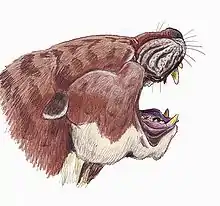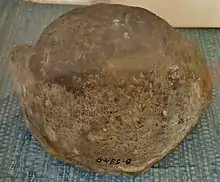Largest prehistoric animals
The largest prehistoric animals include both vertebrate and invertebrate species. Many of them are described below, along with their typical range of size (for the general dates of extinction, see the link to each). Many species mentioned might not actually be the largest representative of their clade due to the incompleteness of the fossil record and many of the sizes given are merely estimates since no complete specimen have been found. Their body mass, especially, is largely conjecture because soft tissue was rarely fossilized. Generally the size of extinct species was subject to energetic[1] and biomechanical constraints.[2]
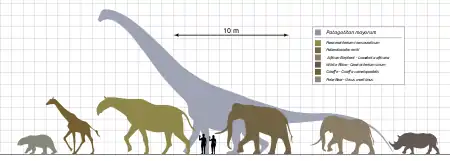
Non-mammalian synapsids (Synapsida)
Caseasaurs (Caseasauria)
The herbivorous Alierasaurus was the largest caseid and the largest amniote to have lived at the time, with an estimated length around 6–7 m (20–23 ft).[3] Cotylorhynchus hancocki is also large, with an estimated length and weight of at least 6 m (20 ft)[4] and more than 500 kg (1,100 lb).[5]
Edaphosaurids (Edaphosauridae)

The largest edaphosaurids were Lupeosaurus at 3 m (9.8 ft) long[6] and Edaphosaurus, which could reach even more than 3 m (9.8 ft) in length.[7]
Sphenacodontids (Sphenacodontidae)
The biggest carnivorous synapsid of Early Permian was Dimetrodon, which could reach 4.6 m (15 ft) and 250 kg (550 lb).[8] The largest members of the genus Dimetrodon were also the world's first fully terrestrial apex predators.[9]
Tappenosauridae
The Middle Permian Tappenosaurus was estimated at 5.5 m (18 ft) in length, nearly as large as the largest dinocephalians.[10]
Anomodonts (Anomodontia)
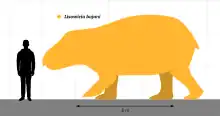
The plant-eating dicynodont Lisowicia bojani is the largest-known of all non-mammalian synapsids, at about 4.5 m (15 ft) long, 2.6 m (8 ft 6 in) tall, and 9,000 kg (20,000 lb) in body mass.[11][12][13]
Dinocephalians (Dinocephalia)
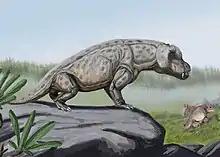
Among the largest carnivorous non-mammalian synapsids was the dinocephalian Anteosaurus, which was 5–6 m (16–20 ft) long, and weighed 500–600 kg (1,100–1,300 lb).[14][15] Fully grown Titanophoneus from the same family Anteosauridae likely had a skull of 1 m (3.3 ft) long.[15] Another enormous dinocephalian was the Late Permian Eotitanosuchus (a possible synonym to Biarmosuchus[16]). Adult specimens could reach 6 m (20 ft) in length and over 600 kg (1,300 lb) in weight.[16]
Gorgonopsians (Gorgonopsia)
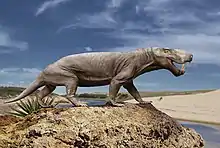
Inostrancevia latifrons is the largest known gorgonopsian, with a skull length of more than 60 cm (24 in), a total length approaching 3.5 m (11 ft) and a mass of 300 kg (660 lb).[17] Rubidgea atrox is the largest African gorgonopsian, with skull of nearly 45 cm (18 in) long.[18] Other large gorgonopsians include Dinogorgon with skull of ~40 cm (16 in) long,[19] Leontosaurus with skull of almost 40 cm (16 in) long,[18] and Sycosaurus with skull of ~38 cm (15 in) long.[18]
Therocephalians (Therocephalia)
The largest of therocephalians is Scymnosaurus,[20][21] which reached a size of the modern hyena.[22]
Non-mammalian cynodonts (Cynodontia)
- The largest known non-mammalian cynodont is Scalenodontoides, a traversodontid, which had a maximum skull length of approximately 61.7 centimetres (24.3 in) based on a fragmentary specimen.[23]
- Paceyodon davidi was the largest of morganucodontans, cynodonts close to mammals. It is known by a right lower molariform 3.3 mm (0.13 in) in length, which is bigger than molariforms of all other morganucodontans.[24]
- The largest known docodont was Castorocauda, almost 50 cm (20 in) in length.[25]
Mammals (Mammalia)
Gobiconodonts (Gobiconodonta)

The largest gobiconodont and the largest well-known Mesozoic mammal was Repenomamus.[26][27][28][29][30][31] The known adult of Repenomamus giganticus reached a total length of around 1 m (3 ft 3 in) and an estimated mass of 12–14 kg (26–31 lb).[28] With such parameters it surpassed in size several small theropod dinosaurs of the Early Cretaceous.[32] Gobiconodon was also a large mammal,[30][31] it weighed 5.4 kilograms (12 lb),[28] had a skull of 10 cm (3.9 in) in length, and had 35 cm (14 in) in presacral body length.[33]
Multituberculates (Multituberculata)
The largest multituberculate[34] Taeniolabis taoensis is the largest non-therian mammal known, at a weight possibly exceeding 100 kg (220 lb).[35]
Monotremes (Monotremata)

- The largest known monotreme (egg-laying mammal) ever was the extinct long-beaked echidna species known as Murrayglossus, known from a couple of bones found in Western Australia. It was the size of a sheep, weighing probably up to 30 kg (66 lb).[36]
- The largest known ornithorhynchid is Obdurodon tharalkooschild, it was even larger than 70 cm (28 in)-long Monotrematum sudamericanum.[37]
- Kollikodon was likely the largest monotreme in the Mesozoic. Its body length could be up to a 1 m (3 ft 3 in).[38]
Metatherians (Metatheria)
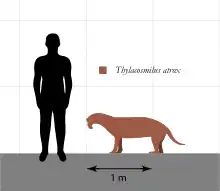
- The largest non-marsupial metatherian was Thylacosmilus, weigh 80 to 120 kilograms (180 to 260 lb),[39][40] one estimate suggesting even 150 kg (330 lb).[41] Proborhyaenid Proborhyaena gigantea is estimated to weigh over 50 kg (110 lb) and possibly reached 150 kg (330 lb).[42] Australohyaena is another large metatherian, weighing up to 70 kilograms (150 lb).[43]
- Stagodontid mammal Didelphodon was one of the largest Mesozoic metatherians and all Cretaceous mammals.[44] Its skull could reached over 10 centimetres (3.9 in) in length[45] and a weight of complete animal was 5.2 kilograms (11 lb).[46]
Marsupials (Marsupialia)
- The largest known marsupial, and the largest metatherian, is the extinct Diprotodon, about 3 m (9.8 ft) long, standing 2 m (6 ft 7 in) tall and weighing up to 2,786 kg (6,142 lb).[47] Fellow vombatiform Palorchestes azael was similar in length being around 2.5 m (8.2 ft), with body mass estimates indicating it could exceed 1,000 kg (2,200 lb).[48]
- The largest known carnivorous marsupial was Thylacoleo carnifex. Measurements taken from a number of specimens show they averaged 101 to 164 kg (223 to 362 lb) in weight.[49][50]
- The largest known kangaroo was an as yet unnamed species of Macropus, estimated to weigh 274 kg (604 lb),[51] larger than the largest known specimen of Procoptodon, which could grow up to 2 m (6 ft 7 in) and weigh 230 kg (510 lb).[52] Some species from the genus Sthenurus were similar in size or a bit larger than the extant grey kangaroo (Macropus giganteus).[53]
- The largest potoroid ever recorded was Borungaboodie, which was nearly 30% bigger than the largest living species and weighted up to 10 kg (22 lb).[54]
Non-placental eutherians
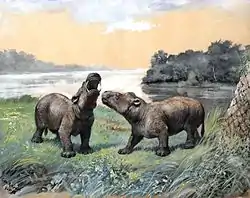
Cimolestans (Cimolesta)
The largest known cimolestan is Coryphodon, 1 m (3 ft 3 in) high at the shoulder, 2.5 m (8 ft 2 in) long[55][56] and up to 700 kg (1,500 lb) of mass.[57] Barylambda was also a huge mammal, at 650 kg (1,430 lb).[58] Wortmania and Psittacotherium from the group Taeniodonta were among the largest mammals of the Early Paleocene.[59] Lived as soon as half a million years after K–Pg boundary, Wortmania reached 20 kg (44 lb) in body mass. Psittacotherium, which appeared two million years later, reached 50 kg (110 lb).[59]
Leptictids (Leptictida)
The largest leptictid ever discovered is Leptictidium tobieni from the Middle Eocene of Germany. It had a skull 101 mm (4.0 in) long, head with trunk 375 mm (14.8 in) long, and tail 500 mm (20 in) long.[60] Close European relatives from the same family Pseudorhyncocyonidae had skulls of 67–101 mm (2.6–4.0 in) in length.[60]
Tenrecs and allies (Afroscida)
The larger of the two species of bibymalagasy (Plesiorycteropus madagascariensis), extinct tenrec relatives from Madagascar, is estimated to have weighed from 10 to 18 kilograms (21 to 40 lb).[61]
Even-toed ungulates (Artiodactyla)
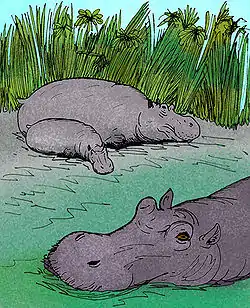
- The largest known land-dwelling artiodactyl was Hippopotamus gorgops with a length of 4.3 m (14 ft), a height of 2.1 m (6 ft 11 in), and a weight of 5 t (11,000 lb).[62]
- Daeodon and similar in size and morphology Paraentelodon[63] were the largest-known entelodonts that ever lived, at 3.7 m (12 ft) long and 1.77 m (5.8 ft) high at the shoulder.[64] The huge Andrewsarchus from the Eocene of Inner Mongolia had skull 83.4 cm (32.8 in) long[65] though the taxonomy of this genus is disputive.[66][67]
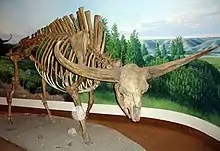
- The largest of Bovinae as well as the largest bovid was Bison latifrons. It reached a weight from 1,250 kg (2,760 lb)[68][69] to 2,000 kg (4,400 lb),[70] 4.75 m (15.6 ft) in length, shoulder height of 2.31 m (7.6 ft),[71] and had horns that spanned 2.13 m (7 ft 0 in).[72] The North American Bison antiquus reached up to 4.6 m (15 ft) long, 2.27 m (7.4 ft) tall, weight of 1,588 kg (3,501 lb),[73] and horn span of 1 m (3.3 ft).[71] The African Pelorovis reached 2 t (2.2 short tons) in weight and had bony cores of the horns about 1 m (3 ft 3 in) long.[74] Another enormous bovid, the african giant buffalo (Syncerus antiquus) reached 3 m (9.8 ft) in length from muzzle to the end of the tail, 1.85 m (6.1 ft) in height at the withers, 1.7 m (5.6 ft) in height at the hindquarters,[75][76] and the distance between the tips of its horns was as large as 2.4 m (7 ft 10 in).[75] Aside from local populations and subspecies of extant species, such as the gaur population in Sri Lanka, European bison in British Isles, Caucasian wisent and Carpathian wisent, the largest modern extinct bovid is aurochs (Bos primigenius) with an average height at the shoulders of 155–180 cm (61–71 in) in bulls and 135–155 cm (53–61 in) in cows, while aurochs populations in Hungary had bulls reaching 155–160 cm (61–63 in).[77] The kouprey (Bos sauveli), reaching 1.7–1.9 m (5 ft 7 in – 6 ft 3 in) in shoulder height,[78][79] has existed since the Middle Pleistocene[80] and is also considered to be possibly extinct.[81][82]
- The long-legged Megalotragus is possibly the largest known alcelaphine bovid,[83] bigger than the extant wildebeest.[84] The tips of horns of M. priscus were located at a distance of about 1.2 m (3 ft 11 in) from each other.[85]
- The extinct cervid Irish elk (Megaloceros giganteus) reached over 2.1 m (7 ft) in height, 680 kg (1,500 lb) in mass and could have antlers spanning up to 4.3 m (14 ft) across, about twice the maximum span for a moose's antlers.[86][87] The giant moose (Cervalces latifrons) reached 2.1 to 2.4 m (6.9 to 7.9 ft) high[88] and was twice as heavy as the Irish elk but its antler span at 2.5 m (8.2 ft) was smaller than that of Megaloceros.[89][90] North American stag-moose (Cervalces scotti) reached 2.5 metres (8.2 ft) in length and a weight of 708.5 kilograms (1,562 lb).[91][92]
- The largest known giraffid, aside from the extant giraffe, is Sivatherium, with a body weight of 1,250 kg (2,760 lb).[93]
- The largest protoceratid was Synthetoceras, it reached 2 m (6 ft 7 in) long and 150–200 kg (330–440 lb) in mass.[94][95]
- The largest known wild suid to ever exist was Kubanochoerus gigas, having measured up to 500 kg (1,100 lb) and stood around 1 m (3 ft 3 in) tall at the shoulder.[96] Megalochoerus could be similar in size, possibly weighing 303 kg (668 lb) or 526 kg (1,160 lb).[97]
- The largest tayassuid extinct Platygonus species were similar in size to modern peccaries especially giant peccary, at around 1 m (3.3 ft) in body length, and had long legs, allowing them to run well. They also had a pig-like snout and long tusks which were probably used to fend off predators.[98]
- The largest camelid was Titanotylopus from the Miocene of North America. It possibly reached 2,485.6 kg (5,480 lb) and a shoulder height of over 3.4 m (11 ft).[99][100] The Syrian camel (Camelus moreli) was twice as big as the modern camels.[101] It was 3 m (9.8 ft) at the shoulder[102] and 4 m (13 ft) tall.[101] Camelops had legs to be 20% longer than that of Dromedary, and was about 2.3 m (7 ft 7 in) tall at the shoulder and weighed about 1,000 kg (2,200 lb).[103]
Cetaceans (Cetacea)

- The heaviest archeocete, and possibly the heaviest known mammal was Perucetus, with weight estimated at around 85–340 t (84–335 long tons; 94–375 short tons), while length is estimated at 17.0–20.1 meters (55.8–65.9 ft).[104] The longest of known Eocene archeocete whales was Basilosaurus at 17–20 m (56–66 ft) in length.[105][106][107]
- The largest squalodelphinid was Macrosqualodelphis at 3.5 m (11 ft) in length.[108]
- Some Neogene rorquals were comparable in size to modern huge relatives. Parabalaenoptera was estimated to be about the size of the modern gray whale,[109] about 16 m (52 ft) long. Some balaenopterids perhaps rivaled the blue whale in terms of size,[109] though other studies disagree that any baleen whale grew that large in the Miocene.[110]
Odd-toed ungulates (Perissodactyla)
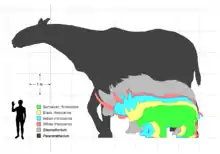

- The largest known perissodactyl, and the second largest land mammal (see Palaeoloxodon namadicus) of all time was the hornless rhino Paraceratherium. The largest individual known was estimated at 4.8 m (15.7 ft) tall at the shoulders, 7.4 m (24.3 ft) in length from nose to rump, and 17 t (18.7 short tons) in weight.[111][112]
- Some prehistoric horned rhinos also grew to large sizes. The biggest Elasmotherium reached up to 5–5.2 m (16–17 ft) long,[113] 2.5 m (8 ft 2 in) high[114] and weighed 3.5–5 t (3.9–5.5 short tons).[115][113][114] Such parameters make it the largest rhino of the Quaternary.[115] Woolly rhinoceros (Coelodonta antiquitatis) of the same time reached 1,100–1,500 kg (2,400–3,300 lb)[116] or 2,000 kg (4,400 lb),[117][118] 1.93 m (6 ft 4 in) at the shoulder height and 4.6 m (15 ft) in length.[119]
- Metamynodon, an amynodontid, reached 4 m (13 ft) in length, comparable to Hippopotamus in measurement and shape.[120]
- The giant tapir (Tapirus augustus) was the largest tapir ever, at about 623 kg (1,373 lb)[121] and 1 m (3.3 ft) tall at the shoulders.[122] Earlier, this mammal was estimated even bigger, at 1.5 m (4.9 ft) tall, and assigned to the separate genus Megatapirus.[122]
- One of the biggest chalicotheres was Moropus.[123] It stood about 2.4 metres (8 ft) tall at the shoulder.[124]
- Late Eocene perissodactyls from the family Brontotheriidae attained huge sizes. The North American Megacerops (also known as Brontotherium[125]) reached 2.5 m (8 ft 2 in) tall at the shoulders,[126] 5 m (16 ft) in length,[125] and 3 t (6,600 lb) in weight.[127] Embolotherium from Asia was equal in size.[128]
- The largest prehistoric horse was Equus giganteus of North America. It was estimated to grow to more than 1,250 kg (1.38 short tons) and 2 m (6 ft 7 in) at the shoulders.[129] The largest anchitherine equid was Hypohippus at 403 to 600 kg (888 to 1,323 lb), comparable to large modern domestic horses.[130][131] Megahippus is another large anchitheriine. With the body mass of 266.2 kg (587 lb) it was much heavier than most of its close relatives.[130]
Phenacodontids (Phenacodontidae)
The largest known phenacodontid is Phenacodus. It was 1.5 m (4 ft 11 in) long[132] and weighed up to 56 kg (123 lb).[133]
Dinoceratans (Dinocerata)
The largest known dinoceratan was Eobasileus with skull length of 102 cm (40 in), 2.1 m (6 ft 11 in) tall at the back and 1.5 m (4 ft 11 in) tall at the shoulder.[134] Another huge animal of this group was Uintatherium, with skull length of 76 cm (30 in), 1.5 m (4 ft 11 in) tall at the shoulder,[134] 4 m (13 ft) in length and 2.25 t (2.48 short tons), the size of a rhinoceros.[135] Despite their large size, Eobasileus as well as Uintatherium had a very small brain.[134][135]
Caniformia
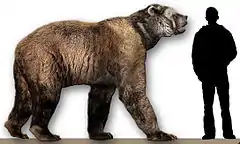
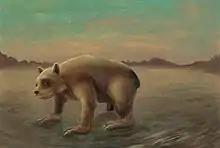

- The largest terrestrial mammalian carnivore and the largest known bear, as well as the largest known mammalian land predator of all time, was Arctotherium angustidens, the South American short-faced bear. A humerus of A. angustidens from Buenos Aires indicates that the males of the species could have weighed 1,588–1,749 kg (3,501–3,856 lb) and stood at least 3.4 m (11 ft) tall on their hind-limbs.[136][137] Another huge bear was the giant short-faced bear (Arctodus simus), with the average weight of 625 kg (1,378 lb) and the maximum estimated at 957 kg (2,110 lb).[138] There is a guess that the largest individuals of this species could reached even larger mass, up to 1,200 kg (2,600 lb).[139] The extinct cave bear (Ursus spelaeus) was also heavier than many recent bears. Largest males weighed as much as 1,000 kg (2,200 lb).[140] Ailuropoda baconi from the Pleistocene was larger than the modern giant panda (Ailuropoda melanoleuca).[141]
- The biggest odobenid and one of the biggest pinnipeds to have ever existed is Pontolis magnus, with skull length of 60 cm (24 in) (twice as large as the skulls of modern male walruses)[142] and more than 4 m (13 ft) in total body length.[143][144] Only the modern males of elephant seals (Mirounga) reaches the similar sizes.[143] The second largest prehistoric pinniped is Gomphotaria pugnax with the skull length of nearly 47 cm (19 in).[142]
- One of the largest of prehistoric otariids is Thalassoleon, comparable in size to the biggest extant fur seals. An estimated weight of T. mexicanus is no less than 295–318 kg (650–701 lb).[145]
- The biggest known mustelid to ever exist was likely the giant otter, Enhydriodon. It exceeded 3 m (9.8 ft) in length, and would have weighed in at around 200 kg (440 lb), much larger than any other known mustelid, living or extinct.[146][147][148] There were other giant otters, like Siamogale, at around 50 kg (110 lb)[149] and Megalenhydris, which was larger than a modern-day giant river otter.[150] Megalictis was the largest purely terrestrial mustelid[151] (although Enhydriodon had recently been mentioned as the largest mustelid that also happens to be a terrestrial predator[146]). Similar in size to the jaguar, Megalictis ferox had even wider skull, almost as wide as of the black bear.[151] Megalictis had a powerful bite force, allowing it to eat large prey and crush bones, as modern hyenas and jaguars can.[151] Another large-bodied mustelid was the superficially cat-like Ekorus from the Miocene of Africa. At almost 44 kg (97 lb), the long-legged Ekorus was about the size of a wolf[152] and filling a similar to leopards ecological niche before big cats came to the continent.[153] Other huge mustelids include Perunium[154] and hypercarnivorous Eomellivora, both from the Late Miocene.[155]
- The heaviest procyonid was possibly South American Chapalmalania. It reached 1.5 metres (4.9 ft) in body length with a short tail and 150 kilograms (330 lb), comparable in size to an American black bear (Ursus americanus).[156] Another huge procyonid was Cyonasua, which weighted about 15–25 kg (33–55 lb), about the same size as a medium-sized dog.[157]
- The largest canid of all time was Epicyon haydeni, which stood 90 cm (35 in) tall at the shoulder, had a body length of 2.4 m (7.9 ft) and weighed 100–125 kg (220–276 lb),[158][159][160] with the heaviest known specimen weighing up to 170 kg (370 lb).[41] The extinct dire wolf (Aenocyon dirus) reached 1.5 m (4 ft 11 in) in length and weighed between 50 and 110 kg (110 and 243 lb).[41][161] The largest wolf (Canis lupus) subspecies ever existed in Europe is the Canis lupus maximus from the Late Pleistocene of France. Its long bones are 10% larger than those of extant European wolves and 20% longer than those of C. l. lunellensis.[162] The Late Pleistocene Italian wolf was morphometrically close to C. l. maximus.[163]
- The largest bear-dog was a species of Pseudocyon weighing around 773 kg (1,704 lb), representing a very large individual.[164]
Feliformia

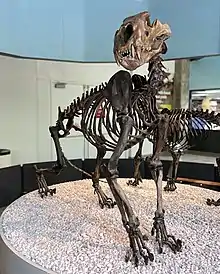
- The largest nimravid was probably Quercylurus major as its fossils suggest it was similar in size to the modern-day brown bear and was scansorial.[165] In 2021, Eusmilus was declared as the largest of the holplophonine nimravids, reaching the weight of nearly 111 kg (245 lb), comparable to a small African lion.[166] However, the largest Hoplophoneus was estimated at 160 kg (350 lb).[41]
- The biggest saber-toothed cats are Amphimachairodus kabir and Smilodon populator, with the males possibly reaching 350–490 kg (770–1,080 lb) and 220–450 kg (490–990 lb) respectively.[41][167][168] Another contender for the largest felid of all time is Machairodus. M. horribilis from China was estimated at 405 kg (893 lb)[169] while the North American M. lahayishupup weighed up to 410 kg (900 lb).[170][171][172] Xenosmilus was also a huge cat. It reached around 2 m (6.6 ft) long[173] and weighed around 300–350 kg (660–770 lb).[169]
- The heaviest known pantherine felids are the Ngangdong tiger (Panthera tigris soloensis), which are estimated to have weighed up to 486 kg (1,071 lb),[168] the American lion (Panthera atrox), weighing up to 363 kg (800 lb)[174][175] and the Eurasian cave lion (Panthera spelaea), weighing up to 339 kg (747 lb).[168] Being the ancestor of the modern jaguar,[176] Panthera gombaszoegensis was much larger, up to 150 kg (330 lb) in maximum weight.[176]
- Some extinct feline felids also surpassed their modern relatives in size. The Eurasian giant cheetah (Acinonyx pardinensis) reached 60–121 kg (132–267 lb), approximately twice as large as the modern cheetah.[177] The North American Pratifelis was larger than the extant cougar.[178]
- The largest barbourofelid was Barbourofelis fricki, with the shoulder height of 90 cm (35 in).[179]
- The largest viverrid known to have existed is Viverra leakeyi, which was around the size of a wolf or small leopard at 41 kg (90 lb).[180]
- The largest known fossil hyena is Pachycrocuta, estimated at 90–100 cm (35–39 in) at the shoulder[181] and 190 kg (420 lb) weight.[41] Another huge hyena with mass over 100 kg (220 lb) is the cave hyena. It is actually a subspecies of the African spotted hyena, which is at 10% smaller than the extinct cave hyena.[182]
- The percrocutid feliform, Dinocrocuta, was two or even three times as large as the extant spotted hyena, 160 or 240 kg (350 or 530 lb).[183]
- The extinct giant fossa (Cryptoprocta spelea) had a body mass in range from 17 kg (37 lb)[184] to 20 kg (44 lb),[185] much larger than the modern fossa weighs (up to 8.6 kg (19 lb) for adult males[186]).
Hyaenodonts (Hyaenodonta)
The largest hyaenodont was Simbakubwa at 1,500 kg (3,300 lb).[187] Another giant hyaenodont, Megistotherium reached 500 kg (1,100 lb)[41] and had a skull of 66.4 cm (26.1 in) in length.[188]
Oxyaenids (Oxyaenidae)
The largest known oxyaenid was Sarkastodon weighing in at 800 kg (1,800 lb).[41]
Mesonychians (Mesonychia)
Some mesonychians reached a size of a bear. Such large were Mongolonyx from Asia[189] and Ankalagon from North America.[190][191] Another large mesonychian is Harpagolestes with a skull length of a half a meter in some species.[189]
Bats (Chiroptera)
Found in Quaternary deposits of South and Central Americas, Desmodus draculae had a wingspan of 0.5 m (20 in) and a body mass of up to 60 g (2.1 oz). Such proportions make it the largest vampire bat that ever evolved.[192]
Hedgehogs, gymnures, shrews, and moles (Eulipotyphla)
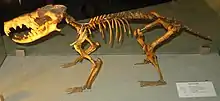
The largest known animal of the group Eulipotyphla was Deinogalerix,[193] measuring up to 60 cm (24 in) in total length, with a skull up to 21 cm (8.3 in) long.[194]
Rodents (Rodentia)

- Several of the extinct South American dinomyids were much bigger than the modern rodents. Josephoartigasia monesi was the largest-known rodent of all time, approximately weighing an estimated 480–500 kg (1,060–1,100 lb).[195] Phoberomys pattersoni weighed 125–150 kg (276–331 lb).[195] Both Josephoartigasia and Phoberomys reached about 1.5 m (4 ft 11 in) tall at the shoulder.[196] Another huge dinomyid, Telicomys gigantissimus had a minimal weight of 200 kg (440 lb).[196]
- Amblyrhiza inundata from the family Heptaxodontidae was a massive animal, it weighed 50–200 kg (110–440 lb).[197][196]
- The largest beaver was the giant beaver (Castoroides) of North America. It grew over 2 m in length and weighed roughly 90 to 125 kg (198 to 276 lb), also making it one of the largest rodents to ever exist.[198]
- The largest old world porcupine are the Hystrix refossa was larger than living porcupines. It was approximately 20% larger than its closest relative, the living Indian porcupine (H. indica), reaching lengths of over 115 cm (45 in).
Rabbits, hares, and pikas (Lagomorpha)
The biggest known prehistoric lagomorph is Minorcan giant lagomorph Nuralagus rex at 12 kg (26 lb).[199]
Pangolins (Pholidota)
The ever largest pangolin extinct Manis palaeojavanica [200] Its total length is measured up to 2.5 m (8.2 ft).[201]
Primates (Primates)

- The largest known primate as well as the largest hominid of all time was Gigantopithecus blackii, standing 3 m (9.8 ft) tall and weighing 540 kg (1,200 lb).[202][203] However In 2017, new studies suggested a body mass of 200–300 kg (440–660 lb) for this primate.[204] Another giant hominid was Meganthropus palaeojavanicus at 2.4 m (7 ft 10 in) in body height,[205] although it is known from very poor remains.[206]
- During the Pleistocene, some archaic humans were close in sizes or even larger than early modern humans. Neanderthals (Homo neanderthalensis) reached 77.6 kg (171 lb) and 66.4 kg (146 lb) in average weight for males and females, respectively, larger than the parameters of modern humans (Homo sapiens) (68.5 kg (151 lb) and 59.2 kg (131 lb) for males and females, respectively).[207] A tibia from Kabwe (Zambia) indicates an indeterminate Homo individual of possibly 181.2 cm (71.3 in) in height. It was one of the tallest humans of the Middle Pleistocene and noticeably large even compared to recent humans.[208] The tallest Homo sapiens individuals from the Middle Pleistocene of Spain reached 194 cm (76 in) and 174 cm (69 in) for males and females, respectively.[208] Some Homo erectus could be as large as 185 cm (73 in) tall and 68 kg (150 lb) in weight.[209][210]
- The largest known Old World monkey is the prehistoric baboon, with a male specimen of Dinopithecus projected to weigh an average of 46 kg (101 lb) and up to 57 kg (126 lb).[211] It exceeds the maximum weight record of the chacma baboon, the largest extant baboon. One source projects a specimen of Theropithecus oswaldi to have weighed 72 kg (159 lb).[212]
- The largest known New World monkey was Cartelles, which is studied as specimen of Protopithecus, weighing up to 34.27 kg (75.6 lb). Caipora bambuiorum is another large species, weighing up to 27.74 kg (61.2 lb).[213]
- The largest omomyids were Macrotarsius and Ourayia from the Middle Eocene. Both reached 1.5–2 kg (3.3–4.4 lb) in weight.[214]
- Some prehistoric lemuriform primates grew to huge sizes as well. Archaeoindris was a 1.5-metre-long (4.9 ft) sloth lemur that lived in Madagascar and weighed 150–187.8 kg (331–414 lb),[215] as large as an adult male gorilla.[216] Palaeopropithecus from the same family was also heavier than most modern lemurs, at 25.8–45.8 kg (57–101 lb).[217] Megaladapis is another large extinct lemur at 1.3 to 1.5 m (4 ft 3 in to 4 ft 11 in) in length and an average body mass of around 140 kg (310 lb).[218] Other estimates suggest 46.5–85.1 kg (103–188 lb) but its still much larger than any extant lemur.[217]
Elephants, mammoths, and mastodons (Proboscidea)
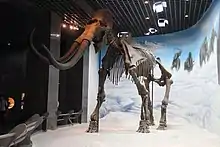
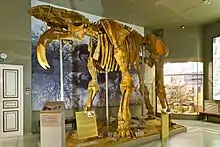
- The largest known land mammal ever was a proboscidean called Palaeoloxodon namadicus which weighed about 22 t (24.3 short tons) and measured about 5.2 m (17.1 ft) tall at the shoulder.[111] The largest individuals of the steppe mammoth of Eurasia (Mammuthus trogontherii) estimated to reach 4.5 m (14.8 ft) at the shoulders and 14.3 t (15.8 short tons) in weight.[111][219] Stegodon zdanskyi, the biggest species of Stegodon, was 13 t (14.3 short tons) in body mass.[111] Another one enormous proboscidean is Stegotetrabelodon syrticus, over 4 m (13 ft) in height and 11 to 12 t (12.1 to 13.2 short tons) in weight.[111] The Columbian mammoth (Mammuthus columbi) was about 4 m (13.1 ft) tall at the shoulder but didn't weigh as much as other huge mammoths. Its average mass was 9.5 t (10.5 short tons) with one unusually large specimen about 12.5 t (13.8 short tons).[111] Columbian mammoths had very long tusks. The largest known mammoth tusk, 4.9 m (16 ft) long, belonged to this species.[220]
- The largest mammutid was the Neogene Mammut borsoni. The biggest specimen reached 4.1 m (13 ft) tall and weighed about 16 t (17.6 short tons).[111] This species also had the longest tusks, 5.02 m (16.5 ft) long from basis to tip along the curve.[221]
- Deinotherium was the largest proboscidean in Deinotheriidae family. Bones retrieved in Crete confirm the existence of specimen 4.1 m (13 ft) tall at the shoulders and more than 14 t (15.4 short tons) in weight.[111]
Sea cows (Sirenia)
According to reports, Steller's sea cows have grown to 8 to 9 m (26 to 30 ft) long as adults, much larger than any extant sirenians.[222] The weight of Steller's sea cows is estimated to be 8–10 t (8.8–11.0 short tons).[223]
Arsinoitheres (Arsinoitheriidae)

The largest known arsinoitheriid was Arsinoitherium. A. zitteli would have been 1.75 m (5 ft 9 in) tall at the shoulders, and 3 m (9.8 ft) long.[224][225] A. giganteum reached even larger size than A. zitteli.[226]
Hyraxes (Hyracoidea)
Some of the prehistoric hyraxes were extremely large compared to modern small relatives. The largest hyracoid ever evolved is Titanohyrax ultimus.[227] With the mass estimation in rage of 600 kg (1,300 lb) to over 1,300 kg (2,900 lb) it was close in size to Sumatran rhinoceros.[228] Another enormous hyrax is Megalohyrax which had skull of 391 mm (15.4 in) in length[229] and reached the size of tapir.[230][227] More recent Gigantohyrax was three times as large as the extant relative Procavia capensis,[231] although it is noticeably smaller than earlier Megalohyrax and Titanohyrax.[232]
Desmostylians (Desmostylia)
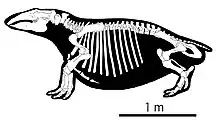
The largest known desmostylian was a species of Desmostylus, with skull length of 81.8 cm (32.2 in) and comparable in size to the Steller's sea cow.[233]
Paleoparadoxia is also known as one of the largest desmostylians, with body length of 3.03 m (9.9 ft).[234]
Armadillos, glyptodonts and pampatheres (Cingulata)
The largest cingulate known is Doedicurus, at 4 m (13 ft) long, 1.5 m (4 ft 11 in) high[135] and reaching a mass of approximately 1,910 to 2,370 kg (2.11 to 2.61 short tons). The largest species of Glyptodon, Glyptodon clavipes, reached 3–3.3 m (9.8–10.8 ft) in length[235][135] and 2 t (2.2 short tons) in weight.
Anteaters and sloths (Pilosa)
_Skeleton_(35662312784).jpg.webp)
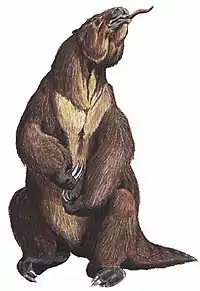
The largest known pilosan is Eremotherium, a ground sloth with an estimated weight of up to 6.55 t (7.22 short tons) and a length of up to 6 m (20 ft),[236] which is as big as a bull African bush elephant. The closely related ground sloth Megatherium attained similarly large dimensions.[237]
Astrapotherians (Astrapotheria)
Some of the largest known astrapotherians weighed about 3–4 t (3.3–4.4 short tons), including the genus Granastrapotherium[238] and some species of Parastrapotherium (P. martiale).[239] The skeleton remains suggests that the species Hilarcotherium miyou was even larger, with a weight of 6.456 t (7.117 short tons).[240]
Litopterns (Litopterna)
The largest known litoptern was Macrauchenia, which had three hoofs per foot. It was a relatively large animal, with a body length of around 3 m (9.8 ft).[241]
Notoungulates (Notoungulata)
The largest notoungulate known of complete remains is Toxodon. It was about 2.7 m (8 ft 10 in) in body length, and about 1.5 m (4 ft 11 in) high at the shoulder and resembled a heavy rhinoceros. Although incomplete, the preserved fossils suggests that Mixotoxodon were the most massive member of the group, with a weight about 3.8 t (4.2 short tons).[242]
Pyrotherians (Pyrotheria)
The largest mammal of the South American order Pyrotheria was Pyrotherium at 2.9–3.6 m (9 ft 6 in – 11 ft 10 in) in length and 1.8–3.5 t (4,000–7,700 lb) in weight.[243]
Reptiles (Reptilia)
Lizards and snakes (Squamata)
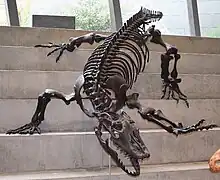
- Giant mosasaurs are the largest-known animals within the Squamata. The largest-known mosasaur is likely Mosasaurus hoffmanni, estimated at more than 17 m (56 ft) in length,[244][245] however these estimations are based on heads and total body length ratio 1:10, which is unlikely for Mosasaurus, and probably that ratio is about 1:7.[246] Another giant mosasaur is Tylosaurus, estimated at 10–14 m (33–46 ft) in length.[247][248] Another mosasaur, Prognathodon can reach similar size.
- The largest known prehistoric snake is Titanoboa cerrejonensis, estimated at 12.8 m (42 ft) in length and 1,135 kg (2,502 lb) in weight.[249] Another known very large fossil snake is Gigantophis garstini, estimated at 9.3–10.7 m (31–35 ft) in length,[250][251] although later study shows smaller estimation about 6.6–7.2 m (22–24 ft).[252] A close rival in size to Gigantophis is a fossil snake, Palaeophis colossaeus, which may have been around 9 m (30 ft) in length.[249][253][254] Later studies speculate that it reached a maximum length of 12.3 m (40 ft).[255] The largest fossil python is Liasis dubudingala with length roughly 9 m (30 ft).[256] The largest viper as well as the largest venomous snake ever recorded is Laophis crotaloides from the Early Pliocene of Greece. This snake reached over 3 m (9.8 ft) in length and 26 kg (57 lb) in weight.[257][258] Another huge fossil viper is indeterminate species of Vipera. With a length of around 2 m (6 ft 7 in) it was one of the biggest predators of Mallorca during the Early Pliocene.[259] The largest known blind snake is Boipeba tayasuensis with estimated total length of 1.1 m (3 ft 7 in).[260]
- The largest known land lizard is probably megalania (Varanus priscus) at 7 m (23 ft) in length.[261] As extant relatives, megalania could have been venomous and in that case this lizard was also the largest venomous vertebrate ever evolved.[262] However, maximum size of this animal is subject to debate.[263]
Turtles, tortoises and close relatives (Pantestudines)
Cryptodira
- The largest known turtle ever was Archelon ischyros at 5 m (16 ft) long and 2,200 kg (4,900 lb).[264] Possible second-largest sea turtle was Protostega at 3.9 m (13 ft) in total body length.[265][266] There is even a larger specimen of this genus from Texas estimated at 4.2 m (14 ft) in total length.[267][265] Partially known Cratochelone is estimated to reach 4 m (13 ft) in total length.[268] Another huge prehistoric sea turtle is the Late Cretaceous Gigantatypus, estimated at over 3.5 m (11 ft) in length.[269] Psephophorus terrypratchetti from the Eocene attained 2.3–2.5 m (7.5–8.2 ft) in body length.[270]
- The largest tortoise was Megalochelys atlas at up to 2.7 m (9 ft) in shell length[271] and weighing 0.8–1.0 t (1,800–2,200 lb).[127] M. margae had carapace of 1.4–2 m (4.6–6.6 ft) long; an unnamed species from Java reached at least 1.75 m (5.7 ft) in carapace length.[272] The Cenozoic Titanochelon were also larger than extant giant tortoises, with a shell length of up to 2 m (6 ft 7 in).[273][274] Other giant tortoises include Centrochelys marocana at 1.8–2 m (5.9–6.6 ft) in carapace length and Mesoamerican Hesperotestudo sp. at 1.5 m (4.9 ft) in carapace length.[272]
- The largest trionychid ever recorded is indeterminate specimen GSP-UM 3019 from the Middle Eocene of Pakistan. Bony carapace of GSP-UM 3019 is 120 cm (3.9 ft) long and 110 cm (3.6 ft) wide indicates the total carapace diameter (with soft margin) about 2 m (6.6 ft).[275] Drazinderetes tethyensis from the same formation had a bony carapace 80 cm (2.6 ft) long and 70 cm (2.3 ft) wide.[275] Another huge trionychid is North American Axestemys byssinus at over 2 m (6.6 ft) in total length.[276]
Side-necked turtles (Pleurodira)
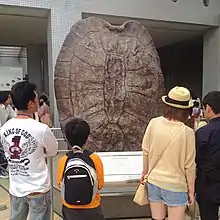
The largest freshwater turtle of all time was the Miocene podocnemid Stupendemys, with an estimated parasagittal carapace length of 2.86 m (9 ft 5 in) and weight of up to 1,145 kg (2,524 lb).[277] Carbonemys cofrinii from the same family had a shell that measured about 1.72 m (5 ft 8 in),[278][279][280] complete shell was estimated at 1.8 m (5.9 ft).[281]
Macrobaenids (Macrobaenidae)
The largest macrobaenids were the Early Cretaceous Yakemys, Late Cretaceous Anatolemys, and Paleocene Judithemys. All reached 70 cm (2.3 ft) in carapace length.[282]
Meiolaniformes
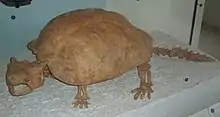
The largest meiolaniid was Meiolania. Meiolania platyceps had a carapace 100 cm (3.3 ft) long[272] and probably reached over 3 m (9.8 ft) in total body length.[283] An unnamed Late Pleistocene species from Queensland was even larger, up to 200 cm (6.6 ft) in carapace length.[272] Ninjemys oweni reached 100 cm (3.3 ft) in carapace length[272] and 200 kg (440 lb) in weight.[284]
Placodonts and close relatives (Placodontiformes)
Placodus was among the largest placodonts, with a length of up to 3 m (9.8 ft).[285]
Nothosaurs and close relatives (Nothosauroidea)
The largest nothosaur as well as the largest Triassic sauropterygian was Nothosaurus giganteus at 7 m (23 ft) in length.[286]
Plesiosaurs (Plesiosauria)
- The largest known plesiosauroid was an indeterminate specimen possibly belonging to Aristonectes (identified as cf. Aristonectes sp.), with a body length of 11–11.9 metres (36–39 ft) and body mass of 10.7–13.5 metric tons (11.8–14.9 short tons).[287] Another long plesiosauroid was Albertonectes at 11.2–11.6 metres (37–38 ft).[288] Thalassomedon rivaled it in size, with its length at 10.86–11.6 m (35.6–38.1 ft).[289] Other large plesiosauroids are Styxosaurus and Elasmosaurus. Both reached some more than 10 m (33 ft) in length.[290][291] Hydralmosaurus (previously synonymized with Elasmosaurus and Styxosaurus) reached 9.44 m (31.0 ft) in total body length.[291] In past, Mauisaurus was considered to be more than 8 m (26 ft) in length,[292][291] but later it was determined as nomen dubium.[293]

- There is much controversy over the largest-known of the Pliosauroidea. Pliosaurus funkei (also known as "Predator X") is a species of large pliosaur, known from remains discovered in Norway in 2008. This pliosaur has been estimated at 10–13 m (33–43 ft) in length.[294] However, in 2002, a team of paleontologists in Mexico discovered the remains of a pliosaur nicknamed as "Monster of Aramberri", which is also estimated at 15 m (49 ft) in length,[295] with shorter estimation about 11.5 m (38 ft).[296] This species is, however, claimed to be a juvenile and has been attacked by a larger pliosaur.[297] Some media sources claimed that Monster of Aramberri was a Liopleurodon but its species is unconfirmed thus far.[295] Another very large pliosaur was Pliosaurus macromerus, known from a single 2.8-metre-long (9.2 ft) incomplete mandible.[298] The Early Cretaceous Kronosaurus queenslandicus is estimated at 9–10.9 m (30–36 ft) in length and 10.6–12.1 t (11.7–13.3 short tons) in weight.[299][300] The Late Jurassic Megalneusaurus rex could reach lengths of 7.6–9.1 metres (25–30 ft).[301][302] Close contender in size was the Late Cretaceous Megacephalosaurus eulerti with a length in range of 6–9 m (20–30 ft).[303]
Proterosuchids (Proterosuchidae)
Proterosuchus fergusi is the largest known proterosuchid with a skull length of 47.7 cm (18.8 in) and a possible body length of 3.5–4 m (11–13 ft).[304]
Erythrosuchids (Erythrosuchidae)
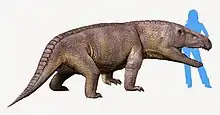
The largest erythrosuchid was Erythrosuchus africanus with a maximum length of 4.75–5 m (15.6–16.4 ft).[305]
Phytosaurs (Phytosauria)
Some of the largest known phytosaurs include Redondasaurus with a length of 6.4 m (21 ft)[306] and Smilosuchus with a length of more than 7 m (23 ft).[307]
Non-crocodylomorph pseudosuchians (Pseudosuchia)

- The largest shuvosaurid and one of the largest pseudosuchian from the Triassic period was Sillosuchus. Biggest specimens could have reached 9–10 m (30–33 ft) in length.[308][309]
- The largest known carnivorous pseudosuchian of the Triassic is loricatan Fasolasuchus tenax, which measured an estimated of 8 to 10 m (26 to 33 ft).[310][308][309] It is both the largest "rauisuchian" known to science, and the largest non-dinosaurian terrestrial predator ever discovered. Biggest individuals of Postosuchus[311] and Saurosuchus[312] had a body length of around 7 m (23 ft). A specimen of Prestosuchus discovered in 2010 suggest that this animal also reached lengths of nearly 7 m (23 ft) making it one of the largest Triassic pseudosuchians.[313]
- Desmatosuchus was likely one of the largest known aetosaurs, about 4–6 m (13–20 ft) in length and 280 kg (620 lb) in weight.[314][315][316]
Crocodiles and close relatives (Crocodylomorpha)

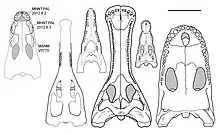
Aegyptosuchids (Aegyptosuchidae)
The Late Cretaceous Aegisuchus is the main contender for the title of the largest crocodylomorph ever recorded. It reached 15 m (49 ft) in length by the lower estimate and as much as 22 m (72 ft) by the upper estimate,[317] although a length of over 15 m is likely an overestimate.[317]
Crocodylians (Crocodylia)
- The largest caiman and likely the largest crocodylian was Purussaurus brasiliensis estimated at 11–13 m (36–43 ft).[318] According to another information, maximum estimate measure 11.4 m (37 ft) and almost 7.8 t (8.6 short tons) in length and in weight respectively.[319] Another giant caiman was Mourasuchus. Various estimates suggest the biggest specimens reached 9.47 m (31.1 ft) in length and 8.5 t (9.4 short tons) in weight[320] or 4.7–5.98 m (15.4–19.6 ft) in body length.[321]
- The largest alligatoroid is likely Deinosuchus riograndensis at 12 m (39 ft) long and weighing 8.5 t (9.4 short tons).[322][323]
- The largest extinct species of the genus Alligator was the Haile alligator (Alligator hailensis), which had a skull 52.5 cm (20.7 in) long and was similar in size to the extant American alligator (Alligator mississippiensis).[324]
- The largest gavialids were Asian Rhamphosuchus at 8–11 m (26–36 ft)[325][326][319] and South American Gryposuchus at 10.15 m (33.3 ft) in length.[327][326]
- The basal crocodyloidean Astorgosuchus bugtiensis from the Oligocene was large. It estimated at 8 m (26 ft) in length.[326]
- The largest known true crocodile was Euthecodon which estimated to have reached 6.4–8.6 m (21–28 ft) or even 10 m (33 ft) long.[328][319] The largest species of the modern Crocodylus were Kenyan Crocodylus thorbjarnarsoni at 7.56 m (24.8 ft) in length,[329][319] Tanzanian Crocodylus anthropophagus at 7.5 m (25 ft) in length[330][331] and indeterminate species from Kali Gedeh (Java) at 6–7 m (20–23 ft) in length.[332]
- Unnamed Pliocene species of Quinkana known from partial remains may have reached up to 6 m (20 ft) in length, although other species (known from Oligocene to Pleistocene) are smaller with length just about 3 m (9.8 ft). It is not only the largest mekosuchian (some studies reject it from this group[333]) but also it could have been Australia's largest Pliocene predator.[261] Paludirex is another large mekosuchian with length over 4 m (13 ft).[334]
Paralligatorids (Paralligatoridae)
The largest paralligatorid was likely Kansajsuchus estimated at up to 8 m (26 ft) long.[335]
Tethysuchians (Tethysuchia)
- Some extinct pholidosaurids reached giant sizes. In the past, the Sarcosuchus imperator was believed to be the largest crocodylomorph, with initial estimates proposing a length of 12 m (39 ft) and a weight of 8 t (8.8 short tons).[336] However, recent estimates have now shrunk to a length of 9 to 9.5 m (29.5 to 31.2 ft) and a weight of 3.5 to 4.3 metric tons (3.9 to 4.7 short tons).[337] Related to Sarcosuchus, Chalawan thailandicus could reached more than 10 m (33 ft) in length,[338] although other estimates suggest 7–8 m (23–26 ft).[326]
- The largest dyrosaurid was Phosphatosaurus gavialoides estimated at 9 m (30 ft) in length.[339][326]
Stomatosuchids (Stomatosuchidae)
Stomatosuchus, a stomatosuchid, estimated at 10 m (33 ft) in length.[340]
Notosuchians (Notosuchia)
- Some of largest terrestrial notosuchian crocodylomorphs were the Miocene sebecid Barinasuchus, with a skull of 95–110 cm (37–43 in) long, and Eocene sebecid Dentaneosuchus with estimated mandible length of 1 m (3.3 ft).[341][342] Various estimates suggest a possible length of these animals between 3–10 m (9.8–32.8 ft). Using proportion of Stratiotosuchus which is also large to have 47 cm (19 in) long skull,[343] Barinasuchus is estimated to have length at least 6.3 m (21 ft).[341][342]
- Other huge notosuchian, although only known from fragmentary material, is an early member Razanandrongobe, which skull size may exceeded that of Barinasuchus and overall length may be around 7 m (23 ft).[344][345]
Thalattosuchians (Thalattosuchia)
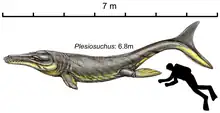
- The largest thalattosuchian as well as the largest teleosauroid was unnamed fossil remain from Paja Formation, which may belongs to animal with length of 9.6 m (31 ft),[346] which is as large as outdated length estimate of the Early Cretaceous Machimosaurus rex, more recently estimated at 7.15 m (23.5 ft) in length.[347] Neosteneosaurus edwardsi (previously known as Steneosaurus edwardsi[348]) was the biggest Middle Jurassic crocodylomorph, it reached 6.6 m (22 ft) long.[347]
- Plesiosuchus was very large metriorhynchid. With the length of 6.83 m (22.4 ft) it exceeded even some pliosaurids of the same time and locality such as Liopleurodon.[349] Other huge metriorhynchids include Tyrannoneustes at 5 m (16 ft) in length[350] and Torvoneustes at 4.7 m (15 ft) in length.[351]
Basal crocodylomorphs
Redondavenator was the largest Triassic crocodylomorph ever recorded,[352] with a skull of at least 60 cm (2.0 ft) in length.[353][354] Another huge basal crocodylomorph was Carnufex[352] at 3 m (9.8 ft) long even through that is immature.[355]
Pterosaurs (Pterosauria)

- The largest known pterosaur was Quetzalcoatlus northropi, at 127 kg (280 lb) and with a wingspan of 10–12 m (33–39 ft).[356] Another close contender is Hatzegopteryx, also with a wingspan of 12 m (39 ft) or more.[356] This estimate is based on a skull 3 m (9.8 ft) long.[357] Yet another possible contender for the title is Cryodrakon which had a 10-metre (33 ft) wingspan.[358] An unnamed pterodactyloid pterosaur from the Nemegt Formation could reach a wingspan of nearly 10 m (33 ft).[359][360] According to various assumptions, the wingspan of Arambourgiania philadelphiae reached from 8 m (26 ft) to more than 10 m (33 ft).[359][358] South American Tropeognathus reached the maximum wingspan of 8.7 m (29 ft).[361][362]
- The largest of non-pterodactyloid pterosaurs as well as the largest Jurassic pterosaur[363] was Dearc, with an estimated wingspan between 2.2 m (7 ft 3 in) and 3.8 m (12 ft).[364] Only a fragmentary rhamphorhynchid specimen from Germany could be larger (184% the size of the biggest Rhamphorhynchus).[365] Other large non-pterodactyloid pterosaurs were Sericipterus, Campylognathoides and Harpactognathus, with the wingspan of 1.73 m (5 ft 8 in),[366] 1.75 m (5 ft 9 in),[366] and 2.5 m (8 ft 2 in),[365] respectively.
Choristoderes (Choristodera)
The largest known choristoderan, Kosmodraco dakotensis (previously known as Simoedosaurus dakotensis[367]) is estimated to have had a total length of around 5 m (16 ft).[368][367]
Tanystropheids (Tanystropheidae)

Tanystropheus, the largest of all tanystropheids, reached up to 5 m (16 ft) in length.[369]
Thalattosaurs (Thalattosauria)
The largest species of thalattosaur, Miodentosaurus brevis grew to more than 4 m (13 ft) in length.[370] The second largest member of this group is Concavispina with a length of 3.64 m (11.9 ft).[371]
Ichthyosaurs (Ichthyosauria)

The largest known ichthyosaur and the largest marine reptile was the Late Triassic Shastasaurus sikanniensis at 21 m (69 ft) in length[372][373] and 81.5 t (180,000 lb) in weight.[374] In April 2018, paleontologists announced the discovery of a previously unknown ichthyosaur that may have reached lengths of 26 m (85 ft) making it one of the largest animals known, rivaling some blue whales in size.[375][376] Another, larger ichthyosaur was found in 1850 in Aust.[377] Its remains seemed to surpass the measurements of the other ichthyosaur, but the researchers commented that the remains were too fragmentary for a size estimate to be made.[377] Another huge ichthyosaur was Shonisaurus popularis at 15 m (49 ft) in length and 29.7 t (65,000 lb) in weight.[373] The largest Middle Triassic ichthyosaur as well as the largest animal of that time was Cymbospondylus youngorum at 14 to 17.65 m (45.9 to 57.9 ft) in length[378][374] and 14.7 to 135.8 t (32,000 to 299,000 lb) in weight.[374]
Tangasaurids (Tangasauridae)
The largest tangasaurid was Hovasaurus with an estimated snout-vent length of 30–35 cm (12–14 in) and a tail of 60 cm (24 in).[379]
Pareiasaurs (Pareiasauria)
Largest pareiasaurs reached up to 3 m (9.8 ft) in length. Such sizes had Middle Permian Bradysaurus, Embrithosaurus, and Nochelesaurus from South Africa,[380] and the Late Permian Scutosaurus from Russia.[380] The most robust Scutosaurus had 1.16 t (2,600 lb) in body mass.[380]
Captorhinids (Captorhinidae)
The heavy built Moradisaurus grandis, with a length of 2 m (6 ft 7 in),[381] is the largest known captorhinid.[382] The second largest captorhinid was Labidosaurikos with the largest adult skull specimen 28 cm (11 in) long.[383]
Non-avian dinosaurs (Dinosauria)
Sauropodomorphs (Sauropodomorpha)
The largest of non-sauropod sauropodomorphs ("prosauropod") was Euskelosaurus. It reached 12.2 m (40 ft) in length and 2 t (2.2 short tons) in weight.[384] Another huge sauropodomorph Yunnanosaurus youngi reached 13 m (43 ft) long.[385]
Sauropods (Sauropoda)

- A mega-sauropod, Maraapunisaurus fragillimus (previously known as Amphicoelias fragillimus), is a contender for the largest-known dinosaur in history. It has been estimated at 58–60 m (190–197 ft) in maximum length and 122,400 kg (269,800 lb) in weight.[386] Unfortunately, the fossil remains of this dinosaur have been lost.[386] More recently, it was estimated at 35–40 m (115–131 ft) in length and 80–120 t (180,000–260,000 lb) in weight.[387]
- Known from the incomplete and now disintegrated remains, the Late Cretaceous Bruhathkayosaurus matleyi was an anomalously large sauropod.[388] Informal estimations suggested as huge parameters as 45 m (148 ft) in length and 139–220 t (306,000–485,000 lb) in weight.[389] Some estimation however, suggests 37 m (121 ft) and 95 t (209,000 lb) but it still much heavier than most other sauropods.[389] More recent estimations by Gregory Paul in 2023 has placed its weight range around 110 t (240,000 lb) to a 170 t (370,000 lb). If true, it would make Bruhathkayosaurus the single largest terrestrial animal to have walked the earth and would have rivalled the largest Blue Whale recorded.[390]
- BYU 9024, a massive cervical vertebra found in Utah,[391] may belong to Barosaurus lentus[392][393] or Supersaurus vivianae[394] of a huge size, possibly 45–48 m (148–157 ft) in length and 60–66 t (132,000–146,000 lb) in body mass.[395][393] Supersaurus vivianae itself may have been the longest dinosaur yet discovered as a study of 3 specimens suggested length of 39 m (128 ft) or over 40 m (130 ft).[394]
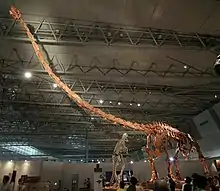
- Mamenchisaurus sinocanadorum was likely the largest mamenchisaurid, reaching nearly 35 m (115 ft) in length and 60–80 t (130,000–180,000 lb) in weight.[387] Xinjiangtitan shanshanesis from the same family had 15 m (49 ft)-long neck, about 55% of its total length that could be at least 27 m (89 ft).[396]
- The Middle Jurassic Breviparopus taghbaloutensis was mentioned in The Guinness Book of Records as the longest dinosaur at 48 m (157 ft) although this animal is known only from fossil tracks.[397][398] Originally thought to be a brachiosaurid, it was later identified as a huge diplodocoid, possibly 33.5 m (110 ft) in length and 62 t (137,000 lb) in weight.[399]

- The tallest sauropod was Sauroposeidon proteles with estimated height at 16.5–18 m (54–59 ft).[400][401][402] Asiatosaurus could reach 17.5 m (57 ft) in height but this animal is known only from teeth.[402] Giraffatitan was estimated at 16 m (52 ft) in height.[403]
Other huge sauropods include Argentinosaurus, Alamosaurus, and Puertasaurus with estimated lengths of 30–33 m (98–108 ft) and weights of 50–80 t (55–88 short tons).[404] Patagotitan was estimated at 37 m (121 ft) in length[405] and 57 t (63 short tons) in average weight,[406] and was similar in size to Argentinosaurus and Puertasaurus.[407] Giant sauropods like Supersaurus, Sauroposeidon, and Diplodocus probably rivaled them in length but not in weight.[386] Dreadnoughtus was estimated at 49 t (108,000 lb) in weight[406] and 26 m (85 ft) in length but the most complete individual was immature when it died.[408] Turiasaurus is considered of being the largest dinosaur from Europe,[409][410] with an estimated length of 30 m (98 ft) and a weight of 50 t (55 short tons).[404][410] However, with lower estimate at 21 m (69 ft) and 30 t (66,000 lb) it was smaller than Portuguese Lusotitan that reached 24 m (79 ft) in length and 34 t (75,000 lb) in weight.[411]
Many large sauropods are still unnamed and may rival the current record holders:
- The "Archbishop", a large brachiosaur that was discovered in 1930. As of October 2023, a scientific paper on the specimen is still in progress.[412]
- Brachiosaurus nougaredi is yet another large brachiosaur from Early Cretaceous North Africa. The remains have been lost, but the sacrum drawing remains. It suggests a sacrum of almost 1.3 m (4.3 ft) long,[413] making it the largest dinosaur sacrum discovered so far, except those of Argentinosaurus and Apatosaurus.[414]
- In 2010, the femur of a large sauropod was discovered in France. The femur suggests an animal that grew to immense sizes.[415]
Non-avian theropods (Theropoda)

- The largest theropod as well as the largest terrestrial (or possibly semi-aquatic)[416] predator yet known is Spinosaurus aegyptiacus, with the largest specimen known estimated at 12.6–18 m (41–59 ft) in length and around 7–20.9 t (8–23 short tons) in weight.[417][418] New estimates published in 2014 and 2018, based on a more complete specimen supported that Spinosaurus could reach lengths of 15 to 16 meters (49 to 52 ft).[419][420][421] The latest estimates suggest a weight of 6.4 to 7.5 metric tons (7.1 to 8.3 short tons).[420][421] The White Rock spinosaurid had vertebrae comparable in dimensions to Spinosaurus, it was likely a huge theropod with a length over 10 m (33 ft).[422]
- Other large theropods were Giganotosaurus carolinii, and Tyrannosaurus rex, whose largest specimens known estimated at 13.2 m (43 ft)[423] and 12.3 m (40 ft)[424] in length, and weigh between 4.2 to 13.8 t (4.6 to 15.2 short tons)[425][426][427][417] and 4.5 metric tons (5.0 short tons)[428][429] to over 7.2 metric tons (7.9 short tons),[424] respectively. Some other notable giant theropods (e.g. Carcharodontosaurus, Acrocanthosaurus, and Mapusaurus) may also have rivaled them in size.
- Macroelongatoolithus, ranging from 34–61 cm (1.12–2.00 ft) in length,[430] is the largest known type of dinosaur egg.[431] It is assigned to oviraptorosaurs like Beibeilong.[431]
Armoured dinosaurs (Thyreophora)
The largest-known thyreophoran was Ankylosaurus at 9 m (30 ft) in length and 6 tonnes (6.6 short tons) in weight.[432][433] Stegosaurus was also 9 m (30 ft) long[410] but around 5 tonnes (5.5 short tons) tonnes in weight.
Pachycephalosaurs (Pachycephalosauria)
The largest pachycephalosaur was the eponymous Pachycephalosaurus. Previously claimed to be at 7 m (23 ft) in length,[410] it was later estimated about 4.5 metres (14.8 ft) long and a weight of about 450 kilograms (990 lb).[434]
Ceratopsians (Ceratopsia)

The largest ceratopsian known is Triceratops horridus, along with the closely related Eotriceratops xerinsularis both with estimated lengths of 9 m (30 ft). Pentaceratops and several other ceratopsians rival them in size.[435] Titanoceratops had one of the longest skull of any land animal, at 2.65 m (8.7 ft) long.[436]
Ornithopods (Ornithopoda)
- The very largest known ornithopods, like Shantungosaurus were as heavy as medium-sized sauropods at up to 23 t (25 short tons),[437][438] and 16.6 m (54 ft) in length.[437] Magnapaulia reached 12.5 m (41 ft) in length,[439] or, according to original description, even 15 m (49 ft).[440][410] The Mongolian Saurolophus, S. angustirostris, reached 13 m (43 ft) long and possibly more.[441] Such animal could weighed up to 11 t (12 short tons).[441] The largest Edmontosaurus reached 12 m (39 ft) in length and around 6 t (6.6 short tons) in body mass.[442] An estimated maximum length of Brachylophosaurus is 11 m (36 ft) resulting in weight of 7 t (7.7 short tons).[443] PASAC-1, informally named "Sabinosaurus", is the largest well-known North American saurolophine,[444] around 11 m (36 ft) long, that is about 20% larger than other known specimens.[445] Hypsibema missouriensis was up to 10.7 m (35 ft) long.[446][447] The Late Cretaceous Charonosaurus was estimated around 10 m (33 ft) in length and 5 t (5.5 short tons) in weight.[410][448]
- The largest ornithopod outside of Hadrosauroidea was likely the Iguanodon. Biggest specimens reached 11 m (36 ft) in length[449][450] and weighed around 4.5 t (5.0 short tons).[451] Another large ornithopod is Iguanacolossus, with 9 m (30 ft) in length and 5 t (5.5 short tons) in weight.[452][453]
- The largest rhabdodontid was Matheronodon, estimated at 4.8 m (16 ft) in length.[454] Rhabdodon reached approximately 4 m (13 ft) and 250 kg (550 lb) according to 2016 estimates.[455]
Birds (Aves)

The largest bird in the fossil record may be the extinct Giant elephant bird (Aepyornis maximus) of Madagascar, whose closest living relative is the kiwi. Giant elephant birds exceeded 2.3 metres (7.5 ft) in height, and average a mass of 850 kg (1,870 lb)
The largest fowl was the Stirton's mihirung (Dromornis stirtoni) of Australia, part of a group called mihirungs of the family Dromornithidae, Stirton's mihirung exceeded 2.7 m (8.9 ft) in height, and average a mass of 500 kilograms (1,100 lb)[457]
The largest carnivorous bird was the Thunderbird (Brontornis burmeisteri), an extinct flightless bird from South America which reached a weight of 319 kg (703 lb) and a height of approximately 2.8 metres (9.2 ft).[458]
The tallest recorded bird was the Giant ostrich (Pachystruthio dmanisensis), part of the ostrich family. This particular species of ostrich stood at 3.5 metres (11.5 ft) tall and average a mass of 450 kg (990 lb)[459]
The largest Neoaves was the Brazilian terror bird (Paraphysornis brasiliensis) of South America, Brazilian terror bird exceeded 240 kg (530 lb) in mass,[460]
Table of heaviest extinct bird species
Enantiornitheans (Enantiornithes)
One of the largest enantiornitheans was Enantiornis,[481] with a length in life of around 78.5 cm (30.9 in), hip height of 34 cm (13 in), weight of 6.75 kg (14.9 lb),[482] and wingspan comparable to some of the modern gulls, around 1.2 m (3 ft 11 in).[481] Gurilynia was the largest Mesozoic bird from Mongolia, with a length of 53 cm (21 in), hip height of 23.2 cm (9.1 in), and weight of 2.1 kg (4.6 lb).[482]
Avisauridae
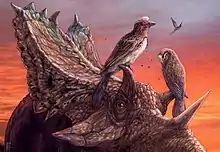
The Late Cretaceous Avisaurus was almost as large as Enantiornis. It had a wingspan around 1.2 m (3 ft 11 in),[481] a length of 72 cm (28 in), hip height of 31.5 cm (12.4 in), and weight of 5.1 kg (11 lb).[482] Even larger could be the Soroavisaurus. One tibiotarsus (PVL-4033) indicates an animal with a length of 80 cm (31 in), hip height of 35 cm (14 in), and weight of 7.25 kg (16.0 lb).[482] Mirarce was comparable in size to a turkey, much larger than most of other enantiornitheans.[483]
Pengornithidae
One of the biggest Early Cretaceous enantiornithine bird was Pengornis at 50 cm (1.6 ft) in length[410] and skull length of 54.7 mm (2.15 in).[484]
Gargantuaviidae
Gargantuavis is the largest known bird of the Mesozoic, a size ranging between the cassowary and the ostrich, and a mass of 140 kg (310 lb) like modern ostriches.[485] In 2019 specimens MDE A-08 and IVPP-V12325 were measured at 1.8 m (5 ft 11 in) in length, 1.3 m (4 ft 3 in) in hip height, and 120 kg (260 lb) in weight.[467]
Dromornithiformes
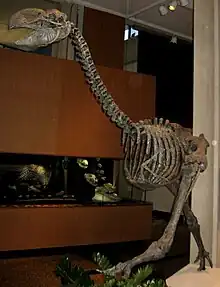
The largest dromornithid was Dromornis stirtoni over 3 m (9.8 ft) tall[486] and 528–584 kg (1,164–1,287 lb) in mass for males.[487]
Gastornid (Gastornithiformes)
Large individuals of Gastornis (also known as Diatryma) reaged up to 2 m (6 ft 7 in) in height.[488] Weight of Gastornis ranges from 100 kg (220 lb) to 156 kg (344 lb) and sometimes to 180 kg (400 lb) for European specimens and from 160 kg (350 lb) to 229 kg (505 lb) for North American.[489][465][490]
Waterfowl (Anseriformes)
.jpg.webp)
Possibly flightless, the Miocene Garganornis ballmanni was larger than any extant members of Anseriformes, with 15.3–22.3 kg (34–49 lb) in body mass.[491] Another huge anseriform was the flightless New Zealand goose (Cnemiornis). It reached 15–18 kg (33–40 lb), approaching in size to small species of moa.[492]
Swans (Cygnini)
The largest swan of ever evolved was the Pleistocene giant swan (Cygnus falconeri), it reached bill-to-tail length of about 190–210 cm (75–83 in),[493] weighed around 16 kg (35 lb) and had a wingspan of about 3 m (9.8 ft).[494][495][496] The New Zealand swan (Cygnus sumnerensis) weighed up to 10 kg (22 lb), much more than related black swan at only 6 kg (13 lb).[497] The giant Annakacygna yoshiiensis from the Miocene of Japan was much bigger than the extant mute swan.[498]
Anatinae
Finsch's duck (Chenonetta finschi) reached 1–2 kg (2.2–4.4 lb) in weight, surpassing related modern Australian wood duck (800 g (1.8 lb)).[499]
Pelicans, ibises and allies (Pelecaniformes)
- The Early Pliocene Pelecanus schreiberi was larger than most extant pelicans. Pelecanus odessanus from the Late Miocene was probably the same size as P. schreiberi, its tarsometatarsus is 150 mm (5.9 in) long.[500]
- The largest herons Bennu heron (Ardea bennuides) Based on remains discovered, it was approximately 2 m (6.6 ft) tall and had a wingspan up to 2.7 m (8.9 ft), thus surpassing the size of the largest living species in the heron family, the goliath heron.[501]
- The ever largest ibis Jamaican ibis (Xenicibis xympithecus) as a large ibis, weighing about 2 kg (70 oz).[502]
Storks and allies (Ciconiiformes)

The largest known of Ciconiiformes was Leptoptilos robustus, standing 1.8 m (5 ft 11 in) tall and weighing an estimated 16 kg (35 lb).[503][477]
Cranes (Gruiformes)
A huge true crane (Gruinae) from the late Miocene (Tortonian) of Germany was equal in size to the biggest extant cranes and resembled the long-beaked Siberian crane (Leucogeranus leucogeranus).[504]
Shorebirds (Charadriiformes)
Miomancalla howardi was the largest charadriiform of all time, weighing approximately 1.5 ft (0.46 m)(?) more than the great auk with a height of approximately 1 m (3.3 ft).[505]
Hesperornithines (Hesperornithes)
The largest known of the hesperornithines was Canadaga arctica at 2.2 m (7 ft 3 in) long.[506]
New World vultures (Cathartiformes)

One of the heaviest flying bird ever was Argentavis from the family Teratornithidae. The immense bird had a wingspan estimated up to 5.09–6.5 m (16.7–21.3 ft)[469][507] and a weight up to 70 to 72 kg (154 to 159 lb).[508][469] Argentavis's humerus was only slightly shorter than an entire human arm.[509] Another huge teratorn was Aiolornis, it had a wingspan around 5 m (16 ft).[510] The Pleistocene Teratornis merriami reached 13.7 kg (30 lb) and 2.94–3.38 m (9.6–11.1 ft) in wingspan.[511] Even with lower estimates, it was larger than the observed California condor (Gymnogyps californianus) of nowadays.[511]
Seriemas and allies (Cariamiformes)
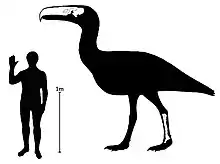
The largest known-ever Cariamiforme and largest phorusrhacid or "terror bird" (highly predatory, flightless birds of America) was Brontornis, which was about 175 cm (69 in) tall at the shoulder, could raise its head 2.8 m (9 ft 2 in) above the ground and could have weighed as much as 400 kg (880 lb).[512] The immense phorusrhacid Kelenken stood 3 m (9.8 ft) tall[513][514] with a skull 716 mm (28.2 in) long (460 mm (18 in) of which was beak), had the largest head of any known bird.[513] South American Phorusrhacos stood nearly 2.4 to 2.7 meters (7 ft 10 in to 8 ft 10 in) tall, and probably weighed nearly 130 kilograms (290 lb), as much as a male ostrich.[515][516] The largest North American phorusrhacid is Titanis, which is about 2.5 m (8 ft 2 in) tall,[517] as tall as a forest elephant.
Accipitriforms (Accipitriformes)
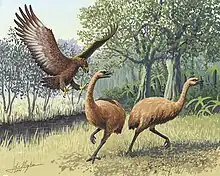
The largest known bird of prey ever was the enormous Haast's eagle (Hieraaetus moorei), with a wingspan of 2.6 to 3 m (8 ft 6 in to 9 ft 10 in), relatively short for their size.[518][519] Total length was probably up to 1.4 m (4 ft 7 in) in female[520] and they weighed about 10 to 15 kg (22 to 33 lb).[521] Another giant extinct hawk was Titanohierax about 7.3 kg (16 lb) that lived in the Antilles and The Bahamas, where it was among the top predators.[522] An unnamed late Quaternary eagle from Hispaniola could be 15–30% larger than the modern golden eagle (Aquila chrysaetos).[523] Some extinct species of Buteogallus surpassed their extant relatives in size. Buteogallus borrasi was about 33% larger than the modern great black hawk (B. urubitinga).[524] B. daggetti, also known as "walking eagle", was around 40% larger than the savanna hawk (B. meridionalis).[525] Eyles's harrier (Circus eylesi) from the Pleistocene-Holocene of New Zealand was more than twice heavier than the extant C. approximans.[526]
Moa (Dinornithiformes)
The tallest known bird was the South Island giant moa (Dinornis robustus), part of the moa family of New Zealand that went extinct about 500 years ago. It stood up to 3.7 m (12 ft) tall,[527] and weighed approximately half as much as a large elephant bird due to its comparatively slender frame.[528]
Tinamous (Tinamiformes)
MPLK-03, a tinamou specimen that existed during the Late Pleistocene in Argentina, possibly belongs to the modern genus Eudromia and surpacces extant E. elegans and E. formosa in size by 2.2–8% and 6–14%, respectively.[529]
Elephant birds (Aepyornithiformes)
The largest bird in the fossil record may be the extinct elephant birds (Vorombe, Aepyornis) of Madagascar, which were related to the ostrich. They exceeded 3 m (9.8 ft) in height and 500 kilograms (1,100 lb) in weight.[528]
Ostriches (Struthioniformes)
With 450 kg (990 lb) in body mass, Pachystruthio dmanisensis from the lower Pleistocene of Crimea was the largest bird ever recorded in Europe. Despite its giant size, it was a good runner.[530] A possible specimen of Pachystruthio from the lower Pleistocene of Hebei Province (China) was about 300 kg (660 lb) in weight, twice heavier than the common ostrich (Struthio camelus).[531] Remains of the massive asian ostrich (Struthio asiaticus) from the Pliocene[532] indicate a size 20% bigger than adult male of the extant Struthio camelus.[533]
Pigeons and doves (Columbiformes)
.jpg.webp)
The largest pigeon relative known was the dodo (Raphus cucullatus), possibly exceeding 1 m (3.3 ft) in height and weighing as much as 28 kg (62 lb), although recent estimates have indicated that an average wild dodo weighed much less at approximately 10.2 kg (22 lb).[534][535]
Pheasants, turkeys, gamebirds and allies (Galliformes)
The largest known of the Galliformes was likely the giant malleefowl, which could reach 7 kg (15 lb) in weight.[536]
Songbirds (Passeriformes)
The largest known songbird is the extinct giant grosbeak (Chloridops regiskongi) at 280 mm (11 in) long.
Cormorants and allies (Suliformes)

- The largest known cormorant was the spectacled cormorant of the North Pacific (Phalacrocorax perspicillatus), which became extinct around 1850 and averaged around 6.4 kg (14 lb) and 1.15 m (3 ft 9 in).[480]
- The largest known darter was Giganhinga with estimated weight about 17.7 kg (39 lb),[475] earlier study even claims 25.7 kg (57 lb).[537]
- The largest known plotopterid, penguin-like flightless bird was Copepteryx titan that is known from 22 cm (8.7 in) long femur, almost twice as long as that of emperor penguin.[538]
Grebes (Podicipediformes)
The largest known grebe, the Atitlán grebe (Podylimbus gigas), reached a length of about 46–50 centimetres (18–20 in).[539]
Bony-toothed birds (Odontopterygiformes)
The largest known of the Odontopterygiformes— a group which has been variously allied with Procellariiformes, Pelecaniformes and Anseriformes and the largest flying birds of all time other than Argentavis were the huge Pelagornis, Cyphornis, Dasornis, Gigantornis and Osteodontornis. They had a wingspan of 5.5–6 m (18–20 ft) and stood about 1.2 m (3 ft 11 in) tall. Exact size estimates and judging which one was largest are not yet possible for these birds, as their bones were extremely thin-walled, light and fragile, and thus most are only known from very incomplete remains.
Woodpeckers and allies (Piciformes)
The largest known woodpecker is the possibly extinct imperial woodpecker (Campephilus imperialis) with a total length of about 56–60 cm (22–24 in).[540]
Parrots (Psittaciformes)
The largest known parrot is the extinct Heracles inexpectatus with a length of about 1 meter (3.3 feet).[541]
Penguins (Sphenisciformes)

One of the heaviest known penguin ever known is Kumimanu fordycei, body mass estimate based on humerus results 148 to 159.7 kg (326 to 352 lb).[542] Other largest penguins, such as cf. Palaeeudyptes klekowskii of Antarctica, with body length (tip of the bill to tip of the tail) estimated about 2.02 m (6 ft 8 in) and body weight is estimated about 116.21 kg (256.2 lb),[543] is later estimated to 84.2 kg (186 lb), and humerus length is 90% of one from K. fordycei.[542] Another large penguin is Anthropornis nordenskjoeldi of New Zealand and Antarctica. Its body length is once estimated 1.99 m (6 ft 6 in) and was 97.8 kg (216 lb) in weight. There is also an estimate that one remain of Anthropornis can reach that body length of 2.05 m (6 ft 9 in) and 108 kg (238 lb) in weight.[544] However, estimation from humerus shows that it reached up to 67 kg (148 lb) for A. nordenskjoeldi.[542] Other large penguins are New Zealand giant penguin (Pachydyptes pondeorsus) weighing possibly around 65.4 to 94.6 kg (144 to 209 lb), and Icadyptes salasi at 52.8 to 73.0 kg (116.4 to 160.9 lb).[545][542]
Owls (Strigiformes)
The largest known owl of all time was the Cuban Ornimegalonyx at 1,100 mm (43.3 in) tall probably exceeding 9 kg (20 lb).[546]
Amphibians (Amphibia)
The largest known amphibian of all time was the 9.1 m (30 ft) long temnospondyl Prionosuchus.[547]
Frogs and toads (Anura)

The largest known frog ever was an as yet unnamed Eocene species that was about 58–59.1-centimetre-long (22.8–23.3 in).[548] The Late Cretaceous Beelzebufo grew to at least 23.2 cm (9.1 in) (snout-vent length), which is around the size of a modern African bullfrog.[549]
Salamanders, newts and allies (Urodela)
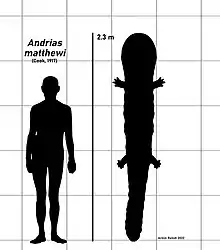
- Andrias matthewi was the largest lissamphibian ever known, with total length up to 2.3 m (7 ft 7 in).[550]
- Habrosaurus was the largest sirenid. It reached 1.6 m (5 ft 3 in) long.[551]
Diadectomorphs (Diadectomorpha)
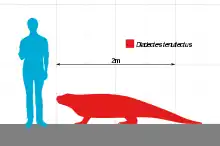
The largest known diacectid, herbivorous Diadectes, was a heavily built animal, up to 3 m (9.8 ft) long, with thick vertebrae and ribs.[552][553]
Anthracosauria
The largest known anthracosaur was Anthracosaurus, with skull about 40 cm (16 in) in length.[554]
Embolomeri
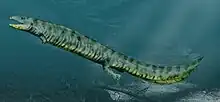
The longest member of this group was Eogyrinus attheyi, species sometimes placed under genus Pholiderpeton.[555] Its skull had length about 41 cm (16 in).[556]
Temnospondyls (Temnospondyli)

The largest known temnospondyl amphibian is Prionosuchus, which grew to lengths of 9 m (30 ft).[547] Another huge temnospondyl was Mastodonsaurus giganteus at 6 m (20 ft) long.[557] Unnamed species of temnospondyl from Lesotho is partial, but possible body length estimation is 7 m (23 ft).[558]
Fishes (Pisces)
Fishes are a paraphyletic group of non-tetrapod vertebrates.
Jawless fish (Agnatha)
Conodonts (Conodonta)
Iowagnathus grandis is estimated to have length over 50 cm (1.6 ft).[559]
Heterostracans (Heterostraci)
Some members of Psammosteidae such as Obruchevia and Tartuosteus are estimated to reached up to 2 m (6.6 ft).[560]
Thelodonts (Thelodonti)
Although known from partial materials, Thelodus parvidens (=T. macintoshi) is estimated to reached up to 1 m (3.3 ft).[561]
Cephalaspidomorphs (Cephalaspidomorphi)
A species of Parameteoraspis reached up to 1 m (3.3 ft).[562]
Spiny sharks (Acanthodii)
The largest of the now-extinct Acanthodii was Xylacanthus grandis, an ischnacanthiform based on a ~35 cm (14 in) long jaw bone. Based on the proportions of its relative Ischnacanthus, X. grandis had an estimated total length of 2.5 m (8 ft 2 in).[563]
Placoderms (Placodermi)

The largest known placoderm was the giant predatory Dunkleosteus. The largest and most well known species was D. terrelli, various estimate put its length around 4.1–10 m (13.5–32.8 ft) in length and 1–4 t (1.1–4.4 short tons) in weight.[564] Another large placoderm, Titanichthys, may have rivaled it in size.[565] Titanichthys is estimated to have a length around 4.1–7.5 m (13–25 ft)[566][567][568][564]
Cartilaginous fish (Chondrichthyes)
Mackerel sharks (Lamniformes)
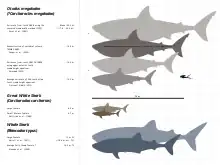
- Species in the extinct genus Otodus were huge. A giant shark, Otodus megalodon[569][570][571] is by far the biggest mackerel shark ever known.[572] Most estimates of megalodon's size extrapolate from teeth, with maximum length estimates up to 10.6–20 m (35–66 ft)[570][571][573] and average length estimates of 10.5 m (34 ft).[574][575] Due to fragmentary remains, there have been many contradictory size estimates for megalodon, as they can only be drawn from fossil teeth and vertebrae.[576]: 87 [577] Mature male megalodon may have had a body mass of 12.6 to 33.9 metric tons (13.9 to 37.4 short tons), and mature females may have been 27.4 to 59.4 metric tons (30.2 to 65.5 short tons), assuming that males could range in length from 10.5 to 14.3 m (34 to 47 ft) and females 13.3 to 17 m (44 to 56 ft).[578] Related to megalodon, Otodus angustidens and O. chubutensis reached the large sizes too. Each was estimated at 9.3 m (31 ft)[579] and 12.2 m (40 ft),[580] respectively.
- Other giant mackerel sharks were Pseudoscapanorhynchidae from the Cretaceous period. Cretodus had a size range of 9–11 m (30–36 ft) (for C. crassidens),[581] Leptostyrax reached lengths of 6.3–8.3 m (21–27 ft).[582]
- The Cenozoic Parotodus reached up to 7.6 m (25 ft) in length.[583]
- The heaviest thresher shark was likely Alopias grandis. It was similar in size or even larger than the extant great white shark and probably did not have an elongated dorsal tail, characteristic of modern relatives.[584]
Ground sharks (Carcharhiniformes)
The Cenozoic Hemipristis serra was considerably larger than its modern-day relatives and had much larger teeth. Its total length is estimated to be at 6 metres (20 ft) long.[585]
Hybodonts (Hybodontiformes)
One of the largest hybodontiforms was the Jurassic Asteracanthus with body length of up to 3 m (9.8 ft).[586] Crassodus reifi is known from less materials, however it is estimated that reached over 3 m (9.8 ft).[587]
Ctenacanthiformes
The largest member of ctenacanthiformes is Saivodus striatus with estimated length around 6–9 m (20–30 ft).[588][564]
Skates and allies (Rajiformes)
The giant sclerorhynchid Onchopristis reached about 4.25 m (13.9 ft) in length.[589]
Eugeneodont (Eugeneodontida)
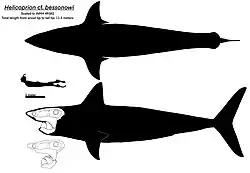
The largest known eugeneodont is an as-yet unnamed species of Helicoprion discovered in Idaho. The specimens suggest an animal that possibly exceeded 12 m (39 ft) in length.[590] Another fairly large eugeneodont is Parahelicoprion. Being more slimmer than Helicoprion, it reached nearly the same size,[590] possibly up to 12 m (39 ft) in length.[591] Both had the largest sizes among the animals of Paleozoic era.[592][591]
Lobe-finned fish (Sarcopterygii)
Coelacanths (Actinistia)

The largest coelacanth is Cretaceous Mawsonia gigas with estimated total length up to 5.3 m (17 ft). Jurassic Trachymetopon may have reached size close to that, about 5 m (16 ft).[593] An undetermined mawsoniid from the Maastrichtian deposits of Morocco probably reached 3.65–5.52 m (12.0–18.1 ft) in length.[594][593]
Lungfish (Dipnoi)
Cretaceous Ceratodus sp. from Western Interior is estimated to had a length around 4 m (13 ft).[595]
Stem-tetrapods (Tetrapodomorpha)

.jpg.webp)
- Not only the largest known rhizodont, but also the largest lobe-finned fish was the 5.63–7 m (18.5–23.0 ft) long Rhizodus.[596][564] Another large rhizodonts were Strepsodus with estimated length around 3–5 m (9.8–16.4 ft) and Barameda estimated at 3–4 m (9.8–13.1 ft) in length.[597][598]
- Tristichopterid Hyneria reached length up to 3.5 m (11 ft).[564]
Ray-finned fish (Actinopterygii)
Pachycormiformes

The largest known ray-finned fish and largest bony fish of all time was the pachycormid, Leedsichthys problematicus, at around 16.5 m (54 ft) long.[599] Earlier estimates have had claims of larger individuals with lengths over 27 m (89 ft).[600][601]
Ichthyodectiformes
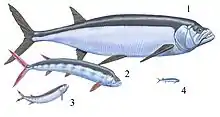
The largest known of ichthyodectiform fish was Xiphactinus, which measured up to 6.1 m (20 ft) long.[602] Ichthyodectes reached 3 m (9.8 ft) long, twice lesser than Xiphactinus.[603]
Pycnodontiformes
The largest known pycnodontiform was Gyrodus circularis, with length up to 2 m (6 ft 7 in).[604]
Bichirs (Polypteriformes)
The Late Cretaceous Bawitius was likely the largest bichir of all time. It reached up to 3 m (9.8 ft) in length.[605]
Opahes, ribbonfishes, oarfishes and allies (Lampriformes)
Megalampris was likely the largest fossil opah. This fish was around 4 m (13 ft) in length when alive, which is twice the length of the largest living opah species, Lampris guttatus.[606]
Salmon and trout (Salmoniformes)
The largest salmon was Oncorhynchus rastrosus, varying in size from 1.9 m (6 ft 3 in) and 177 kg (390 lb)[607] to 2.4 m (7 ft 10 in) and 200 kg (440 lb).[608][607]
Pufferfishes, boxfishes, triggerfishes, ocean sunfishes and allies (Tetraodontiformes)
- Austromola angerhoferi had total body length about 3.2 m (10 ft), and total height 4 m (13 ft), comparable with largest ocean sunfish.[609][610]
- Some extinct species of Balistes like B. vegai and B. crassidens are estimated to have total length up to 1.8 m (5 ft 11 in).[611]
Lizardfishes (Aulopiformes)
The largest lizardfish was Stratodus which could reach length of 5 m (16 ft).[612]
Echinoderms (Echinodermata)
Crinozoa
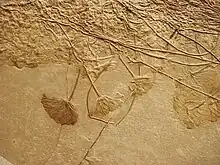
Sea lilies (Crinoidea)
Longest stem of Seirocrinus subangularis reached over 26 m (85 ft).[613]
Starfish (Asteroidea)
Helianthaster from Hunsrück Slate had radius about 25 cm (9.8 in).[614]
Graptolites (Graptolithina)
The longest known graptoloid graptolite is Stimulograptus halli at 1.45 m (4.8 ft). It found in Silurian deposits of the United Kingdom.[615]
Kinorhynchs (Kinorhyncha)
Cambrian kinorhynchs from Qingjiang biota, also known as "mud dragons", reached 4 cm (1.6 in) in length, much larger than extant relatives that grow only a few millimeters in length.[616][617]
Arthropods (Arthropoda)
Gilled lobopodians

Based on the findings of mouthparts, the Cambrian gilled lobopodian Omnidens amplus is estimated to have been 1.5 metres (4.9 ft).[618] It is also known as the largest Cambrian animal known to exist.[618]
Radiodont (Radiodonta)
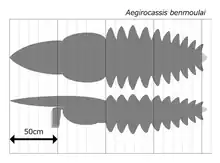
The largest known radiodont is Aegirocassis benmoulai, estimated to have been at least 2 m (6 ft 7 in) long.[619][620]
Sea spiders (Pycnogonida)
The largest fossil sea spider is Palaeoisopus problematicus with legspan about 32 cm (13 in).[621]
Horseshoe crabs and allies (Xiphosura)
- Willwerathia reached 9 cm (3.5 in) in carapace width and was the largest species of basal ("synziphosurine") xiphosurans.[622][623] However, the Devonian Maldybulakia reached nearly 11.5 cm (4.5 in)[624] and was assigned to xiphosurans in 2013.[623]
- Horseshoe crab trackway icnofossil Kouphichnium lithographicum from Cerin in Ain indicates length of animal 77.4–85.1 cm (30.5–33.5 in).[625]
Chasmataspidids (Chasmataspidida)
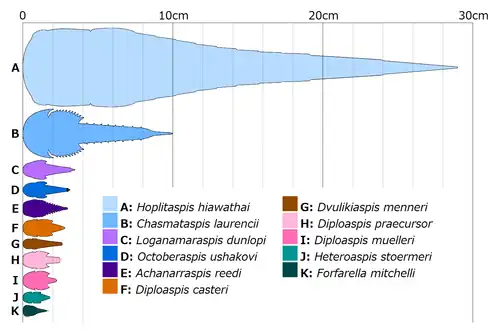
The largest chasmataspidids were the Ordovician Hoplitaspis at 29 cm (11 in) in length and similar in size range Chasmataspis.[626]
Eurypterids (Eurypterida)

- The largest known eurypterid was Jaekelopterus rhenaniae at 2.5 m (8 ft 2 in) in length, which is also the largest arthropod known to exist.[627] Erettopterus grandis possibly reached this same length but this is based on an incomplete telson only. A close contender was Acutiramus bohemicus at 2.1 m (6 ft 11 in) in length.[628] The largest megalograptid as well as the largest Ordovician eurypterid was Pentecopterus. It reached up to 1.7 m (5 ft 7 in) in length.[629] All these were eurypterine eurypterids.[628][629]
- The largest stylonurine eurypterid was Hibbertopterus, with 1.8 m (5 ft 11 in) in length.[628]
Arachnids (Arachnida)
- There are three contenders for largest-known arachnid as well as the largest scorpions of all time: Pulmonoscorpius kirktonensis, Brontoscorpio anglicus and Praearcturus gigas. Each was estimated to have been 70 cm (28 in),[630] 90 cm (35 in)[631] and up to 100 cm (39 in),[632] respectively.
- Mongolarachne jurassica is the largest described fossil spider, with the total body length of female is approximately 24.6 mm (0.97 in) while the front legs reach about 56.5 mm (2.22 in) in length.[633] Dinodiplura ambulacra had larger body length, combined length of carapace and opisthosoma reaches 26.15 mm (1.030 in).[634]
- The largest of prehistoric whipscorpions and possibly the largest-known whipscorpion ever discovered[635] was Mesoproctus. An unnamed species M. sp. had a carapace of 32.5 mm (1.28 in) in length and 16 mm (0.63 in) in width, comparable or even larger than the extant Mastigoproctus have.[636]
- The largest Ricinulei to ever exist was Curculioides bohemondi with a body length of 21.77 mm (0.857 in).[637]
- The largest fossil acariform mite and also the largest erythraeoid mite ever recorded was Immensmaris chewbaccei with idiosoma of more than 8 mm (0.31 in) in length.[638]
- The largest known trigonotarbid was Kreischeria with a minimal length of 51 mm (2.0 in).[639] The second largest was Pleophrynus at 36 mm (1.4 in) in length.[639]
Artiopods (Artiopoda)
Retifacies probably reached up to 55 cm (22 in).[640] Tegopelte is another one example of large non-trilobite artiopod, reached 280 mm (11 in) long[641] and was the largest of the Burgess Shale bilaterians, surpassing all other benthic organisms by at least twice.[641]
Trilobites (Trilobita)
Some of trilobites exceeded 60 cm (24 in) in length. A nearly complete specimen of Isotelus rex from Manitoba attained a length over 70 cm (28 in), and an Ogyginus forteyi from Portugal was almost as long. Fragments of trilobites suggest even larger record sizes. An isolated pygidium of Hungioides bohemicus implies that the full animal was 90 cm (35 in) long.[642]
Myriapods (Myriapoda)

The largest known myriapod by far was Arthropleura. Measuring 2.5 metres (8 ft 2 in) long[643] and 50 centimetres (20 in) wide.[644] Some specimens could have been even larger, up to 2.63 metres (8 ft 8 in) in length and 50 kilograms (110 lb) in weight.[645][646]
Cycloids (Cyclida)
The largest cyclid was Opolanka decorosa, the Late Triassic Halicyne-like cycloid which reached over 6 cm (2.4 in) across the carapace.[647]
Remipedes (Remipedia)
Tesnusocaris had body length at least 9.5 cm (3.7 in),[648] larger than every living remipedes which could reach up to 4.5 cm (1.8 in).[649]
Insects (Insecta)
Sawflies, wasps, bees, ants and allies (Hymenoptera)
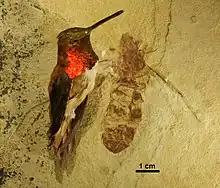
- The largest known of this group was the giant ant Titanomyrma giganteum with queens growing to 6 cm (2.4 in). It had a wingspan of 15 cm (5.9 in).[650]
- Apis lithohermaea is one of the largest honey bees ever found, comparable in size to the modern Apis dorsata.[651]
- The giant horntail Ypresiosirex orthosemos reached 67.9 mm (2.67 in) in length including the incomplete ovipositor.[652] Another example of giant sawfly is Hoplitolyda duolunica, with wingspan over 92 mm (3.6 in).[653]
Fleas (Siphonaptera)
The largest known in Siphonaptera was probably Pseudopulex magnus, growing to 0.90 in (22.8 mm) in length.[654]
Earwigs (Dermaptera)
.jpg.webp)
Extinct as recently as after 1967[655][656] and also submitted as the Holocene subfossils,[657] the Saint Helena giant earwig (Labidura herculeana, with synonym Labidura loveridgei) reached 84 mm (3.3 in) in length uncluding forceps 34 mm (1.3 in) long.[655]
Chresmodidae
Chresmodidae had long specialized legs like of the modern Gerridae family. One of the Chresmodidae, Chresmoda obscura could reached a size of about 19 centimetres (7.5 in).[658]
Beetles (Coleoptera)
One of the largest known fossil beetles in the superfamily Scarabaeoidea is Protognathinus spielbergi. It had total length including mandibles about 5.5 centimetres (2.2 in).[659] The largest fossil scarabaeid was Oryctoantiquus borealis with an estimated body length of 5 centimetres (2.0 in).[660]
Titanopterans (Titanoptera)

Related to modern orthopterans, titanopterans from the Triassic period were much larger. The wingspan of Gigatitan vulgaris was up to 40 centimetres (16 in).[661] Clatrotitan andersoni also reached a huge size, having a forewing of 13.8 centimetres (5.4 in) long.[662]
Antlions and related net-winged insects (Neuroptera)
Makarkinia adamsi from the Crato Formation is estimated to have the longest forewings of any neuropteran species, estimated at 160 mm (6.3 in).[663]
Cockroaches, termites, mantises and allies (Dictyoptera)
- Some Carboniferous cockroach-like insects grouping in Blattoptera like Archoblattina beecheri[664] and Necymylacris (Xenoblatta) scudderi[665][666] could reach around 9 centimetres in total length, which is comparable to a modern Megaloblatta longipennis.
- Cretaceous cockroach Ptiloteuthis foliatus had 7.9 cm (3.1 in) long wing.[667]
- Found in the Miocene of Austria, the giant termite Gyatermes styriensis reached 25 mm (0.98 in) in body length and had a wingspan of 76 mm (3.0 in).[668]
Dragonflies, damselflies and griffinflies (Odonatoptera)
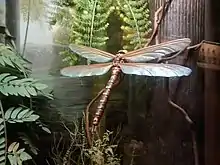
- The largest known odonatopteran insect was Meganeuropsis permiana with single wing of 33 cm (13 in). Meganeura had a 32 cm (13 in) long wing.[669]
- Triadotypid odonatan Reisia gelasii (=Triadotypus guillaumei) from Triassic had 136 millimetres (5.4 in) long wing, and wingspan can be 280 millimetres (11 in).[670][671]
Mayflies (Ephemeroptera)
- The largest known mayfly is Permian Ponalex maximus, with 55 mm (2 in) long hindwing.[672] Cretaceous Epicharmeropsis quadrivenulosus had 37 mm (1 in) long forewing.[673]
- Although Bojophlebia prokopi from the Upper Carboniferous of Moravia (Czech Republic) with a wingspan of 45 cm (18 in) is described as the largest mayfly,[674] later study shows that this insect is not related to mayflies.[675]
Palaeodictyoptera
The largest known palaeodictyopteran was Mazothairos, with an estimated wingspan of up to 560 mm (22 in).[676] If subcircular wing known from Piesberg Quarry belongs to palaeodictyopteran, it possibly had single wing length at least 30 cm (12 in).[677]
Archaeognatha (jumping bristletails) and other wingless primitive insects
- The largest known machilid is Triassic Gigamachilis, with 40 millimetres (1.6 in) body length not counting the length of the filament, and estimated total length about 80 millimetres (3.1 in).[678]
- The largest specimens of the extinct suborder Monura reached 30 millimetres (1.2 in) or more, not counting the length of the filament.[679]
- Although Ramsdelepidion was once considered as 60 millimetres (2.4 in)-long silverfish,[680] it was later considered that classification is uncertain and just treated as stem group insect.[681]
- Wingless early insect Carbotriplura had body length about 103 millimetres (4.1 in) without tail filaments.[682]
Ringed worms (Annelida)
Websteroprion is the largest known fossil eunicidan annelid, with estimated length ranges 0.42–8.3 m (1 ft 5 in – 27 ft 3 in), however comparison with closely related extant taxa indicates length around 1–2 m (3 ft 3 in – 6 ft 7 in).[683] It also had the biggest scolecodonts of any prehistoric polychaete, up to 13.2 mm (0.52 in) in length and possibly larger.[683]
Molluscs (Mollusca)
Snails and slugs (Gastropoda)

- The largest known gastropods were in the genus Campanile, with the extinct Campanile giganteum having shell lengths up to 90 cm (35 in)[684] or even more than 120 cm (47 in).[685]
- The largest known cowrie is Vicetia bizzottoi, with shell length of 33.5 cm (13.2 in).[686]
- Pebasiconcha immanis is the largest land snail ever known, shell height is 25.6 cm (10.1 in) with a partial specimen that may exceed 30 cm (12 in) in height.[687]
Bivalves (Bivalvia)
- The largest known bivalve ever as well as the largest inoceramid was Platyceramus platinus, a giant that usually had an axial length of 1 m (3 ft 3 in), but some individuals could reach an axial length of up to 3 m (9.8 ft).[688] Another large prehistoric bivalve was Inoceramus. In 1952, 187 cm (6.14 ft)-long specimen of Inoceramus steenstrupi was found in the Late Cretaceous deposits of Greenland.[689]
- Some Permian alatoconchid genus like Shikamaia had shell length about 1 m (3 ft 3 in).[690] Previous estimation reconstructed length of Shikamaia around 1.6 m (5 ft 3 in).[691]
- The longest ostreid is Konbostrea, with shell height reaching up to 1.2 m (3 ft 11 in).[692]
- Rudist Titanosarcolites had overall size around 2 m (6 ft 7 in).[693]
Tusk shells (Scaphopoda)
- Complete shell length of tusk shell Prodentalium onoi is estimated to be over 30 cm (12 in).[694]
Cephalopods (Cephalopoda)
Nautiloids (Nautiloidea)
The largest and longest known of nautiloids was Endoceras giganteum with a shell length of 5.73 m (18.8 ft). There is a record of individual whose shell length had reached 9.14 m (30.0 ft), but it is doubtful.[695]
Ammonites (Ammonoidea)
The largest known ammonite was Parapuzosia seppenradensis.[696] A partial fossil specimen found in Germany had a shell diameter of 1.95 m (6 ft 5 in), but the living chamber was incomplete, so the estimated shell diameter was probably about 3.5 m (11 ft) and weighed about 705 kg (1,554 lb) when it was alive.[697] However, later study estimates shell diameter up to around 2 m (6 ft 7 in).[698]
Belemnites (Belemnoidea)
The largest known belemnite was Megateuthis gigantea, reaching about 50 and 700 mm (2.0 and 27.6 in) in maximum diameter and length of rostrum, respectively.[699]
Squids, octopuses, cuttlefishes and allies (Neocoleoidea)
- Octopod Enchoteuthis melanae (considered as specimen of Tusoteuthis longa) had mantle length up to 2 metres (6 ft 7 in), comparable to the modern-day giant squid. Previously, this taxon is considered as animal like giant squid, with total length including arms over 10 metres (33 ft). However, considering other fossil relatives, total length including arms is estimated to be around 3 metres (9.8 ft).[700]
- Both non-octopod Yezoteuthis and teuthid Haboroteuthis are estimated to be similar in size to the modern-day giant squid.[701][702]
Brachiopods (Brachiopoda)
The largest brachiopod ever evolved was Striatifera striata from Akkermanovka Quarry, Russia, with height up to 0.5 metres (1 ft 8 in).[703] Another huge brachiopod was the Carboniferous Gigantoproductus giganteus, with shell width from 30 cm (12 in)[704] to over 35 centimetres (14 in).[693][705] Titanaria costellata had large and long shell 35–36 cm (14–14 in) in width, nearly as large as Gigantoproductus.[706]
Hyoliths (Hyolitha)
The largest hyolith is Macrotheca almgreeni, with length about 50 centimetres (20 in).[693][707]
Cnidarians (Cnidaria)
Vendobionts (Vendobionta)
Petalonamids (Petalonamae)
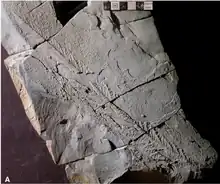
Longest specimens of Trepassia wardae (also known as Charnia wardi) reached 185 cm (73 in) in length.[710] Charnia masoni is known from specimens as small as only 1 cm (0.39 in), up to the largest specimens of 66 cm (26 in) in length.[711]
Proarticulata
Dickinsonia tenuis reached 1.4 m (4.6 ft) in length, that makes it one of the largest precambrian organisms.[712][713]
Sponges (Porifera)
The largest known Permian sponge Gigantospongia had diameter up to 2.5 metres (8 ft 2 in).[714]
See also
References
- Carbone, Chris; Teacher, Amber; Rowcliffe, J (2007). "The Costs of Carnivory". PLOS Biology. 5 (2): e22. doi:10.1371/journal.pbio.0050022. PMC 1769424. PMID 17227145.
- Hokkanen, J.E.I. (21 February 1986). "The size of the largest land animal". Journal of Theoretical Biology. 118 (4): 491–499. Bibcode:1986JThBi.118..491H. CiteSeerX 10.1.1.63.3969. doi:10.1016/S0022-5193(86)80167-9. PMID 3713220. Department of Theoretical Physics, University of Helsinki.
- Romano, Marco; Citton, Paolo; Maganuco, Simone; Sacchi, Eva; Caratelli, Martina; Ronchi, Ausonio; Nicosia, Umberto (2019). Somerville, I. D. (ed.). "New basal synapsid discovery at the P ermian outcrop of T orre del P orticciolo ( A lghero, I taly)". Geological Journal. 54 (3): 1554–1566. doi:10.1002/gj.3250. ISSN 0072-1050. S2CID 133755506.
- "Permian Stratigraphy – International Commission on Stratigraphy International Union of Geological Sciences" (PDF). permian.stratigraphy.org. Archived (PDF) from the original on 3 December 2018. Retrieved 8 September 2022.
- Reisz, Robert R.; Fröbisch, Jörg (16 April 2014). "The Oldest Caseid Synapsid from the Late Pennsylvanian of Kansas, and the Evolution of Herbivory in Terrestrial Vertebrates". PLOS ONE. 9 (4): e94518. Bibcode:2014PLoSO...994518R. doi:10.1371/journal.pone.0094518. PMC 3989228. PMID 24739998.
- Romer, A.S.; Price, L.W. (1940). Review of the Pelycosauria. pp. 400, 403. ISBN 978-0-8137-2028-9.
{{cite book}}:|journal=ignored (help) - "Edaphosaurus". Palaeos. Archived from the original on 20 February 2022. Retrieved 9 September 2022.
- Berman, D.S.; Reisz, R.R.; Martens, T.; Henrici, A.C. (2001). "A new species of Dimetrodon (Synapsida: Sphenacodontidae) from the Lower Permian of Germany records first occurrence of genus outside of North America" (PDF). Canadian Journal of Earth Sciences. 38 (5): 803–812. Bibcode:2001CaJES..38..803B. doi:10.1139/cjes-38-5-803.
- Brink, Kirstin S.; Reisz, Robert R. (16 October 2014). "Hidden dental diversity in the oldest terrestrial apex predator Dimetrodon". Nature Communications. 5: 3269. Bibcode:2014NatCo...5.3269B. doi:10.1038/ncomms4269. PMID 24509889.
- Olson, E.C. (1955). "Parallelism in the evolution of the Permian reptilian faunas of the Old and New Worlds". Fieldiana. 37 (13): 395. Retrieved 8 September 2022.
- St. Fleur, Nicholas (4 January 2019). "An Elephant-Size Relative of Mammals That Grazed Alongside Dinosaurs". The New York Times. Retrieved 9 September 2022.
- Sulej, Tomasz; Niedzwiedzki, Grzegorz (4 January 2019). "An elephant-sized Late Triassic synapsid with erect limbs". Science. 363 (6422): 78–80. Bibcode:2019Sci...363...78S. doi:10.1126/science.aal4853. PMID 30467179.
- "Gigantic mammal "cousin" discovered". Science Daily. 23 November 2018. Archived from the original on 22 August 2022. Retrieved 10 September 2022.
- van Valkenburgh, Blaire; Jenkins, Ian (2002). "Evolutionary Patterns in the History of Permo-Triassic and Cenozoic synapsid predators". Paleontological Society Papers 8: 267–288.
- "Brithopodidae / Anteosauridae". Kheper. M.Alan Kazlev. Archived from the original on 12 August 2019. Retrieved 9 September 2022.
- "Eotitanosuchidae". Kheper. M.Alan Kazlev. Archived from the original on 6 August 2019. Retrieved 9 September 2022.
- Prothero, Donald R. (18 April 2022). "20. Synapsids: The Origin of Mammals". Vertebrate Evolution: From Origins to Dinosaurs and Beyond. Boca Raton: CRC Press. doi:10.1201/9781003128205-4. ISBN 978-0-367-47316-7. S2CID 246318785.
- Kammerer, Christian F. (2016). "Systematics of the Rubidgeinae (Therapsida: Gorgonopsia)". PeerJ. 4: e1608. doi:10.7717/peerj.1608. PMC 4730894. PMID 26823998.
- Frank Zachos, Robert Asher (22 October 2018). Mammalian Evolution, Diversity and Systematics. De Gruyter. pp. 158–159. ISBN 978-3-11-034155-3. Retrieved 9 September 2022.
- J. Van Den Heever (1987), Dissertation Presented for the Degree of Doctor of Philosophy at the University of Stellenbosch
- LYDEKKER, R. (1908). "The Year's Vertebrate Palæontology". Science Progress in the Twentieth Century (1906-1916). 2 (7): 501–524. JSTOR 43776634.
- Broom, Robert (1903). "On Some New Primitive Theriodonts". Annals of the South African Museum. 4.
- Tolchard, Frederick; Kammerer, Christian F.; Butler, Richard J.; Hendrickx, Christophe; Benoit, Julien; Abdala, Fernando; Choiniere, Jonah N. (26 July 2021). "A new large gomphodont from the Triassic of South Africa and its implications for Gondwanan biostratigraphy" (PDF). Journal of Vertebrate Paleontology. 41 (2): e1929265. Bibcode:2021JVPal..41E9265T. doi:10.1080/02724634.2021.1929265. ISSN 0272-4634. S2CID 237517965.
- William A. Clemens (2011). "New morganucodontans from an Early Jurassic fissure filling in Wales (United Kingdom)". Palaeontology. 54 (5): 1139–1156. Bibcode:2011Palgy..54.1139C. doi:10.1111/j.1475-4983.2011.01094.x.
- Rose 2006, p. 56
- Paul Selden; John Nudds (19 September 2012). Evolution of Fossil Ecosystems. Second edition. Academic Press. p. 178. ISBN 978-0-12-404629-0. Retrieved 25 August 2022.
- Zofia Kielan-Jaworowska; Richard L. Cifelli; Zhe-Xi Luo (2004). "Chapter 12: Metatherians". Mammals from the Age of Dinosaurs: origins, evolution, and structure. New York: Columbia University Press. p. 243. ISBN 978-0-231-11918-4.
- Prothero, Donald R. (15 November 2016). The Princeton Field Guide to Prehistoric Mammals. Princeton University Press. p. 33. ISBN 978-0-691-15682-8. Retrieved 22 September 2022.
- Frank Zachos, Robert Asher (22 October 2018). Mammalian Evolution, Diversity and Systematics. De Gruyter. p. 224. ISBN 978-3-11-034155-3. Retrieved 25 August 2022.
- Rose 2006, p. 62.
- Kielan-Jaworowska, Zofia (2013). In Pursuit of Early Mammals. Indiana University Press. p. 115. ISBN 978-0-253-00824-4. Retrieved 25 August 2022.
- Hu; et al. (2005). "Large Mesozoic mammals fed on young dinosaurs" (PDF). Nature. 433 (7022): 149–152. Bibcode:2005Natur.433..149H. doi:10.1038/nature03102. PMID 15650737. S2CID 2306428.
- T. S. Kemp (2005). The Origin and Evolution of Mammals. Oxford University Press, USA. p. 183. ISBN 978-0-19-850761-1. Retrieved 22 September 2022.
- Rose 2006, p. 60
- Thomas E. Williamson, Stephen L. Brusatte, Ross Secord, Sarah Shelley, A new taeniolabidoid multituberculate (Mammalia) from the middle Puercan of the Nacimiento Formation, New Mexico, and a revision of taeniolabidoid systematics and phylogeny, 5 October 2015, doi: 10.1111/zoj.12336: "Taeniolabidoids underwent a modest taxonomic radiation during the early Palaeocene of North America and underwent a dramatic increase in body size, with Taeniolabis taoensis possibly exceeding 100 kg"
- "Zaglossus hacketti – extinct giant echidna". Tourism Western Australia. Archived from the original on 26 January 2014. Retrieved 28 April 2014.
- Pian, Rebecca; Archer, Michael; Hand, Suzanne J. (1 November 2013). "A new, giant platypus, Obdurodon tharalkooschild, sp. nov. (Monotremata, Ornithorhynchidae), from the Riversleigh World Heritage Area, Australia". Journal of Vertebrate Paleontology. 33 (6): 1255–1259. Bibcode:2013JVPal..33.1255P. doi:10.1080/02724634.2013.782876. ISSN 0272-4634. S2CID 85776473.
- Weil, Anne (2005). "Mammalian palaeobiology: Living large in the Cretaceous". Nature (published 12 January 2005). 433 (7022): 116–117. Bibcode:2005Natur.433..116W. doi:10.1038/433116b. PMID 15650725. S2CID 52869101.
- Prevosti, Francisco J.; Forasiepi, Analía; Zimicz, Natalia (5 November 2011). "The Evolution of the Cenozoic Terrestrial Mammalian Predator Guild in South America: Competition or Replacement?". Journal of Mammalian Evolution. 20 (1): 3–21. doi:10.1007/s10914-011-9175-9. hdl:11336/2663. S2CID 15751319.
- Ercoli, Marcos Darío; Prevosti, Francisco Juan (1 December 2011). "Estimación de Masa de las Especies de Sparassodonta (Mammalia, Metatheria) de Edad Santacrucense (Mioceno Temprano) a Partir del Tamaño del Centroide de los Elementos Apendiculares: Inferencias Paleoecológicas" [Mass Estimation of the Holy Cross (Early Miocene) Sparassodonta (Mammalia, Metatheria) Species from the Centroid Size of the Appendicular Elements: Paleoecological Inferences]. Ameghiniana (in Spanish). 48 (4): 462–479. doi:10.5710/amgh.v48i4(347). S2CID 129838311.
- Sorkin, Boris (December 2008). "A biomechanical constraint on body mass in terrestrial mammalian predators". Lethaia. 41 (4): 333–347. doi:10.1111/j.1502-3931.2007.00091.x.
- Engelman, Russell K.; Flynn, John J. (John Joseph); Wyss, André R.; Croft, Darin A. (17 July 2020). Eomakhaira molossus, a new saber-toothed sparassodont (Metatheria: Thylacosmilinae) from the early Oligocene (?Tinguirirican) Cachapoal locality, Andean Main Range, Chile. (American Museum novitates, no. 3957) (Report). American Museum of Natural History. hdl:2246/7235.
- A. M. Forasiepi, M. Judith Babot, and N. Zimicz. 2014. Australohyaena antiqua (Mammalia, Metatheria, Sparassodonta), a large predator from the Late Oligocene of Patagonia. Journal of Systematic Palaeontology 13(6):503-525 DOI: 10.1080/14772019.2014.926403
- Rose 2006, p. 78
- Zofia Kielan-Jaworowska; Richard L. Cifelli; Zhe-Xi Luo (2004). "Chapter 12: Metatherians". Mammals from the Age of Dinosaurs: origins, evolution, and structure. New York: Columbia University Press. p. 428. ISBN 978-0-231-11918-4.
- Wilson, G.P.; Ekdale, E.G.; Hoganson, J.W.; Calede, J.J.; Linden, A.V. (2016). "A large carnivorous mammal from the Late Cretaceous and the North American origin of marsupials". Nature Communications. 7: 13734. Bibcode:2016NatCo...713734W. doi:10.1038/ncomms13734. PMC 5155139. PMID 27929063.
- "Ice Age Marsupial Topped Three Tons, Scientists Say". Archived from the original on 13 April 2010.
- Richards, Hazel L.; Wells, Rod T.; Evans, Alistair R.; Fitzgerald, Erich M. G.; Adams, Justin W. (13 September 2019). "The extraordinary osteology and functional morphology of the limbs in Palorchestidae, a family of strange extinct marsupial giants". PLOS ONE. 14 (9): e0221824. Bibcode:2019PLoSO..1421824R. doi:10.1371/journal.pone.0221824. ISSN 1932-6203. PMC 6744111. PMID 31518353.
- Alloing-Séguier, Léanie; Sánchez-Villagra, Marcelo R.; Lee, Michael S. Y.; Lebrun, Renaud (2013). "The Bony Labyrinth in Diprotodontian Marsupial Mammals: Diversity in Extant and Extinct Forms and Relationships with Size and Phylogeny". Journal of Mammalian Evolution. 20 (3): 191–198. doi:10.1007/s10914-013-9228-3. S2CID 16385939.
- Wroe, S.; Myers, T. J.; Wells, R. T.; Gillespie, A. (1999). "Estimating the weight of the Pleistocene marsupial lion, Thylacoleo carnifex (Thylacoleonidae:Marsupialia): implications for the ecomorphology of a marsupial super-predator and hypotheses of impoverishment of Australian marsupial carnivore faunas". Australian Journal of Zoology. 47 (5): 489. doi:10.1071/ZO99006. ISSN 0004-959X.
- Hocknull, Scott A.; Lewis, Richard; Arnold, Lee J.; Pietsch, Tim; Joannes-Boyau, Renaud; Price, Gilbert J.; Moss, Patrick; Wood, Rachel; Dosseto, Anthony; Louys, Julien; Olley, Jon; Lawrence, Rochelle A. (18 May 2020). "Extinction of eastern Sahul megafauna coincides with sustained environmental deterioration". Nature Communications. 11 (1): 2250. Bibcode:2020NatCo..11.2250H. doi:10.1038/s41467-020-15785-w. ISSN 2041-1723. PMC 7231803. PMID 32418985.
- Helgen, K. M.; Wells, R. T.; Kear, B. P.; Gerdtz, W. R.; Flannery, T. F. (2006). "Ecological and evolutionary significance of sizes of giant extinct kangaroos". Australian Journal of Zoology. 54 (4): 293–303. doi:10.1071/ZO05077.
- Janis, CM; Buttrill, K; Figueirido, B (2014). "Locomotion in Extinct Giant Kangaroos: Were Sthenurines Hop-Less Monsters?". PLOS ONE. 9 (10): e109888. Bibcode:2014PLoSO...9j9888J. doi:10.1371/journal.pone.0109888. PMC 4198187. PMID 25333823.
- Long, John A. (2002). Prehistoric Mammals of Australia and New Guinea: One Hundred Million Years of Evolution. Johns Hopkins University Press. p. 174. ISBN 978-0-8018-7223-5.
- Kazimierz Kowalski (1976). Mammals. An Outline of Theriology. Polish Scientific Publishers. p. 442. Retrieved 17 September 2022.
- John W. Hoganson (2007). Dinosaurs, Sharks, and Woolly Mammoths. State Historical Society of North Dakota. p. 36. ISBN 978-1-891419-33-1. Retrieved 17 September 2022.
- Uhen, Mark D.; Gingerich, Philip D. (1995). "Evolution of Coryphodon (Mammalia, Pantodonta) in the Late Paleocene and Early Eocene of Northwestern Wyoming" (PDF). Contributions from the Museum of Paleontology, University of Michigan. 29 (10): 264. OCLC 742731820. Retrieved 17 September 2022.
- "Paleocene mammals of the world". Archived from the original on 11 September 2022.
- "Paleocene mammals of the world". www.paleocene-mammals.de. Archived from the original on 3 August 2022. Retrieved 17 September 2022.
- TJ Meehan, Larry D. Martin (1 September 2012). "New Large Leptictid Insectivore from the Late Paleogene of South Dakota, USA". Acta Palaeontologica Polonica. 57 (3): 509–518. doi:10.4202/app.2011.0035. S2CID 129358395. Archived from the original on 17 September 2022. Retrieved 17 September 2022.
- MacPhee, Ross (January 1994). "Morphology, adaptations, and relationships of Plesiorycteropus, and a diagnosis of a new order of eutherian Mammals". Bulletin of the American Museum of Natural History (220): 148 – via ResearchGate.
- "Hippopotamus - paleofiles.com". Archived from the original on 31 October 2020.
- Donald R. Prothero, Scott E. Foss (2007). The Evolution of Artiodactyls. The Johns Hopkins University Press. pp. 128–129. ISBN 978-0-8018-8735-2. Retrieved 26 September 2020.
- Peterson, O. A. (1909). "A revision of the Entelodontidae". Memoirs of the Carnegie Museum. 4 (3): 41–158. doi:10.5962/p.234831. hdl:2027/mdp.39015017493571. S2CID 247000277.
- Osborn, H. F. (11 November 1924). "Andrewsarchus, giant mesonychid of Mongolia" (PDF). American Museum Novitates. American Museum of Natural History (146). Archived from the original on 2 November 2020.
- Thewissen, J. G. M.; Cooper, Lisa Noelle; Clementz, Mark T.; Bajpai, Sunil; Tiwari, B. N. (2009). "Thewissen et al. Reply". Nature. 458 (7236): E5. Bibcode:2009Natur.458....5T. doi:10.1038/nature07775. S2CID 4431497.
- R. Tabuce, J. Clavel, and M. T. Antunes. 2011. A structural intermediate between triisodontids and mesonychians (Mammalia, Acreodi) from the earliest Eocene of Portugal. Naturwissenschaften 98:145-155
- East, Shirley G. (29 December 2011). The Dream Hunters Epoch: The Paleo Indians Series. Xlibris Corporation. ISBN 978-1-4653-9694-5.
- Fariña, Richard A.; Vizcaíno, Sergio F.; Iuliis, Gerry De (22 May 2013). Megafauna: Giant Beasts of Pleistocene South America. Indiana University Press. ISBN 978-0-253-00719-3.
- "Bison Latifrons – Characteristics, Behavior and Habitat of Bison Latifrons, the Giant Bison". Archived from the original on 10 November 2013.
- "Extinct Long-horned Bison & Ancient Bison (Bison latifrons and B. antiquus) Fact Sheet: Summary. San Diego Zoo Global Library". Archived from the original on 15 January 2021.
- Kurten, B; Anderson, E (1980). "Order Artiodactyla". Pleistocene mammals of North America (1st ed.). New York: Columbia University Press. pp. 295–339. ISBN 0-231-03733-3.
- "Warkworth Western Weekend Rodeo | Competitors". Archived from the original on 21 August 2011. Retrieved 30 May 2012.
- Palmer, Douglas, ed. (1999). The Marshall Illustrated Encyclopedia of Dinosaurs and Prehistoric Animals. London: Marshall Editions. p. 281. ISBN 978-1-84028-152-1.
- Camps, Gabriel (1992). "Bubalus antiquus". In Camps, Gabriel (ed.). Encyclopédie Berbère (in French). Aix-en-Provence: Edisud. pp. 1642–1647. doi:10.4000/encyclopedieberbere.1875. Archived from the original on 18 July 2020. Retrieved 31 August 2022.
- Pomel, Auguste (1893). Bubalus antiquus. Carte de Géologie de l'Algérie - Paléontologie Monographies de Vertébrés (in French). Algiers: imprimerie P. Fontana. pp. 1–94, pl.1-10. doi:10.5962/bhl.title.13867.
- Kysely, René. "Aurochs and potential crossbreeding with domestic cattle in Central Europe in the Eneolithic period. A metric analysis of bones from the archaeological site of Kutná Hora-Denemark (Czech Republic)". Anthropozoologica. 43 (2): 2008.
- "Kouprey (Bos sauveli)". Archived from the original on 10 August 2011.
- Burnie D and Wilson DE (Eds.), Animal: The Definitive Visual Guide to the World's Wildlife. DK Adult (2005), ISBN 0-7894-7764-5
- K. Suraprasit; J.-J. Jaegar; Y. Chaimanee; O. Chavasseau; C. Yamee; P. Tian; S. Panha (2016). "The Middle Pleistocene vertebrate fauna from Khok Sung (Nakhon Ratchasima, Thailand): biochronological and paleobiogeographical implications". ZooKeys (613): 1–157. doi:10.3897/zookeys.613.8309. PMC 5027644. PMID 27667928.
- Douglas M. Considine, Glenn D. Considine (2013). Van Nostrand's Scientific Encyclopedia. Springer US. p. 446. ISBN 978-1-4757-6918-0. Retrieved 28 August 2022.
- Herring, Andy D. (2014). Beef Cattle Production Systems. CABI. p. 22. ISBN 978-1-78064-507-0. Retrieved 28 August 2022.
- Terry Harrison (27 January 2011). Paleontology and Geology of Laetoli: Human Evolution in Context. Volume 2: Fossil Hominins and the Associated Fauna. Springer Netherlands. p. 404. ISBN 978-90-481-9962-4. Retrieved 17 September 2022.
- Discovery. Magazine of the Peabody Museum of Natural History, Yale University. Volumes 13-16. Peabody Museum of Natural History. 1978. p. 9. Retrieved 17 September 2022.
- Report of the South African Association for the Advancement of Science. Volume 96. South African Association for the Advancement of Science. 2000. p. 163. Retrieved 17 September 2022.
- David Petersen (1989). "Of Moose, Megaloceros and Miracles". Motherearthnews.com. Archived from the original on 4 May 2017.
- Moen, Ron A.; Pastor, John; Cohen, Yosef (1999). "Antler growth and extinction of Irish elk" (PDF). Evolutionary Ecology Research: 235–249. Archived from the original (PDF) on 12 August 2022.
- Charalampos Kevrekidis; Dimitris S. Kostopoulos (March 2017). "The southernmost occurrence of Cervalces latifrons (Johnson, 1874) (Artiodactyla: Cervidae) in Europe". ResearchGate. doi:10.13140/RG.2.2.24751.53928.
- Geist, Valerius (1998). Deer of the world: their evolution, behaviour, and ecology. Stackpole Books. ISBN 978-0-8117-0496-0.Oxworth Books. pp. 111, 126, 247–250. (1998) ISBN 0-8117-0496-3
- Breda, Marzia (2010). "Cervalces latifrons". Natural History Museum. Archived from the original on 4 January 2014.
- Strauss, Bob. "Stag Moose - Facts and Figures". Thoughtco.com. Archived from the original on 4 November 2021. Retrieved 11 October 2022.
- "(in Spanish)". Laignoranciadelconocimiento.blogspot.com.es. 23 December 2011. Archived from the original on 27 January 2022. Retrieved 11 October 2022.
- Basu, Christopher; Falkingham, Peter L.; Hutchinson, John R. (January 2016). "The extinct, giant giraffid Sivatherium giganteum: skeletal reconstruction and body mass estimation". Biology Letters. 12 (1): 20150940. doi:10.1098/rsbl.2015.0940. PMC 4785933. PMID 26763212.
- Palmer, D., ed. (1999). The Marshall Illustrated Encyclopedia of Dinosaurs and Prehistoric Animals. London: Marshall Editions. p. 273. ISBN 1-84028-152-9.
- Janis, C. M., Theodor, J. M., & Boisvert, B. (2002). Locomotor evolution in camels revisited: a quantitative analysis of pedal anatomy and the acquisition of the pacing gait. Journal of Vertebrate Paleontology, 22(1), 110–121.
- Teeth: Kubanochoerus gigas lii (GUAN). tesorosnaturales.es
- Pickford, M. (2006). "New suoid specimens from Gebel Zelten, Libya". Estudios Geológicos. 62 (1). doi:10.3989/egeol.0662147.
- Palmer 1999, p. 269
- Giant Camel Disappeared Species Archived 10 November 2013 at the Wayback Machine. Intechinc.com (5 July 2011)
- Mendoza, M.; Janis, C. M.; Palmqvist, P. (2006). "Estimating the body mass of extinct ungulates: a study on the use of multiple regression". Journal of Zoology. 270 (1): 90–101. CiteSeerX 10.1.1.541.9021. doi:10.1111/j.1469-7998.2006.00094.x.
- "Giant camel fossil found in Syria". BBC News. 10 October 2006. Archived from the original on 27 September 2019. Retrieved 17 April 2013.
- Rebecca Wragg Sykes (17 June 2022). Néandertal, un parent: À la découverte de nos origines. Delachaux et Niestlé. ISBN 978-2-603-02968-8. Retrieved 28 August 2022.
- Anthony J. Stuart, 2021, Vanished Giants: The Lost World of the Ice Age, "6.17 Yesterday's Camel: Camelops Hesternus", p.99, University of Chicago Press
- Bianucci, G.; Lambert, O.; Urbina, M.; Merella, M.; Collareta, A.; Bennion, R.; Salas-Gismondi, R.; Benites-Palomino, A.; Post, K.; de Muizon, C.; Bosio, G.; Di Celma, C.; Malinverno, E.; Pierantoni, P.P.; Villa, I.M.; Amson, E. (2023). "A heavyweight early whale pushes the boundaries of vertebrate morphology". Nature. 620 (7975): 824–829. Bibcode:2023Natur.620..824B. doi:10.1038/s41586-023-06381-1. PMID 37532931. S2CID 260433513.
- Gingerich, P. D.; Arif, M; Bhatti, M Akram; Anwar, M; Sanders, William J (1997). "Basilosaurus drazindai and Basiloterus hussaini, New Archaeoceti (Mammalia, Cetacea) from the Middle Eocene Drazinda Formation, with a Revised Interpretation of Ages of Whale-Bearing Strata in the Kirthar Group of the Sulaiman Range, Punjab (Pakistan)". Contributions from the Museum of Paleontology, University of Michigan. 30 (2): 55–81. hdl:2027.42/48652. OCLC 742731913.
- Kellogg R. A review of the Archaeoceti. Carnegie Institution of Washington Publications. 1936; 482: 1–366.
- Voss, Manja; Antar, Mohammed Sameh M.; Zalmout, Iyad S.; Gingerich, Philip D. (2019). "Stomach contents of the archaeocete Basilosaurus isis: Apex predator in oceans of the late Eocene". PLOS ONE. 14 (1). e0209021. Bibcode:2019PLoSO..1409021V. doi:10.1371/journal.pone.0209021. PMC 6326415. PMID 30625131.
- Giovanni Bianucci; Giulia Bosio; Elisa Malinverno; Christian De Muizon; Igor Villa; Mario Urbina; Olivier Lambert (2018). "A new large squalodelphinid (Cetacea, Odontoceti) from Peru sheds light on the Early Miocene platanistoid disparity and ecology". Royal Society Open Science. 5 (4): 172–302. Bibcode:2018RSOS....572302B. doi:10.1098/rsos.172302. PMC 5936943. PMID 29765678. S2CID 21680097. Archived from the original on 13 August 2018.
- Deméré, T.A.; Berta, A.; McGowen, M.R. (2005). "The taxonomic and evolutionary history of fossil and modern balaenopteroid mysticetes". Journal of Mammalian Evolution. 12 (1/2): 99–143. doi:10.1007/s10914-005-6944-3. S2CID 90231.
- Slater, Graham J.; Goldbogen, Jeremy A.; Pyenson, Nicholas D. (31 May 2017). "Independent evolution of baleen whale gigantism linked to Plio-Pleistocene ocean dynamics". Proceedings of the Royal Society B: Biological Sciences. 284 (1855): 20170546. doi:10.1098/rspb.2017.0546. ISSN 0962-8452. PMC 5454272. PMID 28539520.
- Larramendi, A. (2016). "Shoulder height, body mass and shape of proboscideans" (PDF). Acta Palaeontologica Polonica. 61. doi:10.4202/app.00136.2014. S2CID 2092950.
- Fortelius, M.; Kappelman, J. (1993). "The largest land mammal ever imagined". Zoological Journal of the Linnean Society. 108: 85–101. doi:10.1111/j.1096-3642.1993.tb02560.x.
- Zhegallo, V.; Kalandadze, N.; Shapovalov, A.; Bessudnova, Z.; Noskova, N.; Tesakova, E. (2005). "On the fossil rhinoceros Elasmotherium (including the collections of the Russian Academy of Sciences)" (PDF). Cranium. 22 (1): 17–40.
- Schvyreva, A.K. (2016). Эласмотерии плейстоцена Евразии (PDF) (in Russian). pp. 103–105.
- Kosintsev, P.; Mitchell, K. J.; Devièse, T.; van der Plicht, J.; Kuitems, M.; Petrova, E.; Tikhonov, A.; Higham, T.; Comeskey, D.; Turney, C.; Cooper, A.; van Kolfschoten, T.; Stuart, A. J.; Lister, A. M. (2019). "Evolution and extinction of the giant rhinoceros Elasmotherium sibiricum sheds light on late Quaternary megafaunal extinctions". Nature Ecology & Evolution. 3 (1): 31–38. doi:10.1038/s41559-018-0722-0. hdl:11370/78889dd1-9d08-40f1-99a4-0e93c72fccf3. PMID 30478308. S2CID 53726338.
- Krause, Hans (2011). "Hkhpe 07 02". hanskrause.de. Archived from the original on 28 August 2022. Retrieved 10 September 2022.
- Hans-Dieter Sues, Ross D.E. MacPhee (30 June 1999). Extinctions in Near Time. Causes, Contexts, and Consequences. Springer US. p. 262. ISBN 978-0-306-46092-0. Retrieved 17 September 2022.
- Boeskorov, G. G. (2012). "Some specific morphological and ecological features of the fossil woolly rhinoceros (Coelodonta antiquitatis Blumenbach 1799)". Biology Bulletin. 39 (8): 692–707. doi:10.1134/S106235901208002X. S2CID 24868968.
- "Coelodonta antiquitatis (Mammal)". Triebold Paleontology, Inc. Archived from the original on 2 June 2012. Retrieved 28 August 2022.
- "Amynodonts". Archived from the original on 8 September 2006.
- Maclaren, Jamie A; Hulbert, Richard C; Wallace, Steven C; Nauwelaerts, Sandra (5 October 2018). "A morphometric analysis of the forelimb in the genus Tapirus (Perissodactyla: Tapiridae) reveals influences of habitat, phylogeny and size through time and across geographical space". Zoological Journal of the Linnean Society. 184 (2): 499–515. doi:10.1093/zoolinnean/zly019. ISSN 0024-4082.
- Stanislav Drobyshevsky (2021). Палеонтология антрополога. Том 3. Кайнозой (Paleontology of anthropologist. Volume 3. Cenozoic). LitRes. ISBN 978-5-04-380567-6. Retrieved 19 September 2022.
- Patricia Vickers Rich; Thomas Hewitt Rich; Mildred Adams Fenton; Carroll Lane (15 January 2020). The Fossil Book: A Record of Prehistoric Life. Dover Publications. p. 573. ISBN 978-0-486-83855-7. Retrieved 25 August 2022.
- Agate Fossils National Monument NPS Natural Resource Report NPS/NRPC/GRD/NRR-2009/080 (J. Graham, March 2009)
- Bob Strauss. "Overview of Brontotherium (Megacerops)". About. Archived from the original on 21 November 2021.
- "Brontotherium - Titanothere - Oligocene epoch". Archived from the original on 26 May 2013.
- Gregory S. Paul; Guy D. Leahy (1994). "Terramegathermy in the time of the titans: Restoring the metabolics of colossal dinosaurs" (PDF). The Paleontological Society Special Publications. 7: Dino Fest: 177–198. doi:10.1017/S2475262200009515. Archived from the original (PDF) on 20 September 2022.
- "Brontotheriidae. American Museum of Natural History". Archived from the original on 20 November 2021.
- Eisenmann, Vera (2003). "Gigantic horses" (PDF). Advances in Vertebrate Paleontology.
- Bruce J. MacFadden (1992). Fossil Horses: Systematics, Paleobiology, and Evolution of the Family Equidae. Cambridge University Press. p. 284. ISBN 0-521-47708-5. Retrieved 21 September 2022.
- Kathleen M. Janis (1998). Evolution of Tertiary Mammals of North America: Volume 1, Terrestrial, Carnivores, Ungulates and Ungulatel-like mammals. Cambridge University Press. p. 545. ISBN 978-0-521-35519-3. Retrieved 21 September 2022.
- T. S. Kemp (4 November 2004). The Origin and Evolution of Mammals. Oxford University Press, USA. p. 237. ISBN 978-0-19-154517-7. Retrieved 21 September 2022.
- Jerison, Harry J (December 2007). "What Fossils Tell Us about the Evolution of the Neocortex" (PDF). Evolution of Nervous Systems: 1–12. doi:10.1016/B0-12-370878-8/00065-3. ISBN 978-0-12-370878-6.
- Patricia Vickers Rich; Thomas Hewitt Rich; Mildred Adams Fenton; Carroll Lane Fenton (15 January 2020). The Fossil Book: A Record of Prehistoric Life. Dover Publications. p. 555. ISBN 978-0-486-83855-7. Retrieved 4 September 2022.
- "Ice Age Mammals - EnchantedLearning.com".
- Soibelzon, L. H.; Schubert, B. W. (January 2011). "The Largest Known Bear, Arctotherium angustidens, from the Early Pleistocene Pampean Region of Argentina: With a Discussion of Size and Diet Trends in Bears". Journal of Paleontology. 85 (1): 69–75. doi:10.1666/10-037.1. hdl:11336/104215. S2CID 129585554. Retrieved 1 June 2011.
- Dell'Amore, C. (2011): Biggest Bear Ever Found, National Geographic News, Published 3 February 2011
- Figueirido; et al. (2010). "Demythologizing Arctodus simus, the "short-faced" long-legged and predaceous bear that never was". Journal of Vertebrate Paleontology. 30 (1): 262–275. Bibcode:2010JVPal..30..262F. doi:10.1080/02724630903416027. S2CID 85649497.
- SOIBELZON, LEOPOLDO H.; SCHUBERT, BLAINE W. (2011). "The Largest Known Bear, Arctotherium Angustidens, from the Early Pleistocene Pampean Region of Argentina: With a Discussion of Size and Diet Trends in Bears". Journal of Paleontology. 85 (1): 69–75. doi:10.1666/10-037.1. hdl:11336/104215. JSTOR 23019499. S2CID 129585554.
- Live Science Staff (25 November 2008). "Huge Cave Bears: When and Why They Disappeared". Live Science.
- C. Jin, R. L. Ciochon, W. Dong, R. M. Hunt, Jr., J. Liu, M. Jaeger, and Q. Zhu. 2007. "The first skull of the earliest giant panda". Proceedings of the National Academy of Sciences 104:10932-10937
- Berta, Annalisa (2017). The Rise of Marine Mammals: 50 Million Years of Evolution. Johns Hopkins University Press. p. 110. ISBN 978-1-4214-2325-8. Retrieved 21 August 2022.
- Xénia Keighley; Morten Tange Olsen; Peter Jordan; Sean P.A. Desjardins (2021). The Atlantic Walrus: Multidisciplinary Insights into Human-Animal Interactions. Charlotte Cockle. p. 17. ISBN 978-0-12-817431-9. Retrieved 21 August 2022.
- Morgan Churchill, Mark T. Clementz, Naoki Kohno. "Cope's rule and the evolution of body size in Pinnipedimorpha (Mammalia: Carnivora)". Evolution. 2015 Jan;69(1):201-15. doi:10.1111/evo.12560
- István Fozy; István Szente; Gareth Dyke (1977). Otarioid seals of the Neogene. Geological Survey Professional Paper, Volume 992. Geological Survey (U.S.). pp. 61–62. Retrieved 21 August 2022.
- Grohe, Camille; Uno, Kevin; Boisserie, Jean-Renaud (2022). "Lutrinae Bonaparte, 1838 (Carnivora, Mustelidae) from the Plio-Pleistocene of the Lower Omo Valley, southwestern Ethiopia: systematics and new insights into the paleoecology and paleobiogeography of the Turkana otters". Comptes Rendus Palevol (in French). 30 (30): 684–693. doi:10.5852/cr-palevol2022v21a30. S2CID 252106648.
- Geraads, Denis; Alemseged, Zeresenay; Bobe, René; Reed, Denné (2011). "Enhydriodon dikikae, sp. nov. (Carnivora: Mammalia), a gigantic otter from the Pliocene of Dikika, Lower Awash, Ethiopia". Journal of Vertebrate Paleontology. 31 (2): 447–453. Bibcode:2011JVPal..31..447G. doi:10.1080/02724634.2011.550356. S2CID 84797296.
- "The Bear Otter". Wired. 26 March 2011.
- "Siamogale melilutra: Giant Otter Fossils Reveal New Species – Paleontology – Sci-News.com". sci-news.com.
- "Islands of otters and strange foxes". scienceblogs.com.
- Valenciano, Alberto; Baskin, Jon A.; Abella, Juan; Pérez-Ramos, Alejandro; Álvarez-Sierra, M. Ángeles; Morales, Jorge; Hartstone-Rose, Adam (7 April 2016). "Megalictis, the Bone-Crushing Giant Mustelid (Carnivora, Mustelidae, Oligobuninae) from the Early Miocene of North America". PLOS ONE. 11 (4): e0152430. Bibcode:2016PLoSO..1152430V. doi:10.1371/journal.pone.0152430. ISSN 1932-6203. PMC 4824437. PMID 27054570.
- Prothero, Donald R. (2016). The Princeton Field Guide to Prehistoric Mammals. Princeton University Press. p. 144. ISBN 978-1-4008-8445-2. Retrieved 28 August 2022.
- Turner, Alan (2004). Evolving eden: an illustrated guide to the evolution of the African large-mammal fauna. Mauricio Antón. New York: Columbia University Press. pp. 106–107. ISBN 0-231-11944-5. OCLC 53900492.
- Orlov, Y. U. 1948. Perunium ursogulo Orlov, a new gigantic extinct mustelid (a contribution to the morphology of the skull and brain and to the phylogeny of Mustelidae). Acta Zoologica 29:63–105.
- Valenciano, Alberto; Abella, Juan; Sanisidro, Oscar; Hartstone-Rose, Adam; Álvarez-Sierra, María Ángeles; Morales, Jorge (27 May 2015). "Complete description of the skull and mandible of the giant mustelid Eomellivora piveteaui Ozansoy, 1965 (Mammalia, Carnivora, Mustelidae), from Batallones (MN10), late Miocene (Madrid, Spain)". Journal of Vertebrate Paleontology. 35 (4): e934570. Bibcode:2015JVPal..35E4570V. doi:10.1080/02724634.2014.934570. S2CID 86216613.
- Forasiepi, Analía M.; Prevosti, Francisco J. (2018). Evolution of South American mammalian predators during the Cenozoic: paleobiogeographic and paleoenvironmental contingencies. Cham: Springer. pp. 124–125. ISBN 978-3-319-03701-1.
- Tarquini, Juliana; Toledo, Néstor; Soibelzon, Leopoldo H.; Morgan, Cecilia C. (March 2017). "Body mass estimation for †Cyonasua (Procyonidae, Carnivora) and related taxa based on postcranial skeleton". Historical Biology. 30 (4): 496–506. doi:10.1080/08912963.2017.1295042. S2CID 90408657.
- Díaz-Sibaja, R. (2010). "Titanes Vol. 1 Mamíferos." Fósil Revista de Paleontología. ISSN 0717-9235
- Andersson, Ki (2005). "Were there pack-hunting canids in the Tertiary, and how can we know?". Paleobiology. 41 (4): 333–347. doi:10.1666/0094-8373(2005)031<0056:WTPCIT>2.0.CO;2. S2CID 85306826.
- Wang, Xiaoming; Tedford, Richard H. (2008). Dogs: Their Fossil Relatives & Evolutionary History.
- "Wolves, Coyotes, and Dogs (Genus Canis)". Museum.state.il.us. Retrieved 23 October 2011.
- Boudadi-Maligne, Myriam (2012). "Une nouvelle sous-espèce de loup (Canis lupus maximus nov. Subsp.) dans le Pléistocène supérieur d'Europe occidentale [A new subspecies of wolf (Canis lupus maximus nov. subsp.) from the upper Pleistocene of Western Europe]". Comptes Rendus Palevol. 11 (7): 475. doi:10.1016/j.crpv.2012.04.003.
- Berte, E.; Pandolfi, L. (2014). "Canis lupus (Mammalia, Canidae) from the Late Pleistocene deposit of Avetrana (Taranto, Southern Italy)". Rivista Italiana di Paleontoligia e Stratigrafia. 120 (3): 367–379.
- Figueirido, Borja; Pérez−Claros, Juan A.; Hunt, Robert M. Jr.; Palmqvist, Paul. "Body mass estimation in amphicyonid carnivoran mammals: A multiple regression approach from the skull and skeleton - Acta Palaeontologica Polonica" (PDF). www.app.pan.pl. doi:10.4202/app.2010.0005. S2CID 56051166.
- Jordi Agusti and Mauricio Anton: Mammoths, Sabertooths, and Hominids 65 million years of Mammalian Evolution in Europe, Columbia University Press, 2002, pp.81-83
- Barrett, Paul Zachary (26 October 2021). "The largest hoplophonine and a complex new hypothesis of nimravid evolution". Scientific Reports. 11 (1): 21078. Bibcode:2021NatSR..1121078B. doi:10.1038/s41598-021-00521-1. PMC 8548586. PMID 34702935. S2CID 240000358.
- Peigné, S.; de Bonis, L.; Likius, A.; Mackaye, H. T.; Vignaud, P.; Brunet, M. (2005). "A new machairodontine (Carnivora, Felidae) from the Late Miocene hominid locality of TM 266, Toros-Menalla, Chad". Comptes Rendus Palevol. 4 (3): 243–253. Bibcode:2005CRPal...4..243P. doi:10.1016/j.crpv.2004.10.002.
- Sherani, Shaheer (2016). "A new specimen-dependent method of estimating felid body mass" (PDF). PeerJ Preprints: 16. doi:10.7287/peerj.preprints.2327v2.
- Giovanni G. Bellani (2019). Felines of the World. Discoveries in Taxonomic Classification and History. Elsevier Science. pp. 30–31. ISBN 978-0-12-817277-3. Retrieved 19 September 2022.
- "Newly identified saber-toothed cat is one of largest in history".
- Orcutt, John D.; Calede, Jonathan J.M. (2021). "Quantitative Analyses of Feliform Humeri Reveal the Existence of a Very Large Cat in North America During the Miocene". Journal of Mammalian Evolution. 28 (3): 729–751. doi:10.1007/s10914-021-09540-1. S2CID 235541255.
- "Giant Saber-Toothed Cat Roamed North America during Miocene | Paleontology". Sci-News.com. 4 May 2021. Retrieved 19 September 2022.
- "Xenosmilus". ucmp.berkeley.edu. Retrieved 4 September 2022.
- Merriam, J. C. & Stock, C. 1932: The Felidae of Rancho La Brea. Carnegie Institution of Washington Publications 442, 1–231.
- DeSantis, L. R.; Schubert, B. W.; Scott, J. R.; Ungar, P. S. (2012). "Implications of diet for the extinction of saber-toothed cats and American lions". PLOS ONE. 7 (12): e52453. Bibcode:2012PLoSO...752453D. doi:10.1371/journal.pone.0052453. PMC 3530457. PMID 23300674.
- Argant, Alain; Argant, Jacqueline (2011). "The Panthera gombaszogensis story: the contribution of the Château Breccia (Saône-et-Loire, Burgundy, France)". Quaternaire (Hors-serie 4): 247–269.
- Anne Schmidt-Kuentzel; Laurie Marker; Lorraine K. Boast (2017). Cheetahs: Biology and Conservation. Elsevier Science. p. 30. ISBN 978-0-12-804120-8. Retrieved 4 September 2022.
- Lane, H.H. (1947). "Survey of the Fossil Vertebrates of Kansas: Part V: The Mammals (Continued)" (PDF). Transactions of the Kansas Academy of Science (1903–). Kansas Academy of Science (published December 1947). 50 (3/4): 273–314. doi:10.2307/3625600. JSTOR 3625600.
- Antón, Mauricio (22 November 2013). Sabertooth. Indiana University Press. pp. 104–107. ISBN 978-0-253-01049-0. Retrieved 26 August 2022.
- Alan Turner, National Geographic Prehistoric Mammals National Geographic, 2004, ISBN 0-7922-7134-3
- Turner, Alan; Antón, Mauricio (1996). "The giant hyaena Pachycrocuta brevirostris (Mammalia, Carnivora, Hyaenidae)". Geobios. 29 (#4): 455–468. Bibcode:1996Geobi..29..455T. doi:10.1016/S0016-6995(96)80005-2.
- Flannery, Tim (2018). Europe. The First 100 Million Years. Penguin Books Limited. p. 29: Other temperate giants. ISBN 978-0-14-198903-7. Retrieved 21 August 2022.
- "Sabertooth's Bane: Introducing Dinocrocuta". wordpress.com. 12 January 2016. Archived from the original on 12 November 2020.
- Personal communication from R. Dewer in Burness et al., 2001, table 1
- Wroe et al., 2004, p. 297
- Goodman, S. (2009). "Family Eupleridae (Madagascar Carnivores)". In Wilson, D.; Mittermeier, R. (eds.). Handbook of the Mammals of the World. Volume 1: Carnivores. Lynx Edicions. ISBN 978-84-96553-49-1. Archived from the original on 25 July 2011. Retrieved 31 May 2010.
- Borths, M. R.; Stevens, N. J. (2019). "Simbakubwa kutokaafrika, gen. et sp. nov. (Hyainailourinae, Hyaenodonta, "Creodonta," Mammalia), a gigantic carnivore from the earliest Miocene of Kenya". Journal of Vertebrate Paleontology. 39 (1): e1570222. Bibcode:2019JVPal..39E0222B. doi:10.1080/02724634.2019.1570222. S2CID 145972918.
- Savage, R. J. G. (1973). "Megistotherium, gigantic hyaenodont from Miocene of Gebel Zelten, Libya". Bulletin of the British Museum (Natural History), Geology. 22 (7): 483–511. doi:10.5962/p.150151.
- N. N. Kramarenko (1974). Зоогеография палеогена Азии (Zoogeography of Paleogene of Asia). Publishing office "Nauka". pp. 113–114. Retrieved 18 September 2022.
- O'Leary, Maureen A.; Lucas, Spencer G.; Williamson, Thomas E. (2000). "A new specimen of Ankalagon (Mammalia, Mesonychia) and evidence of sexual dimorphism in mesonychians". Journal of Vertebrate Paleontology. 20 (2): 387–93. doi:10.1671/0272-4634(2000)020[0387:ANSOAM]2.0.CO;2. JSTOR 4524103. S2CID 86542114.
- Paleocene mammals of the world "Carnivores, creodonts and carnivorous ungulates: Mammals become predators"
- "100,000-Year-Old Fossil of Giant Vampire Bat Found in Argentina – Paleontology – Sci-News.com". sci-news.com. 26 July 2021.
- Villier, Boris (2010). "Deinogalerix: a giant hedgehog from the Miocene". Annali dell'Università di Ferrara. 6: 93–102. ISSN 1824-2707.
- Freudenthal, M. (1972). "Deinogalerix koenigswaldi nov. gen., nov. spec., a giant insectivore from the Neogene of Italy". Scripta Geologica. 14: 1–19.
- Engelman, Russell K. (June 2022). "Resizing the largest known extinct rodents (Caviomorpha: Dinomyidae, Neoepiblemidae) using occipital condyle width". Royal Society Open Science. 9 (6): 220370. Bibcode:2022RSOS....920370E. doi:10.1098/rsos.220370. PMC 9198521. PMID 35719882.
- Defler, Thomas (2018). History of Terrestrial Mammals in South America. Springer International Publishing. pp. 151–154. ISBN 978-3-319-98449-0. Retrieved 27 August 2022.
- Biknevicus, A. R.; McFarlane, D. A.; MacPhee, R. D. E. (1993). "Body size in Amblyrhiza inundata (Rodentia: Caviomorpha), an extinct megafaunal rodent from the Anguilla Bank, West Indies: Estimates and implications". American Museum Novitates. New York: American Museum of Natural History (3079): 1–25. hdl:2246/4976.
- Swinehart, Anthony L.; Richards, Ronald L. (2001). "Paleoecology of Northeast Indiana Wetland Harboring Remains of the Pleistocene Giant Beaver (Castoroides Ohioensis)". Proceedings of the Indiana Academy of Science. 110: 151. Retrieved 18 August 2022.
- Milius, Susan (2011). "The Bunny That Ruled Minorca". Science News. 179 (9): 18. doi:10.1002/scin.5591790921.
- Gaudin, Timothy J.; Emry, Robert J.; Wible, John R. (December 2009). "The Phylogeny of Living and Extinct Pangolins (Mammalia, Pholidota) and Associated Taxa: A Morphology Based Analysis". Journal of Mammalian Evolution. 16 (4): 235–305. doi:10.1007/s10914-009-9119-9. ISSN 1064-7554. S2CID 1773698.
- Hooijer, D.A., 1947 - A femur of Manis palaeojavanica Dubois from Western Java - Proceedings of the Koninklijke Nederlandsche Akademie van Wetenschappen 50 (4): 423-418
- Ciochon, Russell L. "The Ape that Was – Asian fossils reveal humanity's giant cousin". University of Iowa. Archived from the original on 25 May 2015. Retrieved 7 September 2022.
- Pettifor, Eric (2000) [1995]. "From the Teeth of the Dragon: Gigantopithecus Blacki". Selected Readings in Physical Anthropology. Kendall/Hunt Publishing Company. pp. 143–149. ISBN 978-0-7872-7155-8. Archived from the original on 5 March 2016. Retrieved 7 September 2022.
- Zhang, Yingqi; Harrison, Terry (January 2017). "Gigantopithecus blacki: a giant ape from the Pleistocene of Asia revisited". American Journal of Physical Anthropology. 162 (S63): 153–177. doi:10.1002/ajpa.23150. ISSN 0002-9483. PMID 28105715. S2CID 46838584.
- Wibowo, A. "Steps of The Asian Giants: Modeling the Body Size Related Foraging Ecology of Meganthropus palaeojavanicus, a 8 Feet Hominid in Central Java". Preprints 2020, 2020110504 (doi: 10.20944/preprints202011.0504.v1).
- Zanolli, Clément; Kullmer, Ottmar; Kelley, Jay; Bacon, Anne-Marie; Demeter, Fabrice; Dumoncel, Jean; Fiorenza, Luca; Grine, Frederick E.; Hublin, Jean-Jacques; Nguyen, Anh Tuan; Nguyen, Thi Mai Huong (May 2019). "Evidence for increased hominid diversity in the Early to Middle Pleistocene of Indonesia". Nature Ecology & Evolution. 3 (5): 755–764. doi:10.1038/s41559-019-0860-z. ISSN 2397-334X. PMID 30962558. S2CID 102353734.
- Froehle AW, Churchill SE (2009). "Energetic Competition Between Neandertals and Anatomically Modern Humans" (PDF). PaleoAnthropology: 96–116. Retrieved 12 September 2022.
- Carretero, José-Miguel; Rodríguez, Laura; García-González, Rebeca; Arsuaga, Juan-Luis; Gómez-Olivencia, Asier; Lorenzo, Carlos; Bonmatí, Alejandro; Gracia, Ana; Martínez, Ignacio (2012). "Stature estimation from complete long bones in the Middle Pleistocene humans from the Sima de los Huesos, Sierra de Atapuerca (Spain)" (PDF). Journal of Human Evolution. 62 (2): 242–255. doi:10.1016/j.jhevol.2011.11.004. PMID 22196156.
- Alan Walker, Richard Leakey (1993). The Nariokotome Homo erectus skeleton. Harvard University Press. p. 412. ISBN 978-0-674-60075-1. Retrieved 2 October 2022.
- Migliano AB, Guillon M (2012). "The Effects of Mortality, Subsistence, and Ecology on Human Adult Height and Implications for Homo Evolution". Current Anthropology. 53 (S6): 359–368. doi:10.1086/667694. S2CID 84442763.
- Delson, Eric; Terranova, Carl J.; Jungers, William J; Sargis, Sargis; Jablonski, Nina G.; Dechow, Paul C. (2000). "Body mass in Cercopithecidae (Primates, Mammalia): estimation and scaling in extinct and extant taxa". Anthropological Papers of the American Museum of Natural History. 83: 1–159.
- Jablonski, Nina; Leakey, Meave; Anton, Mauricio (1 January 2008), Jablonski, N.G. Leakey, M.G. and Anton, M. (2008) Systematic Paleontology of the Cercopithecines. In: Jablonski, N.G. and Leakey, M.G. (eds.) Koobi Fora Research Project. Volume 6. The Fossil Monkeys. California Academy of Sciences, San Francisco, pp. 103–300., pp. 103–300, retrieved 10 September 2022
- Perry, Jonathan M. G.; Cooke, Siobhán B.; Runestad Connour, Jacqueline A.; Burgess, M. Loring; Ruff, Christopher B. (2018). "Articular scaling and body mass estimation in platyrrhines and catarrhines: Modern variation and application to fossil anthropoids". Journal of Human Evolution. 115: 20–35. doi:10.1016/j.jhevol.2017.10.008. ISSN 1095-8606. PMID 29150186.
- Rachel H. Dunn. "Additional postcranial remains of omomyid primates from the Uinta Formation, Utah and implications for the locomotor behavior of large-bodied omomyids". Journal of Human Evolution Volume 58, Issue 5, May 2010, pp. 406-417
- Jungers, W. L.; Demes, B.; Godfrey, L. R. (2008). "How Big were the "Giant" Extinct Lemurs of Madagascar?". In Fleagle, J. G.; Gilbert, C. C. (eds.). Elwyn Simons: A Search for Origins. Developments in Primatology: Progress and Prospects. p. 350. doi:10.1007/978-0-387-73896-3_23. ISBN 978-0-387-73895-6.
- Godfrey, L. R.; Jungers, W. L. (2002). "Quaternary fossil lemurs". In Hartwig, W. C (ed.). The Primate Fossil Record. Cambridge University Press. p. 101. ISBN 978-0-521-66315-1.
- Crowley, B.E., & Godfrey, L.R. (2019). "Strontium Isotopes Support Small Home Ranges for Extinct Lemurs". Frontiers in Ecology and Evolution, 7, 490. doi: 10.1002/ajp.20817
- Megaladapis edwardsi: Scientific information. Archived copy from 20 January 2021.
- Osborn, H. F. (1942). Proboscidea, Vol. II. New York: The American Museum Press.
- Lister, A.; Bahn, P. (2007). Mammoths – Giants of the Ice Age (3 ed.). London: Frances Lincoln. ISBN 978-0-520-26160-0.
- Mol, D. and van Logchem, W. 2009. The mastodon of Milia: the longest tusks in the world. Deposits 19: 28–32.
- Marsh, Helene; O'Shea, Thomas J.; Reynolds III, John E. (2011). "Steller's sea cow: discovery, biology and exploitation of a relict giant sirenian". Ecology and Conservation of the Sirenia: Dugongs and Manatees. New York, New York: Cambridge University Press. pp. 18–35. ISBN 978-0-521-88828-8. OCLC 778803577.
- Scheffer, Victor B. (November 1972). "The Weight of the Steller Sea Cow". Journal of Mammalogy. 53 (4): 912–914. doi:10.2307/1379236. JSTOR 1379236.
- Andrews, C.W. (1906). A descriptive catalogue of the Tertiary Vertebrata of the Fayûm. British Museum, London. Taylor and Francis. p. 324.
- Mondéjar-Fernández; et al. (2008). "El género Arsinoitherium: catálogo de la colección inédita del Muséum d'Histoire Naturelle de París y el problema del número de especies". Palaeontologica Nova (in Spanish). SEPAZ (8): 292–304.
- Sanders, W.J., Kappelman, J., and Rasmussen, D.T. 2004. New large−bodied mammals from the late Oligocene site of Chilga, Ethiopia. Acta Palaeontologica Polonica 49 (3): 365–392..
- Rose 2006, p. 260
- Rodolphe Tabuce (2016). "A mandible of the hyracoid mammal Titanohyrax andrewsi in the collections of the Muséum National d'Histoire Naturelle, Paris (France) with a reassessment of the species". Palaeovertebrata. 40 (1): e4. doi:10.18563/pv.40.1.e4.
- J. G. M. Thewissen; E. L. Simons (2001). "Skull of Megalohyrax eocaenus (Hyracoidea, Mammalia) from the Oligocene of Egypt". Journal of Vertebrate Paleontology. 21 (1): 98–106. doi:10.1671/0272-4634(2001)021[0098:SOMEHM]2.0.CO;2. JSTOR 4524175. S2CID 86063305.
- Donald R. Prothero; Robert M. Schoch (1989). The Evolution of Perissodactyls. Oxford University Press. p. 65. ISBN 978-0-19-506039-3. Retrieved 20 September 2022.
- Skinner, J. D.; Chimimba, Christian T. (2005). The Mammals of the Southern African Sub-region. Cambridge University Press. p. 41. ISBN 978-1-107-39405-6. Retrieved 20 September 2022.
- Werdelin, Lars; Sanders, William Joseph (2010). Cenozoic Mammals of Africa. University of California Press. p. 143. ISBN 978-0-520-25721-4. Retrieved 20 September 2022.
- Pyenson, Nicholas D.; Vermeij, Geerat J. (2016). "The rise of ocean giants: Maximum body size in Cenozoic marine mammals as an indicator for productivity in the Pacific and Atlantic Oceans". Biology Letters. 12 (7). doi:10.1098/rsbl.2016.0186. PMC 4971165. PMID 27381883. S2CID 1652462.
- Hayashi, Shoji; Houssaye, Alexandra; Nakajima, Yasuhisa; Chiba, Kentaro; Ando, Tatsuro; Sawamura, Hiroshi; Inuzuka, Norihisa; Kaneko, Naotomo; Osaki, Tomohiro (2 April 2013). "Bone Inner Structure Suggests Increasing Aquatic Adaptations in Desmostylia (Mammalia, Afrotheria)". PLOS ONE. 8 (4): e59146. Bibcode:2013PLoSO...859146H. doi:10.1371/journal.pone.0059146. ISSN 1932-6203. PMC 3615000. PMID 23565143.
- Lister, Adrian (24 April 2018). Darwin's Fossils. The Collection That Shaped the Theory of Evolution. Smithsonian. p. 57. ISBN 978-1-58834-617-9. Retrieved 4 September 2022.
- Larmon, Jean T.; McDonald, H. Gregory; Ambrose, Stanley; DeSantis, Larisa R. G.; Lucero, Lisa J. (27 February 2019). "A year in the life of a giant ground sloth during the Last Glacial Maximum in Belize". Science Advances. 5 (2): eaau1200. Bibcode:2019SciA....5.1200L. doi:10.1126/sciadv.aau1200. PMC 6392778. PMID 30820449.
- "BBC – Science & Nature – Wildfacts – Megatherium". 1 February 2014. Archived from the original on 1 February 2014. Retrieved 29 June 2017.
{{cite web}}: CS1 maint: bot: original URL status unknown (link) - Johnson, Steven C. and Madden, Richard H.. Uruguaytheriinae Astrapotheres of Tropical South America. Chapter 22 in "Vertebrate Paleontology in the Neotropics. The Miocene Fauna of La Venta, Colombia". Edited by Richard F. Kay, Richard H. Madden, Richard L. Cifelli, and John J. Flynn. Smithsonian Institution Press. Washington and London.
- Kramarz, Alejandro G.; Bond, Mariano (2008). "Revision of Parastrapotherium (Mammalia, Astrapotheria) and other Deseadan astrapotheres of Patagonia". Ameghiniana. 45 (3). Retrieved 1 March 2013.
- Carrillo, Juan D.; Amson, Eli; Jaramillo, Carlos; Sánchez, Rodolfo; Quiroz, Luis; Cuartas, Carlos; Rincón, Aldo F.; Sánchez-Villagra, Marcelo R. (2018). "The Neogene record of northern South American native ungulates". Smithsonian Contributions to Paleobiology. 101 (101): iv-67. doi:10.5479/si.1943-6688.101. S2CID 135113342.
- Gingerich, Philip D. (1998). "Paleobiological Perspectives on Mesonychia, Archaeoceti, and the Origin of Whales". In Thewissen, J.G.M. (ed.). The emergence of whales: evolutionary patterns in the origin of Cetacea. New York: Plenum Press. pp. 423–450. ISBN 978-0-306-45853-8.
- Elissamburu, A (2012). "Estimación de la masa corporal en géneros del Orden Notoungulata". Estudios Geológicos. 68 (1): 91–111. doi:10.3989/egeol.40336.133.
- Croft, D. A.; Gelfo, J. N.; López, G. M. (2020). "Splendid Innovation: The Extinct South American Native Ungulates". Annual Review of Earth and Planetary Sciences. 48: 259–290. Bibcode:2020AREPS..48..259C. doi:10.1146/annurev-earth-072619-060126. S2CID 213737574.
- Dortangs, Rudi W.; Schulp, Anne S.; Eric W. A. Mulder; John W.M. Jagt (2002). "A large new mosasaur from the Upper Cretaceous of The Netherlands". Netherlands Journal of Geosciences. 81 (1): 1–8. doi:10.1017/S0016774600020515.
- Grigoriev, Dimitry V. (2014). "Giant Mosasaurus hoffmanni (Squamata, Mosasauridae) from the Late Cretaceous (Maastrichtian) of Penza, Russia" (PDF). Proceedings of the Zoological Institute RAS. 318 (2): 148–167. doi:10.31610/trudyzin/2014.318.2.148. S2CID 53574339.
- Fanti, Federico; Cau, Andrea; Negri, Alessandra (1 May 2014). "A giant mosasaur (Reptilia, Squamata) with an unusually twisted dentition from the Argille Scagliose Complex (late Campanian) of Northern Italy". Cretaceous Research. 49: 91–104. Bibcode:2014CrRes..49...91F. doi:10.1016/j.cretres.2014.01.003. ISSN 0195-6671.
- Everhart, Mike. "Research: Tylosaurus proriger – A new record of a large mosasaur from the Smoky Hill Chalk". Oceans of Kansas. Retrieved 12 May 2010.
- "Fact File: Tylosaurus Proriger from National Geographic". Retrieved 12 May 2010.
- Head, Jason J.; et al. (5 February 2009). "Giant boid snake from the Palaeocene neotropics reveals hotter past equatorial temperatures" (PDF). Nature. 457 (7230): 715–717. Bibcode:2009Natur.457..715H. doi:10.1038/nature07671. PMID 19194448. S2CID 4381423. Retrieved 12 May 2010.
- Head, J. & Polly, D. 2004. They might be giants: morphometric methods for reconstructing body size in the world's largest snakes. Journal of Vertebrate Paleontology 24 (Supp. 3), 68A-69A.
- "A giant among snakes". newscientist.com.
- Rio, Jonathan P.; Mannion, Philip D. (4 July 2017). "The osteology of the giant snake Gigantophis garstini from the upper Eocene of North Africa and its bearing on the phylogenetic relationships and biogeography of Madtsoiidae". Journal of Vertebrate Paleontology. 37 (4): e1347179. Bibcode:2017JVPal..37E7179R. doi:10.1080/02724634.2017.1347179. ISSN 0272-4634. S2CID 90335531.
- Rage, Jean-Claude; Bajpai, Sunil; Johannes G. M. Thewissen; Tiwari, Brahma N. (2003). "Early Eocene snakes from Kutch, Western India, with a review of the Palaeophiidae" (PDF). Geodiversitas. 25 (4): 695–716. ISSN 1280-9659. Retrieved 12 May 2010.
- Rage, J.-C. (1983). "Palaeophis colossaeus nov. sp. (le plus grand Seprent connu?) de l'Eocène du Mali et le problème du genre chez les Palaeopheinae". Comptes Rendus des Séances de l'Académie des Sciences. 3 (296): 1741–1744.
- "Large palaeophiid and nigerophiid snakes from Paleogene Trans-Saharan Seaway deposits of Mali – Acta Palaeontologica Polonica". www.app.pan.pl. Retrieved 8 January 2021.
- Scanlon, John D.; Mackness, Brian S. (1 January 2001). "A new giant python from the Pliocene Bluff Downs Local Fauna of northeastern Queensland". Alcheringa: An Australasian Journal of Palaeontology. 25 (4): 425–437. Bibcode:2001Alch...25..425S. doi:10.1080/03115510108619232. ISSN 0311-5518. S2CID 85185368.
- Owen, R. (1857). "On the Fossil Vertebrae of a Serpent (Laophis crotaloides, Ow.) discovered by Capt. Spratt, R.N., in a Tertiary Formation at Salonica". Quarterly Journal of the Geological Society. 13 (1–2): 196–199. doi:10.1144/GSL.JGS.1857.013.01-02.28. S2CID 131142130.
- Benjamin P. Kear (2014). "Rediscovery of Laophis crotaloides – the worlds largest viper?". researchgate.net. Retrieved 14 September 2022.
- Bailon, S., Bover, P., Quintana, J., & Alcover, J. A. (2010). First fossil record of Vipera Laurenti 1768 "Oriental vipers complex" (Serpentes: Viperidae) from the Early Pliocene of the western Mediterranean islands. Comptes Rendus Palevol, 9, 147–154.
- Fachini, Thiago Schineider; Onary, Silvio; Palci, Alessandro; Lee, Michael S. Y.; Bronzati, Mario; Hsiou, Annie Schmaltz (18 December 2020). "Cretaceous Blind Snake from Brazil Fills Major Gap in Snake Evolution". iScience. 23 (12): 101834. Bibcode:2020iSci...23j1834F. doi:10.1016/j.isci.2020.101834. ISSN 2589-0042. PMC 7718481. PMID 33305189.
- Molnar, R. E. (2004). Dragons in the Dust: The Paleobiology of the Giant Monitor Lizard Megalania. Indiana University Press. pp. 174–175. ISBN 0-253-34374-7. OCLC 52775128.
- Fry, B.; Wroe, S.; Teeuwisse, W.; Van Osch, M. J. P.; Moreno, K.; Ingle, J.; McHenry, C.; Ferrara, T.; Clausen, P.; Scheib, H.; Winter, K. L.; Greisman, L.; Roelants, K.; Van Der Weerd, L.; Clemente, C. J.; Giannakis, E.; Hodgson, W. C.; Luz, S.; Martelli, P.; Krishnasamy, K.; Kochva, E.; Kwok, H. F.; Scanlon, D.; Karas, J.; Citron, D. M.; Goldstein, E. J. C.; McNaughtan, J. E.; Norman, J. A.; et al. (2009). "A central role for venom in predation by Varanus komodoensis (Komodo Dragon) and the extinct giant Varanus (Megalania) priscus". PNAS. 106 (22): 8969–74. Bibcode:2009PNAS..106.8969F. doi:10.1073/pnas.0810883106. PMC 2690028. PMID 19451641.
- "Review of Dragons in the Dust: The Paleobiology of the Giant Monitor Lizard Megalania, by Ralph E. Molnar, 2004 in the Journal of Vertebrate Paleontology 25(2):479, June 2005" (PDF). Archived from the original (PDF) on 27 January 2016. Retrieved 16 September 2022.
- Colston, T. J.; Kulkarni, P.; Jetz, W.; Pyron, R. A. (2020). "Phylogenetic and spatial distribution of evolutionary diversification, isolation, and threat in turtles and crocodilians (non-avian archosauromorphs)". BMC Evolutionary Biology. 20 (1): 81. doi:10.1186/s12862-020-01642-3. PMC 7350713. PMID 32650718.
- Mike Everhart. "Marine turtles from the Western Interior Sea". Oceans of Kansas. Archived from the original on 7 April 2022.
- Igor Gennadievich Danilov; Ekaterina M. Obraztsova; Maxim Savvich Arkhangelsky; Alexey V. Ivanov; Alexander Averianov (2022). "Protostega gigas and other sea turtles from the Campanian of Eastern Europe, Russia". Cretaceous Research. 135: 105196. Bibcode:2022CrRes.13505196D. doi:10.1016/j.cretres.2022.105196. S2CID 247431641.
- Derstler, K.; Leitch, A. D.; Larson, P. L.; Finsley, C.; Hill, L. (1993). "The World's Largest Turtles - The Vienna Archelon (4.6 m) and the Dallas Protostega (4.2 m), Upper Cretaceous of South Dakota and Texas". Journal of Vertebrate Paleontology. 13 (suppl. to no. 3) (33A).
- Kear, Benjamin P. (11 September 2006). "Reassessment of Cratochelone Berneyi Longman, 1915, a giant sea turtle from the Early Cretaceous of Australia". Journal of Vertebrate Paleontology. 26 (3): 779–783. doi:10.1671/0272-4634(2006)26[779:ROCBLA]2.0.CO;2. ISSN 0272-4634. S2CID 140149175.
- H. F. Kaddumi (2006). "A new genus and species of gigantic marine turtles (Chelonioidea: Cheloniidae) from the Maastrichtian of the Harrana Fauna-Jordan" (PDF). PalArch's Journal of Vertebrate Palaeontology. 3 (1): 1–14. Archived from the original (PDF) on 24 February 2012. Retrieved 4 February 2010.
- R. Kohler (1995). "A new species of the fossil turtle Psephophorus (Order Testudines) from the Eocene of the South Island, New Zealand". Journal of the Royal Society of New Zealand. 25 (3): 371–384. Bibcode:1995JRSNZ..25..371K. doi:10.1080/03014223.1995.9517495. Archived from the original on 4 October 2021.
- Hirayama, Ren; Sonoda, Teppei; Takai, Masanaru; Htike, Thaung; Thein, Zin Maung Maung; Takahashi, Akio (6 April 2015). "Megalochelys: gigantic tortoise from the Neogene of Myanmar". PeerJ PrePrints. doi:10.7287/peerj.preprints.961v1.
- Rhodin, Anders G. J.; Thomson, Scott; Georgalis, Georgios L.; Karl, Hans Volker; Danilov, Igor G.; Takahashi, Akio; de la Fuente, Marcelo SaulIcon; Bourque, Jason; Delfino, Massimo; Bour, Roger; Iverson, John B.; Shaffer, Bradley H.; van Dijk, Peter Paul (2015). "Turtles and Tortoises of the World During the Rise and Global Spread of Humanity: First Checklist and Review of Extinct Pleistocene and Holocene Chelonians" (PDF). Chelonian Research Monographs. 5: 1–66. doi:10.3854/crm.5.000e.fossil.checklist.v1.2015. ISBN 978-0-9653540-9-7. ISSN 1088-7105. Archived (PDF) from the original on 21 September 2022.
- Pérez-García, Adán; Vlachos, Evangelos (1 November 2014). "New generic proposal for the European Neogene large testudinids (Cryptodira) and the first phylogenetic hypothesis for the medium and large representatives of the European Cenozoic record". Zoological Journal of the Linnean Society. 172 (3): 653–719. doi:10.1111/zoj12183. ISSN 0024-4082.
- Pérez-García, Adán; Vlachos, Evangelos; Arribas, Alfonso (March 2017). "The last giant continental tortoise of Europe: A survivor in the Spanish Pleistocene site of Fonelas P-1" (PDF). Palaeogeography, Palaeoclimatology, Palaeoecology. 470: 30–39. Bibcode:2017PPP...470...30P. doi:10.1016/j.palaeo.2017.01.011. hdl:10261/277114. Archived from the original (PDF) on 26 January 2022.
- Jason J Head; Philip D. Gingerich; S. Mahmood Raza (1999). "Drazinderetes tethyensis, a new large trionychid (Reptilia: Testudines) from the marine Eocene Drazinda Formation of the Sulaiman Range, Punjab (Pakistan)" (PDF). Museum of Paleontology, The University of Michigan. pp. 199–214. Archived (PDF) from the original on 13 October 2022.
- Grande, Lance (14 June 2013). The Lost World of Fossil Lake: Snapshots from Deep Time. University of Chicago Press. p. 200. ISBN 978-0-226-92296-6.
- Cadena, E.-A.; Scheyer, T.M.; Carrillo-Briceño, J.D.; Sánchez, R.; Aguilera-Socorro, O.A.; Vanegas, A.; Pardo, M.; Hansen, D.M.; Sánchez-Villagra, M.R. (12 February 2020). "The anatomy, paleobiology, and evolutionary relationships of the largest extinct side-necked turtle". Science Advances. 6 (7): eaay4593. Bibcode:2020SciA....6.4593C. doi:10.1126/sciadv.aay4593. PMC 7015691. PMID 32095528.
- "Researchers reveal ancient giant turtle fossil". Phys.org. 17 May 2012. Archived from the original on 22 September 2022. Retrieved 13 October 2022.
- Maugh II, Thomas H. (18 May 2012). "Researchers find fossil of a turtle that was size of a Smart car". Los Angeles Times. Archived from the original on 23 September 2022. Retrieved 13 October 2022.
- Freeman, David (17 May 2012). "Car-Sized Reptile Lived Alongside Titanoboa, Scientists Say". Huffington Post. Archived from the original on 23 September 2022. Retrieved 13 October 2022.
- Edwin A. Cadena; Daniel T. Ksepka; Carlos A. Jaramillo; Jonathan I. Bloch (2012). "New pelomedusoid turtles from the late Palaeocene Cerrejón Formation of Colombia and their implications for phylogeny and body size evolution". Journal of Systematic Palaeontology. 10 (2): 313–331. doi:10.1080/14772019.2011.569031. S2CID 59406495.
- Tong, Haiyan; Chanthasit, Phornphen; Naksri, Wilailuck; Ditbanjong, Pitaksit; Suteethorn, Suravech; Buffetaut, Eric; Suteethorn, Varavudh; Wongko, Kamonlak; Deesri, Uthumporn; Claude, Julien (November 2021). "Yakemys multiporcata n. g. n. sp., a Large Macrobaenid Turtle from the Basal Cretaceous of Thailand, with a Review of the Turtle Fauna from the Phu Kradung Formation and Its Stratigraphical Implications". Diversity. 13 (12): 630. doi:10.3390/d13120630.
- Lauren E. Brown, Don Moll (October 2019). "The enigmatic palaeoecology and palaeobiogeography of the giant, horned, fossil turtles of Australasia: a review and reanalysis of the data". Herpetological Journal. 29 (4): 252–263. doi:10.33256/hj29.4.252263. ISSN 0268-0130. Archived from the original on 18 June 2022.
- Ross D.E. MacPhee, Hans-Dieter Sues (1999). Extinctions in near time: causes, contexts, and consequences. Kluwer Academic/Plenum Publishers. p. 251. ISBN 978-0-306-46092-0.
- "PLACODONTS: The bizarre "walrus-turtles" of the Triassic". Oceans of Kansas. Archived from the original on 30 January 2022.
- Liu, Jun (27 November 2014). "A gigantic nothosaur (Reptilia: Sauropterygia) from the Middle Triassic of SW China and its implications for the Triassic biotic recovery". Scientific Reports. 4: 7142. Bibcode:2014NatSR...4E7142L. doi:10.1038/srep07142. PMC 4245812. PMID 25429609.
- O'Gorman, J.P.; Santillana, S.; Otero, R.; Reguero, M. (1 October 2019). "A giant elasmosaurid (Sauropterygia; Plesiosauria) from Antarctica: New information on elasmosaurid body size diversity and aristonectine evolutionary scenarios". Cretaceous Research. 102: 37–58. Bibcode:2019CrRes.102...37O. doi:10.1016/j.cretres.2019.05.004. ISSN 0195-6671. S2CID 181725020.
- Kubo, T.; Mitchell, M. T.; Henderson, D. M. (2012). "Albertonectes vanderveldei, a new elasmosaur (Reptilia, Sauropterygia) from the Upper Cretaceous of Alberta". Journal of Vertebrate Paleontology. 32 (3): 557–572. Bibcode:2012JVPal..32..557K. doi:10.1080/02724634.2012.658124. S2CID 129500470.
- Smith, Elliott (1 January 2020). "Revision of the Genus Styxosaurus and Relationships of the Late Cretaceous Elasmosaurids (Sauropterygia: Plesiosauria) of the Western Interior Seaway". Theses, Dissertations and Capstones.
- Paul, Gregory S. (2022). The Princeton Field Guide to Mesozoic Sea Reptiles. Princeton University Press. pp. 117–119. ISBN 978-0-691-19380-9.
- O'Gorman, J. P. (2016). "A Small Body Sized Non-Aristonectine Elasmosaurid (Sauropterygia, Plesiosauria) from the Late Cretaceous of Patagonia with Comments on the Relationships of the Patagonian and Antarctic Elasmosaurids". Ameghiniana. 53 (3): 245–268. doi:10.5710/AMGH.29.11.2015.2928. S2CID 133139689.
- Hiller, Norton; Mannering, A.A.; Jones, C.M.; Cruickshank, A.R.I. (2005). "The nature of Mauisaurus haasti Hector, 1874 (Reptilia: Plesiosauria)". Journal of Vertebrate Paleontology. 25 (3): 588–601. doi:10.1671/0272-4634(2005)025[0588:TNOMHH]2.0.CO;2. S2CID 130607702.
- Hiller, Norton; O'Gorman, José P.; Otero, Rodrigo A.; Mannering, Al A. (2017). "A reappraisal of the Late Cretaceous Weddellian plesiosaur genus Mauisaurus Hector, 1874". New Zealand Journal of Geology and Geophysics. 60 (2): 112–128. Bibcode:2017NZJGG..60..112H. doi:10.1080/00288306.2017.1281317. S2CID 132037930.
- Knutsen, Espen M.; Druckenmiller, Patric S.; Hurum, Jørn H. (2012). "A new species of Pliosaurus (Sauropterygia: Plesiosauria) from the Middle Volgian of central Spitsbergen, Norway" (PDF). Norwegian Journal of Geology. 92: 235–258. ISSN 1502-5322. Archived from the original (PDF) on 1 March 2020.
- Buchy, M.-C.; Frey, E.; Stinnesbeck, W.; López-Oliva, J.G. (2003). "First occurrence of a gigantic pliosaurid plesiosaur in the late Jurassic (Kimmeridgian) of Mexico" (PDF). Bulletin de la Société Géologique de France. 174 (3): 271–278. doi:10.2113/174.3.271. hdl:2042/260.
- McHenry, Colin Richard (2009). Devourer of Gods: the palaeoecology of the Cretaceous pliosaur Kronosaurus queenslandicus (PDF) (PhD). pp. 1–460.
- "Monster von Arramberri". Archived from the original on 3 March 2012. Retrieved 10 September 2022.
- "The Cumnor monster mandible". Archived from the original on 11 October 2011. Retrieved 10 September 2022.
- Benjamin P. Kear (8 April 2003). "Cretaceous marine reptiles of Australia: a review of taxonomy and distribution". Cretaceous Research. 24 (3): 277–303. Bibcode:2003CrRes..24..277K. doi:10.1016/S0195-6671(03)00046-6.
- McHenry, Colin R. 2009. Devourer of Gods: The palaeoecology of the Cretaceous pliosaur Kronosaurus queenslandicus. The University of Newcastle, N.S.W. Australia, Web.
- "The Largest Pliosaurid from North America". Archived from the original on 1 August 2016.
- Judy Massare, William R Wahl, Melissa Connely, Mike Ross (2014). Palaeoecology of the marine reptiles of the Redwater Shale Member of the Sundance Formation (Jurassic) of central Wyoming, USA. Geological Magazine 151(01):167-182 DOI:10.1017/S0016756813000472
- Schumacher, B. A.; Carpenter, K.; Everhart, M. J. (2013). "A new Cretaceous Pliosaurid (Reptilia, Plesiosauria) from the Carlile Shale (middle Turonian) of Russell County, Kansas". Journal of Vertebrate Paleontology. 33 (3): 613–628. Bibcode:2013JVPal..33..613S. doi:10.1080/02724634.2013.722576. S2CID 130165209.
- Desojo 2013, p. 20
- Desojo 2013, p. 22
- "Redondasaurus". New Mexico Museum of Natural History and Science. Archived from the original on 20 December 2015. Retrieved 15 October 2022.
{{cite web}}: CS1 maint: unfit URL (link) - Hans-Dieter Sues (2019). The Rise of Reptiles: 320 Million Years of Evolution. Johns Hopkins University Press. p. 176. ISBN 978-1-4214-2867-3. Retrieved 28 August 2022.
- Sterling J. Nesbitt (2011). "The Early Evolution of Archosaurs: Relationships and the Origin of Major Clades". Bulletin of the American Museum of Natural History. 352: 1–292. doi:10.1206/352.1. hdl:2246/6112. S2CID 83493714.
- Desojo 2013, p. 260
- Nesbitt, S. J., Brusatte, S. L., Desojo, J. B., Liparini, A., França, M. A. G. D., Weinbaum, J. C., & Gower, D. J. (2013). Rauisuchia. Geological Society, London, Special Publications, 379(1), 241–274. https://doi.org/10.1144/SP379.1
- Desojo 2013, p. 527
- Michael J. Benton (2015). Vertebrate Palaeontology. Wiley Blackwell. p. 158. ISBN 978-1-118-40755-4. Retrieved 15 September 2022.
- Liparini, A.; Schultz, C. L. (2013). "A reconstruction of the thigh musculature of the extinct pseudosuchian Prestosuchus chiniquensis from the Dinodontosaurus Assemblage Zone (Middle Triassic Epoch), Santa Maria 1 Sequence, southern Brazil". Geological Society, London, Special Publications. 379 (1): 441–468. Bibcode:2013GSLSP.379..441L. CiteSeerX 10.1.1.985.9550. doi:10.1144/SP379.20. S2CID 130984792.
- Parker, W.G. (2005). "A new species of the Late Triassic aetosaur Desmatosuchus (Archosauria: Pseudosuchia)". Comptes Rendus Palevol. 4 (4): 327–340. Bibcode:2005CRPal...4..327P. doi:10.1016/j.crpv.2005.03.002.
- Desojo, J. B.; Heckert, A. B.; Martz, J. W.; Parker, W. G.; Schoch, R. R.; Small, B. J.; Sulej, T. (2013). "Aetosauria: A clade of armoured pseudosuchians from the Upper Triassic continental beds". Geological Society, London, Special Publications. 379 (1): 203–239. Bibcode:2013GSLSP.379..203D. doi:10.1144/SP379.17. S2CID 129267515.
- von Baczko, M. B., Desojo, J. B., Gower, D. J., Ridgely, R., Bona, P., & Witmer, L. M. (2021). New digital braincase endocasts of two species of Desmatosuchus and neurocranial diversity within Aetosauria (Archosauria: Pseudosuchia). The Anatomical Record, 1–20. https://doi.org/10.1002/ar.24798
- Casey M. Holliday and Nicholas M. Gardner (2012). "A New Eusuchian Crocodyliform with Novel Cranial Integument and Its Significance for the Origin and Evolution of Crocodylia". PLOS ONE. 7 (1): e30471. Bibcode:2012PLoSO...730471H. doi:10.1371/journal.pone.0030471. PMC 3269432. PMID 22303441.
- Bocquentin, Jean; Melo, Janira (2006). "Stupendemys souzai sp. nov (Pleurodira, Podocnemididae) from the Miocene-Pliocene of the Solimões Formation, Brazil". Revista Brasileira de Paleontologia. 9 (2): 187–192. doi:10.4072/rbp.2006.2.02.
- "Крупнейшие крокодиломорфы". vk.com (in Russian). Retrieved 6 September 2022.
- Cidade, Giovanne M.; Rincón, Ascanio D.; Solórzano, Andrés (2020). "New cranial and postcranial elements of Mourasuchus (Alligatoroidea: Caimaninae) from the late Miocene of Venezuela and their palaeobiological implications". Historical Biology. 33 (10): 2387–2399. doi:10.1080/08912963.2020.1795844. S2CID 225395230.
- Paiva, Ana Laura S.; Godoy, Pedro L.; Souza, Ray B. B.; Klein, Wilfried; Hsiou, Annie S. (13 August 2022). "Body size estimation of Caimaninae specimens from the miocene of South America". Journal of South American Earth Sciences. 118: 103970. Bibcode:2022JSAES.11803970P. doi:10.1016/j.jsames.2022.103970. ISSN 0895-9811. S2CID 251560425.
- Schwimmer, David R. (2002). "The Size of Deinosuchus". King of the Crocodylians: The Paleobiology of Deinosuchus. Indiana University Press. pp. 42–63. ISBN 978-0-253-34087-0.
- Lucas, Spencer G.; Sullivan, Robert M.; Spielmann, Justin A. (2006). "The Giant Crocodylian Deinosuchus from the Upper Cretaceous of the San Juan Basin, New Mexico" (PDF). New Mexico Museum of Natural History and Science Bulletin. 35. Archived from the original (PDF) on 17 June 2009. Retrieved 11 May 2010.
- Stout, J.B. (2020). "New early Pleistocene Alligator (Eusuchia: Crocodylia) from Florida bridges a Gap in Alligator evolution". Zootaxa. 4868 (1): 41–60. doi:10.11646/zootaxa.4868.1.3. PMID 33311408. S2CID 226337860.
- Head, J. J. (2001). "Systematics and body size of the gigantic, enigmatic crocodyloid Rhamphosuchus crassidens, and the faunal history of Siwalik Group (Miocene) crocodylians". Journal of Vertebrate Paleontology. 21 (Supplement to No. 3): 1–117. doi:10.1080/02724634.2001.10010852. S2CID 220414868.
- Martin, Jeremy E.; Antoine, Pierre-Olivier; Perrier, Vincent; Welcomme, Jean-Loup; Metais, Gregoire; Marivaux, Laurent (4 July 2019). "A large crocodyloid from the Oligocene of the Bugti Hills, Pakistan" (PDF). Journal of Vertebrate Paleontology. 39 (4): e1671427. Bibcode:2019JVPal..39E1427M. doi:10.1080/02724634.2019.1671427. ISSN 0272-4634. S2CID 209439989. Archived (PDF) from the original on 9 September 2022.
- Riff, D.; Aguilera, O. A. (2008). "The world's largest gharials Gryposuchus: description of G. croizati n. sp. (Crocodylia, Gavialidae) from the Upper Miocene Urumaco Formation, Venezuela". Paläontologische Zeitschrift. 82 (2): 178–195. doi:10.1007/bf02988408. S2CID 85172486.
- Storrs, G. W. (2003). Late Miocene-Early Pliocene crocodilian fauna of Lothagam, southwest Turkana Basin, Kenya. In: Lothagam: The Dawn of Humanity in Eastern Africa pp. 137–159. New York. Columbia University Press. ISBN 0-231-11870-8.
- Brochu, C. A.; Storrs, G. W. (2012). "A giant crocodile from the Plio-Pleistocene of Kenya, the phylogenetic relationships of Neogene African crocodylines, and the antiquity of Crocodylus in Africa". Journal of Vertebrate Paleontology. 32 (3): 587. Bibcode:2012JVPal..32..587B. doi:10.1080/02724634.2012.652324. S2CID 85103427.
- "Crocodylus anthropophagus". Palaeocritti.com. Archived from the original on 14 June 2016.
- Ewen Callaway (24 February 2010). "Monster crocodile was ancient human nightmare". New Scientist. Archived from the original on 7 December 2021.
- Delfino, Massimo; De Vos, John (March 2014). "A giant crocodile in the Dubois Collection from the Pleistocene of Kali Gedeh (Java)". Integrative Zoology. 9 (2): 141–147. doi:10.1111/1749-4877.12065. hdl:2318/141647. PMID 24673759.
- Rio, Jonathan P.; Mannion, Philip D. (6 September 2021). "Phylogenetic analysis of a new morphological dataset elucidates the evolutionary history of Crocodylia and resolves the long-standing gharial problem". PeerJ. 9: e12094. doi:10.7717/peerj.12094. ISSN 2167-8359. PMC 8428266. PMID 34567843.
- Ristevski, Jorgo; Yates, Adam M.; Price, Gilbert J.; Molnar, Ralph E.; Weisbecker, Vera; Salisbury, Steven W. (21 December 2020). "Australia's prehistoric 'swamp king': revision of the Plio-Pleistocene crocodylian genus Pallimnarchus de Vis, 1886". PeerJ. 8: e10466. doi:10.7717/peerj.10466. ISSN 2167-8359. PMC 7759136. PMID 33391869.
- Storrs, G. W.; Efimov, M. B. (2000). "Mesozoic crocodyliforms of north-central Eurasia". In Michael J. Benton; Mikhail A. Shishkin; David M. Unwin; Evgenii N. Kurochkin (eds.). The Age of Dinosaurs in Russia and Mongolia. Cambridge University Press. pp. 402–419.
- Lyon, Gabrielle (9 December 2001). "Fact Sheet". SuperCroc. Project Exploration. Retrieved 22 September 2007.
- Haley D O'Brien, Leigha M Lynch; Kent A Vliet; Brueggen, John; Gregory M Erickson; Paul M Gignac (2019). "Crocodylian Head Width Allometry and Phylogenetic Prediction of Body Size in Extinct Crocodyliforms". Integrative Organismal Biology. 1 (1): obz006. doi:10.1093/iob/obz006. PMC 7671145. PMID 33791523.
- Martin, J. E.; Lauprasert, K.; Buffetaut, E.; Liard, R. & Suteethorn, V. (2013). "A large pholidosaurid in the Phu Kradung Formation of north-eastern Thailand". Palaeontology. 57 (4): 757–769. doi:10.1111/pala.12086. S2CID 128482290.
- Buffetaut, E. (1978). "Les Dyrosauridae (Crocodylia, Mesosuchia) des phosphates de l'Eocène inférieur de Tunisie: Dyrosaurus, Rhabdognathus, Phosphatosaurus". Géologie Méditerranéenne. 5 (2): 237–256. doi:10.3406/geolm.1978.1046.
- Naish, D. 2002. Fossils explained 34: Crocodilians. Geology Today 2: 71-77. Archived copy from 24 January 2019.
- Molnar RE, de Vasconcellos FM (2016). "Cenozoic dinosaurs in South America – revisited". Memoirs of Museum Victoria. 74: 363–377. doi:10.24199/j.mmv.2016.74.25.
- Martin, Jeremy E.; Pochat-Cottilloux, Yohan; Laurent, Yves; Perrier, Vincent; Robert, Emmanuel; Antoine, Pierre-Olivier (28 October 2022). "Anatomy and phylogeny of an exceptionally large sebecid (Crocodylomorpha) from the middle Eocene of southern France". Journal of Vertebrate Paleontology. 42 (4). Bibcode:2022JVPal..42E3828M. doi:10.1080/02724634.2023.2193828. ISSN 0272-4634. S2CID 258361595.
- Riff, D.; Kellner, A.W.A. (2011). "Baurusuchid crocodyliforms as theropod mimics: clues from the skull and appendicular morphology of Stratiotosuchus maxhechti (Upper Cretaceous of Brazil)". Zoological Journal of the Linnean Society. 163 (s1): s37–s56. doi:10.1111/j.1096-3642.2011.00713.x.
- Dal Sasso, C.; Pasini, G.; Fleury, G.; Maganuco, S. (2017). "Razanandrongobe sakalavae, a gigantic mesoeucrocodylian from the Middle Jurassic of Madagascar, is the oldest known notosuchian". PeerJ. 5: e3481. doi:10.7717/peerj.3481. PMC 5499610. PMID 28690926.
- "Giant croc had teeth like a T. rex". BBC News. BBC. 4 July 2017. Retrieved 22 April 2020.
- Cortés, Dirley; Larsson, Hans C.E.; Maxwell, Erin E.; Parra Ruge, Mary Luz; Patarroyo, Pedro; Wilson, Jeffrey A. (6 October 2019). "An Early Cretaceous Teleosauroid (Crocodylomorpha: Thalattosuchia) from Colombia". Ameghiniana. 56 (5): 365. doi:10.5710/amgh.26.09.2019.3269. ISSN 0002-7014. S2CID 210110716.
- Young, MT; Rabi, M.; Bell, MA; Foffa, D.; Steel, L.; Sachs, S.; Peyer, K. (2016). "Big-headed marine crocodyliforms and why we must be cautious when using extant species as body length proxies for long-extinct relatives". Palaeontologia Electronica. 19 (3): 1–14. doi:10.26879/648.
- Johnson, Michela M.; Young, Mark T.; Brusatte, Stephen L. (2020). "The phylogenetics of Teleosauroidea (Crocodylomorpha, Thalattosuchia) and implications for their ecology and evolution". PeerJ. 8: e9808. doi:10.7717/peerj.9808. PMC 7548081. PMID 33083104.
- Young, M. T.; Brusatte, S. L.; De Andrade, M. B.; Desojo, J. B.; Beatty, B. L.; Steel, L.; Fernández, M. S.; Sakamoto, M.; Ruiz-Omeñaca, J. I.; Schoch, R. R. (2012). Butler, Richard J (ed.). "The Cranial Osteology and Feeding Ecology of the Metriorhynchid Crocodylomorph Genera Dakosaurus and Plesiosuchus from the Late Jurassic of Europe". PLOS ONE. 7 (9): e44985. Bibcode:2012PLoSO...744985Y. doi:10.1371/journal.pone.0044985. PMC 3445579. PMID 23028723.
- Young, M. T.; De Andrade, M. B.; Brusatte, S. L.; Sakamoto, M.; Liston, J. (2013). "The oldest known metriorhynchid super-predator: A new genus and species from the Middle Jurassic of England, with implications for serration and mandibular evolution in predacious clades". Journal of Systematic Palaeontology. 11 (4): 475–513. doi:10.1080/14772019.2012.704948. S2CID 85276836.
- Young, Mark T.; Brusatte, Stephen L.; De Andrade, Marco Brandalise; Desojo, Julia B.; Beatty, Brian L.; Steel, Lorna; Fernández, Marta S.; Sakamoto, Manabu; Ruiz-Omeñaca, José Ignacio; Schoch, Rainer R.; (2012) "The Cranial Osteology and Feeding Ecology of the Metriorhynchid Crocodylomorph Genera Dakosaurus and Plesiosuchus from the Late Jurassic of Europe", in Butler, Richard J. (ed.), PLoS ONE, vol. 7, no. 9, p. e44985, pmid 23028723, pmc 3445579, doi:10.1371/journal.pone.0044985
- Lindsay E. Zanno, Susan Drymala, Sterling J. Nesbitt, Vincent P. Schneider (2015) Early crocodylomorph increases top tier predator diversity during rise of dinosaurs. Scientific Reports volume 5, Article number: 9276
- Nesbitt, Sterling J.; Irmis, Randall B.; Lucas, Spencer G.; Hunt, Adrian P. (2005). "A giant crocodylomorph from the Upper Triassic of New Mexico". Paläontologische Zeitschrift. 79 (4): 471–478. doi:10.1007/bf02988373. S2CID 128541365.
- Crocodylomorpha. Crocodiles and their relatives, archive copy from 20 June 2022.
- Zanno, Lindsay E.; Drymala, Susan; Nesbitt, Sterling J.; Schneider, Vincent P. (19 March 2015). "Early crocodylomorph increases top tier predator diversity during rise of dinosaurs". Scientific Reports. 5: 9276. Bibcode:2015NatSR...5E9276Z. doi:10.1038/srep09276. ISSN 2045-2322. PMC 4365386. PMID 25787306.
- Witton, M. P.; Naish, D. (2008). McClain, Craig R (ed.). "A Reappraisal of Azhdarchid Pterosaur Functional Morphology and Paleoecology". PLOS ONE. 3 (5): e2271. Bibcode:2008PLoSO...3.2271W. doi:10.1371/journal.pone.0002271. PMC 2386974. PMID 18509539.
- Buffetaut, E.; Grigorescu, D.; Csiki, Z. (2002). "A new giant pterosaur with a robust skull from the latest Cretaceous of Romania" (PDF). Naturwissenschaften. 89 (4): 180–184. Bibcode:2002NW.....89..180B. doi:10.1007/s00114-002-0307-1. PMID 12061403. S2CID 15423666.
- Paul, Gregory S. (2022). The Princeton Field Guide to Pterosaurs. Princeton University Press. pp. 155–172. doi:10.1515/9780691232218. ISBN 978-0-691-23221-8. S2CID 249332375.
- Takanobu Tsuihiji; Brian Andres; Patrick M O'Connor; Mahito Watabe; Khishigjav Tsogtbaatar; Mainbayar Buuvei (2017). "Gigantic pterosaurian remains from the Upper Cretaceous of Mongolia". Journal of Vertebrate Paleontology. 37 (5): e1361431. Bibcode:2017JVPal..37E1431T. doi:10.1080/02724634.2017.1361431. S2CID 134424023.
- "Ancient Winged Terror Was One of the Largest Animals to Fly". 31 October 2017. Archived from the original on 30 March 2019.
- Kellner, A. W. A.; Campos, D. A.; Sayão, J. M.; Saraiva, A. N. A. F.; Rodrigues, T.; Oliveira, G.; Cruz, L. A.; Costa, F. R.; Silva, H. P.; Ferreira, J. S. (2013). "The largest flying reptile from Gondwana: A new specimen of Tropeognathus cf. T. Mesembrinus Wellnhofer, 1987 (Pterodactyloidea, Anhangueridae) and other large pterosaurs from the Romualdo Formation, Lower Cretaceous, Brazil". Anais da Academia Brasileira de Ciências. 85 (1): 113–135. doi:10.1590/S0001-37652013000100009. PMID 23538956.
- Rodrigues, T.; Kellner, A. (2013). "Taxonomic review of the Ornithocheirus complex (Pterosauria) from the Cretaceous of England". ZooKeys (308): 1–112. doi:10.3897/zookeys.308.5559. PMC 3689139. PMID 23794925.
- "Fossil of largest Jurassic pterosaur found on Skye". BBC News. 22 February 2022. Retrieved 22 February 2022.
- Natalia Jagielska; Michael O’Sullivan; Gregory F. Funston; et al. (February 2022). "A skeleton from the Middle Jurassic of Scotland illuminates an earlier origin of large pterosaurs". Current Biology. 32: 1–8. doi:10.1016/J.CUB.2022.01.073. ISSN 0960-9822. Wikidata Q110984418.
- Spindler, Frederik; Ifrim, Christina (2021). "Die Spur einer Spur – ein möglicher erster Flugsaurier aus Ettling Trace of a trace – a putative first pterosaur from the Ettling locality". Archaeopteryx. 37: 75–83.
- Andres, B.; Clark, J. M.; Xing, X. (2010). "A new rhamphorhynchid pterosaur from the Upper Jurassic of Xinjiang, China, and the phylogenetic relationships of basal pterosaurs" (PDF). Journal of Vertebrate Paleontology. 30 (1): 163–187. Bibcode:2010JVPal..30..163A. doi:10.1080/02724630903409220. S2CID 53688256. Archived from the original (PDF) on 31 July 2021.
- Brownstein, C.D. (2022). "High morphological disparity in a bizarre Paleocene fauna of predatory freshwater reptiles". BMC Ecol Evol. 22 (34): 34. doi:10.1186/s12862-022-01985-z. PMC 8935759. PMID 35313822.
- Matsumoto, R.; Evans, S. E. (10 December 2010). "Choristoderes and the freshwater assemblages of Laurasia". Journal of Iberian Geology. 36 (2): 253–274. doi:10.5209/rev_JIGE.2010.v36.n2.11. ISSN 1886-7995. Archived from the original on 18 August 2020.
- Tiane M. De-Oliveira, Felipe L. Pinheiro,Átila Augusto Stock Da-Rosa, Sérgio Dias-Da-Silva, Leonardo Kerber. 2018. "A new archosauromorph from South America provides insights on the early diversification of tanystropheids". PLOS ONE 15(5): e0233216. doi.org/10.1371/journal.pone.0230890
- Zhao, Li-Jun; Sato, Tamaki; Liu, Jun; Li, Chun; Wu, Xiao-Chun (2010). "A new skeleton of Miodentosaurus brevis (Diapsida: Thallatosauria) with a further study of the taxon" (PDF). Vertebrata PalAsiatica. 48 (1): 1–10.
- Liu, J.; Zhao, L. J.; Li, C.; He, T. (2013). "Osteology of Concavispina biseridens (Reptilia, Thalattosauria) from the Xiaowa Formation (Carnian), Guanling, Guizhou, China". Journal of Paleontology. 87 (2): 341–350. Bibcode:2013JPal...87..341L. doi:10.1666/12-059R1.1. S2CID 83684967.
- "Triassic Giant". Archived from the original on 16 July 2011. Retrieved 13 October 2022.
- Sander, P.M.; Romero Pérez de Villar, P.; Furrer, H.; Wintrich, T. (2022). "Giant Late Triassic Ichthyosaurs from the Kössen Formation of the Swiss Alps and Their Paleobiological Implications" (PDF). Journal of Vertebrate Paleontology. 41 (6): e2046017. doi:10.1080/02724634.2021.2046017. S2CID 248444094. Archived (PDF) from the original on 20 September 2022.
- Sander, P.M.; Griebeler, E.M.; Klein, N.; Juarbe, J.V.; Wintrich, T.; Revell, L.J.; Schmitz, L. (2021). "Early giant reveals faster evolution of large body size in ichthyosaurs than in cetaceans" (PDF). Science. 374 (6575): eabf5787. doi:10.1126/science.abf5787. PMID 34941418. S2CID 245444783. Archived (PDF) from the original on 10 October 2022.
- De la Salle P, R Lomax D, A Massare J, Gallois R (2018). "A giant Late Triassic ichthyosaur from the UK and a reinterpretation of the Aust Cliff "dinosaurian" bones". PLOS ONE. 13 (4). doi:10.6084/m9.figshare.5975440. Archived from the original on 27 February 2022.
- Pickrell, John (2018). "Prehistoric "Sea Monster" May Be Largest That Ever Lived". Archived from the original on 31 May 2022.
- "Researchers have found a 205-million-year-old jawbone from one of the largest animals that ever lived". Newsweek. 9 April 2018. Archived from the original on 21 September 2022.
- Paul, Gregory S. (2022). The Princeton Field Guide to Mesozoic Sea Reptiles. Princeton University Press. p. 132. ISBN 978-0-691-19380-9.
- P.J. Currie. "Hovasaurus boulei, an aquatic eosuchian from the Upper Permian of Madagascar". Palaeont. afr., 24 (1981), p. 112.
- Marco Romano; Fabio Manucci; Bruce Rubidge; Marc J. Van den Brandt (17 June 2021). "Volumetric Body Mass Estimate and in vivo Reconstruction of the Russian Pareiasaur Scutosaurus karpinskii". Frontiers in Ecology and Evolution. 9. doi:10.3389/fevo.2021.692035.
- McGhee, George R. Jr. (7 August 2018). Carboniferous Giants and Mass Extinction: The Late Paleozoic Ice Age World. Columbia University Press. ISBN 978-0-231-54338-5. Retrieved 16 October 2019 – via Google Books.
- Piñeiro, Graciela; Núñez Demarco, Pablo; Meneghel, Melitta D. (17 May 2016). "The ontogenetic transformation of the mesosaurid tarsus: a contribution to the origin of the primitive amniotic astragalus". PeerJ. 4: e2036. doi:10.7717/peerj.2036. PMC 4878385. PMID 27231658.
- Dodick, J.T. and Modesto, S.P., 1995. The cranial anatomy of the captorhinid reptile Labidosaurikos meachami from the Lower Permian of Oklahoma. Palaeontology, 38(3), p.687.
- Patricia Vickers Rich; Thomas Hewitt Rich; Mildred Adams Fenton; Carroll Lane (15 January 2020). The Fossil Book: A Record of Prehistoric Life. Dover Publications. p. 444. ISBN 978-0-486-83855-7. Retrieved 13 October 2022.
- Lu, J., Li, T., Zhong, S., Azuma, Y., Fujita, M., Dong, Z., and Ji, Q. (2007). "New yunnanosaurid dinosaur (Dinosauria, Prosauropoda) from the Middle Jurassic Zhanghe Formation of Yuanmou, Yunnan Province of China". Memoir of the Fukui Prefectural Dinosaur Museum, 6: 1-15.
- Kenneth Carpenter (2006). "Biggest of the big: a critical re-evaluation of the mega-sauropod Amphicoelias fragillimus". In "Paleontology and Geology of the Upper Jurassic Morrison Formation". New Mexico Museum of Natural History and Science Bulletin. 36: 131–138.
- Paul, Gregory S. (2019). "Determining the largest known land animal: A critical comparison of differing methods for restoring the volume and mass of extinct animals" (PDF). Annals of the Carnegie Museum. 85 (4): 335–358. doi:10.2992/007.085.0403. S2CID 210840060. Archived (PDF) from the original on 29 September 2022.
- Galton, Peter M.; Ayyasami, Krishnan (1 July 2017). "Purported latest bone of a plated dinosaur (Ornithischia: Stegosauria), a "dermal plate" from the Maastrichtian (Upper Cretaceous) of southern India". Neues Jahrbuch für Geologie und Paläontologie - Abhandlungen. 285 (1): 91–96. doi:10.1127/njgpa/2017/0671. ISSN 0077-7749.
- Molina-Perez & Larramendi (2020). Dinosaur Facts and Figures: The Sauropods and Other Sauropodomorphs. New Jersey: Princeton University Press. p. 46. ISBN 978-0-691-19069-3.
- Paul, Gregory S.; Larramendi, Asier (11 April 2023). "Body mass estimate of Bruhathkayosaurus and other fragmentary sauropod remains suggest the largest land animals were about as big as the greatest whales". Lethaia. 56 (2): 1–11. doi:10.18261/let.56.2.5. ISSN 0024-1164. S2CID 259782734.
- Mike Taylor (2019). "Supersaurus, Ultrasaurus and Dystylosaurus in 2019, part 2: what we found in Utah". svpow.com. Archived from the original on 21 September 2022.
- Mike Taylor (16 September 2016). "How horrifying was the neck of Barosaurus?". svpow.com. Archived from the original on 22 September 2022.
- Molina-Perez & Larramendi (2020). Dinosaur Facts and Figures: The Sauropods and Other Sauropodomorphs. New Jersey: Princeton University Press. p. 36. ISBN 9780691190693.
- Curtice, Brian (2021). "New Dry Mesa Dinosaur Quarry Supersaurus vivianae (Jensen 1985) axial elements provide additional insight into its phylogenetic relationships and size, suggesting an animal that exceeded 39 meters in length" (PDF). p. 92. Archived (PDF) from the original on 8 October 2022.
- Mike Taylor (16 June 2019). "The size of the BYU 9024 animal". svpow.com. Archived from the original on 16 April 2022.
- Molina-Perez & Larramendi (2020). Dinosaur Facts and Figures: The Sauropods and Other Sauropodomorphs. New Jersey: Princeton University Press. p. 156. ISBN 978-0-691-19069-3.
- Peter Matthews (1992). The Guinness Book of Records. Guinness Publishing. p. 42. ISBN 9780851129785.
- Tim Footman, Mark C. Young (May 2001). Guinness World Records 2001. Bantam Books. p. 276. ISBN 978-0-553-58375-5.
- Molina-Pérez & Larramendi (2020). Dinosaur Facts and Figures: The Sauropods and Other Sauropodomorphs. New Jersey: Princeton University Press. p. 32. ISBN 9780691202976.
- Wedel, Mathew J.; Cifelli, R. L.; Sanders, R.. K. (2000). "Osteology, paleobiology, and relationships of the sauropod dinosaur Sauroposeidon" (PDF). Acta Palaeontologica Polonica. 45: 343–388. S2CID 59141243. Archived from the original (PDF) on 26 June 2020.
- Guinness World Records. Bantam Books. 2004. p. 110. ISBN 9780553587128.
- Molina-Pérez, Rubén; Larramendi, Asier (29 September 2020). Dinosaur Facts and Figures: The Sauropods and Other Sauropodomorphs. Princeton University Press. p. 55. ISBN 978-0-691-19069-3.
- Paul, G.S. (1988). "The brachiosaur giants of the Morrison and Tendaguru with a description of a new subgenus, Giraffatitan, and a comparison of the world's largest dinosaurs" (PDF). Hunteria. 2 (3): 1–14. Archived (PDF) from the original on 27 June 2022.
- Paul, G.S., 2010, The Princeton Field Guide to Dinosaurs, Princeton University Press.
- "Giant dinosaur slims down... a bit". BBC News. 10 August 2017. Archived from the original on 21 September 2022. Retrieved 17 October 2022.
- Otero, Alejandro; Carballido, José L.; Pérez Moreno, Agustín (2020). "The appendicular osteology of Patagotitan mayorum (Dinosauria, Sauropoda)". Journal of Vertebrate Paleontology. 40 (4): e1793158. Bibcode:2020JVPal..40E3158O. doi:10.1080/02724634.2020.1793158. S2CID 225012747.
- "Don't believe the hype: Patagotitan was not bigger than Argentinosaurus". Sauropod Vertebra Picture of the Week. 9 August 2017. Retrieved 18 November 2018.
- Lacovara, Kenneth J.; Lamanna, M. C.; Ibiricu, L. M.; Poole, J. C.; Schroeter, E. R.; Ullmann, P. V.; Voegele, K. K.; Boles, Z. M.; Carter, A. M.; Fowler, E. K.; Egerton, V. M.; Moyer, A. E.; Coughenour, C. L.; Schein, J. P.; Harris, J. D.; Martínez, R. D.; Novas, F. E. (4 September 2014). "A Gigantic, Exceptionally Complete Titanosaurian Sauropod Dinosaur from Southern Patagonia, Argentina". Scientific Reports. 4 (1): 6196. Bibcode:2014NatSR...4E6196L. doi:10.1038/srep06196. PMC 5385829. PMID 25186586.
- Rafael Royo-Torres; Alberto Cobos; Luis Alcalá (2006). "A Giant European Dinosaur and a New Sauropod Clade" (PDF). Science. 314 (5807): 1925–1927. Bibcode:2006Sci...314.1925R. doi:10.1126/science.1132885. PMID 17185599. S2CID 9343711.
- Holtz, Thomas R. Jr. (2012). Dinosaurs: The Most Complete, Up-to-Date Encyclopedia for Dinosaur Lovers of All Ages (PDF). Archived (PDF) from the original on 2 October 2022.
Winter 2011 Appendix
- Molina-Pérez, Rubén; Larramendi, Asier (29 September 2020). Dinosaur Facts and Figures: The Sauropods and Other Sauropodomorphs. Princeton University Press. p. 28. ISBN 978-0-691-19069-3.
- "Paper describing NHMUK PV R5937, a Tendaguru brachiosaurid known as "The Archbishop"". GitHub. 25 August 2022.
- de Lapparent, A. F. (1960). Translated by Carrano, Matthew. "Les dinosauriens du "continental intercalaire" du Sahara central"" [The dinosaurs of the "continental intercalaire" of the central Sahara] (PDF). Mémoires de la Société Géologique de France. Nouvelle Séries (in French). 39 (1–6): 1–57.
- Mannion, P. D.; Upchurch, Paul; Barnes, Rosie N.; Mateus, Octávio (2013). "Osteology of the Late Jurassic Portuguese sauropod dinosaur Lusotitan atalaiensis (Macronaria) and the evolutionary history of basal titanosauriforms" (PDF). Zoological Journal of the Linnean Society. 168: 98–206. doi:10.1111/zoj.12029.
- Nima. "Is the French Monster a Euhelopodid?". paleoking.blogspot.com.
- Thompson, Helen. "Meet the Mighty Spinosaurus, the First Dinosaur Adapted for Swimming". Smithsonian. Retrieved 22 November 2017.
- Therrien, F.; Henderson, D.M. (2007). "My theropod is bigger than yours...or not: estimating body size from skull length in theropods". Journal of Vertebrate Paleontology. 27 (1): 108–115. doi:10.1671/0272-4634(2007)27[108:MTIBTY]2.0.CO;2. ISSN 0272-4634. S2CID 86025320.
- dal Sasso, C.; Maganuco, S.; Buffetaut, E.; Mendez, M.A. (2005). "New information on the skull of the enigmatic theropod Spinosaurus, with remarks on its sizes and affinities". Journal of Vertebrate Paleontology. 25 (4): 888–896. doi:10.1671/0272-4634(2005)025[0888:NIOTSO]2.0.CO;2. S2CID 85702490.
- Ibrahim, Nizar; Sereno, Paul C.; Dal Sasso, Cristiano; Maganuco, Simone; Fabri, Matteo; Martill, David M.; Zouhri, Samir; Myhrvold, Nathan; Lurino, Dawid A. (2014). "Semiaquatic adaptations in a giant predatory dinosaur". Science. 345 (6204): 1613–6. Bibcode:2014Sci...345.1613I. doi:10.1126/science.1258750. PMID 25213375. S2CID 34421257. Supplementary Information
- Henderson, D.M. (2018). "A buoyancy, balance and stability challenge to the hypothesis of a semi-aquatic Spinosaurus Stromer, 1915 (Dinosauria: Theropoda)". PeerJ. 6: e5409. doi:10.7717/peerj.5409. PMC 6098948. PMID 30128195.
- Molina-Pérez & Larramendi 2016. Récords y curiosidades de los dinosaurios Terópodos y otros dinosauromorfos, Larousse. Barcelona, Spain p. 259
- Naish, Darren (9 June 2022). "A Giant Spinosaurid Dinosaur from the Cretaceous of the Isle of Wight". Tetrapod Zoology. Retrieved 29 August 2022.
- Calvo, Jorge O.; Coria, Rodolfo (1998). "New specimen of Giganotosaurus Carolinii" (PDF). GAIA: 117–122. Archived from the original (PDF) on 16 February 2008.
- Henderson DM (1 January 1999). "Estimating the masses and centers of mass of extinct animals by 3-D mathematical slicing". Paleobiology. 25 (1): 88–106.
- Coria, R. A.; Currie, P. J. (2002). "The braincase of Giganotosaurus carolinii (Dinosauria: Theropoda) from the Upper Cretaceous of Argentina". Journal of Vertebrate Paleontology. 22 (4): 802–811. doi:10.1671/0272-4634(2002)022[0802:TBOGCD]2.0.CO;2. S2CID 85678725.
- Coria, R. A.; Salgado, L. (1995). "A new giant carnivorous dinosaur from the Cretaceous of Patagonia". Nature. 377 (6546): 225–226. Bibcode:1995Natur.377..224C. doi:10.1038/377224a0. S2CID 30701725.
- Calvo, J.O.; Coria, R.A. (1998). "New specimen of Giganotosaurus carolinii (CORIA & SALGADO, 1995), supports it as the largest theropod ever found" (PDF). Gaia. 15: 117–122. Archived from the original (PDF) on 16 February 2008.
- Anderson, J. F.; Hall-Martin, A. J.; Russell, D. (1985). "Long bone circumference and weight in mammals, birds and dinosaurs". Journal of Zoology. 207 (1): 53–61. doi:10.1111/j.1469-7998.1985.tb04915.x.
- Bakker, R. T. (1986). The Dinosaur Heresies. New York: Kensington Publishing. p. 241. ISBN 978-0-688-04287-5. OCLC 13699558.
- Simon, D. J. (2014). "Giant Dinosaur (theropod) Eggs of the Oogenus Macroelongatoolithus (Elongatoolithidae) from Southeastern Idaho: Taxonomic, Paleobiogeographic, and Reproductive Implications" (PDF). Doctoral Dissertation, Montana State University. Bozeman. Archived (PDF) from the original on 11 August 2021.
- Pu, H.; Zelenitsky, D.K.; Lü, J.; Currie, P.J.; Carpenter, K.; Xu, L.; Koppelhus, E.B.; Jia, S.; Xiao, L.; Chuang, H.; Li, T.; Kundrát, M.; Shen, C. (2017). "Perinate and eggs of a giant caenagnathid dinosaur from the Late Cretaceous of central China". Nature Communications. 8: 14952. Bibcode:2017NatCo...814952P. doi:10.1038/ncomms14952. PMC 5477524. PMID 28486442.
- Vickaryous, M.K., Maryanska, T., & Weishampel, D.B. 2004. Ankylosauria. In: Weishampel, D.B., Dodson, P., & Osmólska, H. (Eds.). The Dinosauria (2nd edition). Berkeley: University of California Press. Pp. 363–392.
- Coombs, Walter P. (December 1978). "Theoretical Aspects of Cursorial Adaptations in Dinosaurs". The Quarterly Review of Biology. 53 (4): 393–418. doi:10.1086/410790. S2CID 84505681.
- Paul, Gregory S. (2010). The Princeton Field Guide to Dinosaurs. Princeton, NJ: Princeton University Press. p. 244. ISBN 978-0-691-13720-9.
- Holtz, Thomas R. Jr. (2008). Dinosaurs: The Most Complete, Up-to-Date Encyclopedia for Dinosaur Lovers of All Ages (PDF). New York: Random House. pp. updated appendix. ISBN 978-0-375-82419-7.
- Longrich, N.R. (2011). "Titanoceratops ouranos, a giant horned dinosaur from the Late Campanian of New Mexico". Cretaceous Research. 32 (3): 264–276. Bibcode:2011CrRes..32..264L. doi:10.1016/j.cretres.2010.12.007.
- Zhao, X.; Li, D.; Han, G.; Hao, H.; Liu, F.; Li, L.; Fang, X. (2007). "Zhuchengosaurus maximus from Shandong Province". Acta Geoscientia Sinica. 28 (2): 111–122. doi:10.1007/s10114-005-0808-x. S2CID 119700784.
- Morris, William J. (1981). "A new species of hadrosaurian dinosaur from the Upper Cretaceous of Baja California: ?Lambeosaurus laticaudus". Journal of Paleontology. 55 (2): 453–462.
- Prieto-Márquez, A.; Chiappe, L. M.; Joshi, S. H. (2012). Dodson, Peter (ed.). "The lambeosaurine dinosaur Magnapaulia laticaudus from the Late Cretaceous of Baja California, Northwestern Mexico". PLOS ONE. 7 (6): e38207. Bibcode:2012PLoSO...738207P. doi:10.1371/journal.pone.0038207. PMC 3373519. PMID 22719869.
- Morris, William J. (1981). "A new species of hadrosaurian dinosaur from the Upper Cretaceous of Baja California: ?Lambeosaurus laticaudus". Journal of Paleontology. 55 (2): 453–462.
- Paul, Greg (2010). "The Princeton Field Guide to Dinosaurs". New Jersey: Princeton University Press. p. 335.
- Wosik, M.; Evans, D.C. (2022). "Osteohistological and taphonomic life-history assessment of Edmontosaurus annectens (Ornithischia: Hadrosauridae) from the Late Cretaceous (Maastrichtian) Ruth Mason dinosaur quarry, South Dakota, United States, with implication for ontogenetic segregation between juvenile and adult hadrosaurids". Journal of Anatomy. 241 (2): 272–296. doi:10.1111/joa.13679. PMC 9296034. PMID 35801524.
- Paul, G.S., 2010, The Princeton Field Guide to Dinosaurs, Princeton University Press p. 304
- Conti, S.; Vila, B.; Sellés, A. G.; Galobart, À.; Benton, M. J.; Prieto- Márquez, A. (2020). "The oldest lambeosaurine dinosaur from Europe: Insights into the arrival of Tsintaosaurini" (PDF). Cretaceous Research. 107: 40. Bibcode:2020CrRes.10704286C. doi:10.1016/j.cretres.2019.104286. hdl:1983/be876efb-979c-4237-94f9-5f8d80121f7e. S2CID 208195457. Archived (PDF) from the original on 27 April 2021.
- Kirkland, J.I.; Hernández-Rivera, R.; Gates, T.; Paul, G.S.; Nesbitt, S.; Serrano-Brañas, C.I.; Garcia-de la Garza, J.P. (2006). "Large hadrosaurine dinosaurs from the latest Campanian of Coahuila, Mexico". In Lucas, S.G.; Sullivan, R.M. (eds.). Late Cretaceous Vertebrates from the Western Interior (PDF). New Mexico Museum of Natural History and Science Bulletin. Vol. 35. Albuquerque: New Mexico Museum of Natural History and Science. pp. 299–315. Archived (PDF) from the original on 14 July 2019.
- Powers, Marc (11 July 2004). "Holden signs state dinosaur bill". The Daily Dunkin Democrat. Daily Dunklin Democrat. Archived from the original on 4 February 2011. Retrieved 29 August 2022.
- Powers, Marc (19 February 2004). "A bone to pick for Missouri". Southeast Missourian. Archived from the original on 18 November 2015. Retrieved 29 August 2022.
- Paul, Gregory S. (2016). The Princeton Field Guide to Dinosaurs. Princeton University Press. p. 342. ISBN 978-1-78684-190-2. OCLC 985402380.
- Verdú, F.J.; Godefroit, P.; Royo-Torres, R.; Cobos, A.; Alcalá, L. (2017). "Individual variation in the postcranial skeleton of the Early Cretaceous Iguanodon bernissartensis (Dinosauria: Ornithopoda)". Cretaceous Research. 74: 65–86. Bibcode:2017CrRes..74...65V. doi:10.1016/j.cretres.2017.02.006.
- Gasulla, J.M.; Escaso, F.; Narváez, I.; Sanz, J.L.; Ortega, F. (2022). "New Iguanodon bernissartensis Axial Bones (Dinosauria, Ornithopoda) from the Early Cretaceous of Morella, Spain". Diversity. 14 (2): 63. doi:10.3390/d14020063.
- Nye, E.; Feist-Burkhardt, S.; Horne, D.J.; Ross, A.J.; Whittaker, J.E. (2008). "The palaeoenvironment associated with a partial Iguanodon skeleton from the Upper Weald Clay (Barremian, Early Cretaceous) at Smokejacks Brickworks (Ockley, Surrey, UK), based on palynomorphs and ostracods". Cretaceous Research. 29 (3): 417–444. Bibcode:2008CrRes..29..417N. doi:10.1016/j.cretres.2008.01.004.
- McDonald, A. T.; Kirkland, J. I.; DeBlieux, D. D.; Madsen, S. K.; Cavin, J.; Milner, A. R. C.; Panzarin, L. (2010). "New Basal Iguanodonts from the Cedar Mountain Formation of Utah and the Evolution of Thumb-Spiked Dinosaurs". PLOS ONE. 5 (11): e14075. Bibcode:2010PLoSO...514075M. doi:10.1371/journal.pone.0014075. PMC 2989904. PMID 21124919.
- Paul, Gregory S. (2016). The Princeton Field Guide to Dinosaurs 2nd edition. New Jersey: Princeton University Press. p. 319.
- Beall, A. (2017). "This "ugly" dinosaur had giant scissor-like teeth". Alphr. Dennis Publishing.
It was around five metres long, I guess.
- Paul, Gregory S. (2016). The Princeton Field Guide to Dinosaurs. Princeton University Press. p. 312. ISBN 978-1-78684-190-2. OCLC 985402380.
- Murray, P. F. & Vickers-Rich, P. (2004)
- Degrange, F. J., Noriega, J. I., & Areta, J. I. (2012). Diversity and paleobiology of the Santacrucian birds. Early Miocene paleobiology in Patagonia: high-latitude paleocommunities of the Santa Cruz Formation, 138-155.
- Lazaro, Enrico de (28 June 2019). "Giant Birds Roamed Europe Two Million Years Ago | Paleontology | Sci-News.com". Sci.News: Breaking Science News. Retrieved 3 March 2023.
- Molina-Pérez, Rubén; Larramendi, Asier (2019). Dinosaurs Facts and Figures: The Theropods. Princeton University Press. p. 179. ISBN 978-0-691-18031-1.
- Buffetaut1, Eric; Angst, Delphine (2017). "How Large was the Giant Ostrich of China?". EVOLUÇÃO - Revista de Geistória e Pré-História. 2 (1): 6–8. Retrieved 9 January 2023.
- Brennan, Imogen (19 February 2016). "Bones from ancestor of 'giant duck' discovered in Australia". PM. www.abc.net.au.
- Tambussi, C. P., & Degrange, F. J. (2013). The dominance of zoophagous birds: just a cliché?. In South American and Antarctic Continental Cenozoic Birds (pp. 87-102). Springer, Dordrecht.
- Gould, G. C.; Quitmyer, I. R. (2005). "TITANIS WALLERI: BONES OF CONTENTION" (PDF). Bulletin of the Florida Museum of Natural History. 45 (4): 201–229.
- Eric Buffetaut und Delphine Angst: Stratigraphic distribution of large flightless birds in the Palaeogene of Europe and its palaeobiological and palaeogeographical implications. Earth-Science Reviews 32 (2), 2014, S. 394–408.
- Meat Weights and Nutritional Yield Values for New Zealand Archaeofauna
- Rubén Molina-Pérez; Asier Larramendi; David Connolly; Gonzalo Ángel Ramírez Cruz; Andrey Atuchin (25 June 2019). Dinosaur Facts and Figures: The Theropods and Other Dinosauriformes. Princeton University Press. p. 282. ISBN 978-0-691-19059-4. Retrieved 30 August 2022.
- Hospitaleche, Carolina A. (2014). "New giant penguin bones from Antarctica: Systematic and paleobiological significance". Comptes Rendus Palevol. 13 (7): 555–560. Bibcode:2014CRPal..13..555A. doi:10.1016/j.crpv.2014.03.008.
- Alexander, David E. (24 July 2007). "Ancient Argentavis soars again". Proceedings of the National Academy of Sciences of the United States of America. 104 (30): 12233–12234. Bibcode:2007PNAS..10412233A. doi:10.1073/pnas.0705515104. PMC 1941455. PMID 17640902.
- Early Miocene Paleobiology in Patagonia: High-Latitude Paleocommunities of Patagonia" [1], geredigeerd door Sergio F. Vizcaíno, Sergio F. Vizcno, Richard F. Kay en M. Susana Bargo
- Amadon (1947), Rasmussen et al. (1987, 2001)
- Fisher, Harvey I. (1945). "Locomotion in the Fossil Vulture Teratornis". The American Midland Naturalist. 33 (3): 725–742. doi:10.2307/2421186. ISSN 0003-0031. JSTOR 2421186.
- Ksepka, Daniel T. (7 July 2014). "Flight performance of the largest volant bird". PNAS. 111 (29): 10624–10629. Bibcode:2014PNAS..11110624K. doi:10.1073/pnas.1320297111. PMC 4115518. PMID 25002475.
- Perkins, Sid (9 April 2015). "New species of 'terror bird' discovered". Science. doi:10.1126/science.aab2465. Retrieved 14 April 2015.
- Areta, J. I.; Noriega, J. I.; Agnolin, F. (2007). "A giant darter (Pelecaniformes: Anhingidae) from the Upper Miocene of Argentina and weight calculation of fossil Anhingidae". Neues Jahrbuch für Geologie und Paläontologie - Abhandlungen. 243 (3): 343–350. doi:10.1127/0077-7749/2007/0243-0343. hdl:11336/80812.
- NORTHCOTE, E. M. (2008). SIZE, FORM AND HABIT OF THE EXTINCT MALTESE SWAN CYGNUS FALCONERI. Ibis, 124(2), 148–158. https://doi.org/10.1111/j.1474-919x.1982.tb03753.x
- Meijer HJ, R ADue (2010). "A new species of giant marabou stork (Aves: Ciconiiformes) from the Pleistocene of Liang Bua, Flores (Indonesia)". Zoological Journal of the Linnean Society. 160 (4): 707–724. doi:10.1111/j.1096-3642.2010.00616.x.
- Angst, D.; Buffetaut, E.; Abourachid, A. (March 2011). "The end of the fat dodo? A new mass estimate for Raphus cucullatus". Naturwissenschaften. 98 (3): 233–236. Bibcode:2011NW.....98..233A. doi:10.1007/s00114-010-0759-7. PMID 21240603. S2CID 29215473.
- Worthy, Trevor H.; Hand, Suzanne J.; Archer, Michael; Scofield, R. Paul; De Pietri, Vanesa L. (August 2019). "Evidence for a giant parrot from the Early Miocene of New Zealand". Biology Letters. 15 (8): 20190467. doi:10.1098/rsbl.2019.0467. ISSN 1744-9561. PMC 6731479. PMID 31387471.
- California Academy of Sciences – Science Under Sail Archived 7 June 2012 at the Wayback Machine. Calacademy.org
- Colin Tudge (20 October 2009). The Bird: A Natural History of Who Birds Are, Where They Came From, and How They Live. Crown. p. 64. ISBN 978-0-307-45976-3. Retrieved 29 August 2022.
- Rubén Molina-Pérez; Asier Larramendi; David Connolly; Gonzalo Ángel Ramírez Cruz; Andrey Atuchin (25 June 2019). Dinosaur Facts and Figures: The Theropods and Other Dinosauriformes. Princeton University Press. p. 281. ISBN 978-0-691-19059-4. Retrieved 29 August 2022.
- Atterholt, Jessie; Hutchison, J. Howard; O'Connor, Jingmai K. (13 November 2018). "The most complete enantiornithine from North America and a phylogenetic analysis of the Avisauridae". PeerJ. 6: e5910. doi:10.7717/peerj.5910. PMC 6238772. PMID 30479894.
- Zhou, Zhonghe; Clarke, Julia; Zhang, Fucheng (May 2008). "Insight into diversity, body size and morphological evolution from the largest Early Cretaceous enantiornithine bird". Journal of Anatomy. 212 (5): 565–77. doi:10.1111/j.1469-7580.2008.00880.x. PMC 2409080. PMID 18397240.
- Buffetaut, E.; Le Loeuff, J. (1998). "A new giant ground bird from the Upper Cretaceous of southern France". Journal of the Geological Society, London. 155 (155): 1–4. Bibcode:1998JGSoc.155....1B. doi:10.1144/gsjgs.155.1.0001. S2CID 128496095.
- Musser, Anne. "Stirton's Thunder Bird". The Australian Museum. Archived from the original on 31 August 2022. Retrieved 10 September 2022.
- Chinsamy, A., Handley, W. D., Yates. A. M., Worthy, T. H. (2016). Sexual dimorphism in the late Miocene mihirung Dromornis stirtoni (Aves: Dromornithidae) from the Alcoota Local Fauna of central Australia. Journal of Vertebrate Paleontology, 36:5, DOI: 10.1080/02724634.2016.1180298
- Witmer, Lawrence; Rose, Kenneth (1991). "Biomechanics of the jaw apparatus of the gigantic Eocene bird Diatryma: Implications for diet and mode of life" (PDF). Paleobiology. 17 (2): 95–120. Bibcode:1991Pbio...17...95W. doi:10.1017/S0094837300010435. S2CID 18212799. Archived from the original (PDF) on 28 July 2010.
- Gerald Mayr: Gastornithidae. In: Gerald Mayr: Paleogene Fossil Birds. Springer-Verlag, Berlin und Heidelberg, 2009, S. 44–47.
- Delphine Angst und Eric Buffetaut: Palaeobiology of Giant Flightless Birds. Oxford, 2017, S. 1–282 (S. 173–214).
- Meijer, H.J.M. (2014). "A peculiar anseriform (Aves: Anseriformes) from the Miocene of Gargano (Italy)". Comptes Rendus Palevol. 13 (1): 19–26. Bibcode:2014CRPal..13...19M. doi:10.1016/j.crpv.2013.08.001.
- T. H. Worthy, Richard N. Holdaway (2002). The Lost World of the Moa. Prehistoric Life of New Zealand. Indiana University Press. p. 232. ISBN 978-0-253-34034-4. Retrieved 1 October 2022.
- Snow, D. W.; Perrins, C. M. (1998). The Birds of the Western Palearctic (Concise ed.). OUP. ISBN 0-19-854099-X.
- NORTHCOTE, E. M. (2008). Size, form and habit of the extinct Maltese Swan Cygnus falconeri. Ibis, 124(2), 148–158. https://doi.org/10.1111/j.1474-919x.1982.tb03753.x
- Watanabe, J., & Matsuoka, H. (2015). Flightless diving duck (Aves, Anatidae) from the Pleistocene of Shiriya, northeast Japan. Journal of Vertebrate Paleontology, 35(6), e994745. https://doi.org/10.1080/02724634.2014.994745
- Watanabe, J. (2017). Quantitative discrimination of flightlessness in fossil Anatidae from skeletal proportions. The Auk, 134(3), 672–695. https://doi.org/10.1642/auk-17-23.1
- Gibb, John (27 July 2017). "At last, NZ's own swan". Otago Daily Times. Archived from the original on 17 August 2017. Retrieved 1 October 2022.
- Matsuoka H, Hasegawa Y (2022). "Annakacygna, a new genus for two remarkable flightless swans(Aves, Anatidae, Cygnini)from the Miocene of Gunma, central Japan: With a note on the birds' food niche shift and specialization of wings for parental care action" (PDF). Bulletin of Gunma Museum of Natural History. 26: 1–30.
- Worthy, Trevor H.; Olson, Storrs L. (2002). "Relationships, adaptations, and habits of the extinct duck "Euryanas" finschi" (PDF). Notornis. 49 (1): 1–17. Archived from the original (PDF) on 19 October 2007.
- Olson, Storrs L. (1999). "A new species of pelican (Aves: Pelecanidae) from the Lower Pliocene of North Carolina and Florida" (PDF). Proceedings of the Biological Society of Washington. 112 (3): 503–509. Archived from the original (PDF) on 10 October 2022.
- Callahan, D. (2014). A History of Birdwatching in 100 Objects. Bloomsbury Publishing Plc. p. 15. ISBN 978-1408-1-8618-3.
- "Giant bird found on hobbit island". 7 December 2010 – via BBC News.
- G. Mayr; Thomas Lechner; M. Böhme (14 July 2020). "A skull of a very large crane from the late Miocene of Southern Germany, with notes on the phylogenetic interrelationships of extant Gruinae". Journal of Ornithology. 161 (4): 923–933. doi:10.1007/s10336-020-01799-0. S2CID 220505689.
- Smith, N. 2015. Evolution of body mass in the Pan-Alcidae (Aves, Charadriiformes): the effects of combining neontological and paleontological data. Paleobiology. doi: 10.1017/pab.2015.24
- Wilson, Laura; Chin, Karen; Cumbaa, Stephen; Dyke, Gareth (1 March 2011). "A high latitude hesperornithiform (Aves) from Devon Island: palaeobiogeography and size distribution of North American hesperornithiforms". Journal of Systematic Palaeontology. 9: 9–23. doi:10.1080/14772019.2010.502910. S2CID 83749554.
- Ksepka, Daniel T. (22 July 2014). "Flight performance of the largest volant bird". Proceedings of the National Academy of Sciences of the United States of America. 111 (29): 10624–10629. Bibcode:2014PNAS..11110624K. doi:10.1073/pnas.1320297111. PMC 4115518. PMID 25002475.
- Chatterjee, S.; Templin, R. J.; Campbell, K. E. (24 July 2007). "The aerodynamics of Argentavis, the world's largest flying bird from the Miocene of Argentina". Proceedings of the National Academy of Sciences of the United States of America. 104 (30): 12398–12403. Bibcode:2007PNAS..10412398C. doi:10.1073/pnas.0702040104. PMC 1906724. PMID 17609382.
- Campbell, Kenneth E. Jr.; Tonni, E. P. (1983). "Size and locomotion in teratorns" (PDF). Auk. 100 (2): 390–403. doi:10.1093/auk/100.2.390.
- Campbell, Kenneth; Scott, Eric; Springer, Kathleen (1999). "A new genus for the incredible teratorn". Smithsonian Contributions to Paleobiology. 89: 169–175 – via Researchgate.
- Kenneth E. Campbell, Jr, Eduardo P. Tonni. "Size and Locomotion in Teratorns (Aves: Teratornithidae)". The Auk, Volume 100, Issue 2, April 1983, pp. 390–403, https://doi.org/10.1093/auk/100.2.390
- Alvarenga, Herculano M.F.; Höfling, Elizabeth (2003). "Systematic revision of the Phorusrhacidae (Aves: Ralliformes)". Papéis Avulsos de Zoologia. 43 (4). doi:10.1590/S0031-10492003000400001.
- Ksepka, Daniel T. (2014). "Flights of fancy in avian evolution". American Scientist. 102 (1): 39. doi:10.1511/2014.106.36. ISSN 0003-0996. JSTOR 43707746.
- Tambussi, Claudia P.; Degrange, Federico J. (2013). "Neogene Birds of South America". South American and Antarctic Continental Cenozoic Birds. Springer Briefs in Earth System Sciences. Springer. pp. 59–86. doi:10.1007/978-94-007-5467-6_7. ISBN 978-94-007-5466-9.
- Croft, Darin A. (2016). Horned Armadillos and Rafting Monkeys: The Fascinating Fossil Mammals of South America. Indiana University Press. p. 120. ISBN 978-0-253-02084-0. Retrieved 30 March 2020.
- Alvarenga, Herculano M. F.; Höfling, Elizabeth (2003). "Systematic revision of the Phorusrhacidae (Aves: Ralliformes)". Papéis Avulsos de Zoologia. 43 (4): 55–91. doi:10.1590/S0031-10492003000400001.
- Reed Wicander, James S. Monroe (2015). Historical Geology. Cengage Learning. p. 368. ISBN 9781305480766. Retrieved 27 August 2022.
- Maas, P. "Recently Extinct Animals - Species Info - Haast's Eagle". The Sixth Extinction. Archived from the original on 20 January 2013. Retrieved 19 April 2013.
- "Haast's Eagle". Paleobiology and Biodiversity Research Group. Archived from the original on 5 May 2014. Retrieved 19 April 2013.
- Worthy, T. & Holdaway, R., The Lost World of the Moa: Prehistoric Life of New Zealand. Indiana University Press (2003), ISBN 978-0-253-34034-4
- Brathwaite, D. H. (December 1992). "Notes on the weight, flying ability, habitat, and prey of Haast's Eagle (Harpagornis moorei)" (PDF). Notornis. Ornithological Society of New Zealand. 39 (4): 239–247. Archived from the original (PDF) on 19 January 2012. Retrieved 26 January 2014.
- Darren Naish (27 January 2008). "Titan-hawks and other super-raptors". Science Blogs. Archived from the original on 25 September 2022. Retrieved 30 September 2022.
- David W. Steadman, Juan N. Almonte Milan, and Alexis M. Mychajliw "An Extinct Eagle (Aves: Accipitridae) from the Quaternary of Hispaniola". Journal of Raptor Research 53(3), 319-333, (13 August 2019). https://doi.org/10.3356/JRR-18-769
- Olson, Storrs L.; Suárez, William (20 April 2007). "The Cuban fossil eagle Aquila borrasi Arredondo: A scaled-up version of the Great Black-Hawk Buteogallus urubitinga (Gmelin)" (PDF). Journal of Raptor Research. Raptor Research Foundation. 41 (4): 288. doi:10.3356/0892-1016(2007)41[288:TCFEAB]2.0.CO;2. S2CID 55380044.
- Olson, Storrs L. (2007). "The "Walking Eagle" Wetmoregyps daggetti Miller: A Scaled-up Version of the Savanna Hawk (Buteogallus meridionalis)" (PDF). Ornithological Monographs (63): 110–114. doi:10.2307/40166902. JSTOR 40166902. Retrieved 30 September 2022.
- Holdaway, Richard N.; Worthy, Trevor H. (March 1997). "A reappraisal of the Late Quaternary fossil vertebrates of Pyramid Valley Swamp, North Canterbury, New Zealand". New Zealand Journal of Zoology. 24 (1): 69–121. doi:10.1080/03014223.1997.9518107.
- Rahaman, Sadekur (8 November 2014). "Top 10 Largest Birds in The World (Living) » AllTopTens.com".
- Wood, Gerald The Guinness Book of Animal Facts and Feats (1983) ISBN 978-0-85112-235-9
- Marcos Cenizo; Jorge Noriega; Juan Diederle; Esteban Soibelzon; Leopoldo Soibelzon; Sergio Rodriguez; Elisa Beilinson (2018). "An unexpected large Crested Tinamou (Eudromia, Tinamidae, Aves) near to Last Glacial Maximum (MIS 2, late Pleistocene) of the Argentine Pampas". Historical Biology. 32 (3): 330–338. doi:10.1080/08912963.2018.1491568. S2CID 91851921.
- Zelenkov, N. V.; Lavrov, A. V.; Startsev, D. B.; Vislobokova, I. A.; Lopatin, A. V. (2019). "A giant early Pleistocene bird from eastern Europe: unexpected component of terrestrial faunas at the time of early Homo arrival". Journal of Vertebrate Paleontology. 39 (2): e1605521. Bibcode:2019JVPal..39E5521Z. doi:10.1080/02724634.2019.1605521. S2CID 198384367.
- Eric Buffetaut, Delphine Angst. "A Giant Ostrich from the Lower Pleistocene Nihewan Formation of North China, with a Review of the Fossil Ostriches of China". Diversity 2021, 13, 47. https://doi.org/10.3390/d13020047
- Gerald Mayr (31 October 2016). Avian Evolution. The Fossil Record of Birds and Its Paleobiological Significance. Wiley. p. 98. ISBN 978-1-119-02076-9. Retrieved 30 September 2022.
- Cecile Mourer-Chauvire, Denis Geraads (January 2008). "The Struthionidae and Pelagornithidae (Aves: Struthioniformes, Odontopterygiformes) from the late Pliocene of Ahl Al Oughlam, Morocco". Oryctos. 7: 169–194.
- Vermeij, Geerat J. (2004). Nature: An Economic History. Princeton University Press, ISBN 0-691-11527-3
- Angst, D.; Buffetaut, E.; Abourachid, A. (2011). "The end of the fat dodo? A new mass estimate for Raphus cucullatus". Naturwissenschaften. 98 (3): 233–236. Bibcode:2011NW.....98..233A. doi:10.1007/s00114-010-0759-7. PMID 21240603. S2CID 29215473.
- Vickers-Rich, Patricia; Knight, Frank (1985). Kadimakara – Extinct Vertebrates of Australia. Princeton University Press. ISBN 978-0-909674-26-7.
- Rinderknecht, A.; Noriega, J.I. (2002). "Un nuevo género de Anhingidae (Aves: Pelecaniformes) del Plioceno–Pleistoceno del Uruguay (Formación San José)". Ameghiniana. 39 (2): 183–191. Archived (PDF) from the original on 9 May 2022. Retrieved 5 May 2022.
- Mori, Hirotsugu; Miyata, Kazunori (2021). "Early Plotopteridae Specimens (Aves) from the Itanoura and Kakinoura Formations (Latest Eocene to Early Oligocene), Saikai, Nagasaki Prefecture, Western Japan". Paleontological Research. 25 (2): 145–159. doi:10.2517/2020PR018. ISSN 1342-8144. S2CID 233029559.
- Griscom, Ludlow (1929). "Studies from the Dwight collection of Guatemala birds. 1". American Museum Novitates (379). hdl:2246/5418.
- "Imperial Woodpecker Campephilus imperialis ". BirdLife International. Archived from the original on 4 March 2016. Retrieved 28 February 2011.
- Worthy, Trevor H.; Hand, Suzanne J.; Archer, Michael; Scofield, R. Paul; De Pietri, Vanesa L. (2019). "Evidence for a giant parrot from the early Miocene of New Zealand". Biology Letters. 15 (8). doi:10.1098/rsbl.2019.0467. PMC 6731479. PMID 31387471.
- Ksepka, Daniel T.; Field, Daniel J.; Heath, Tracy A.; Pett, Walker; Thomas, Daniel B.; Giovanardi, Simone; Tennyson, Alan J. D. (8 February 2023). "Largest-known fossil penguin provides insight into the early evolution of sphenisciform body size and flipper anatomy". Journal of Paleontology. 97 (2): 434–453. Bibcode:2023JPal...97..434K. doi:10.1017/jpa.2022.88. ISSN 0022-3360. S2CID 256709376.
- Acosta Hospitaleche, Carolina (1 October 2014). "New giant penguin bones from Antarctica: Systematic and paleobiological significance". Comptes Rendus Palevol. 13 (7): 555–560. Bibcode:2014CRPal..13..555A. doi:10.1016/j.crpv.2014.03.008. ISSN 1631-0683.
- "Body size of Eocene Antarctic penguins". Polish Polar Research.
- Schmid, Randolph E. (25 June 2007). "Giant Penguins May Have Roamed Peru". Associated Press via Washington Post. Retrieved 29 June 2007.
- Arredondo, Oscar (1976) translated Olson, Storrs L. The Great Predatory Birds of the Pleistocene of Cuba pp. 169–187 in "Smithsonian Contributions to Paleobiology number 27; Collected Papers in Avian Paleontology Honoring the 90th Birthday of Alexander Wetmore"
- Daniel L. Levy, Rebecca Heald (August 2015). "Biological Scaling Problems and Solutions in Amphibians". Cold Spring Harbor Perspectives in Biology. 8 (1): a019166. doi:10.1101/cshperspect.a019166. PMC 4691792. PMID 26261280.
- Rodrigo A. Otero; Paulina Jimenez-Huidobrob; Sergio Soto-Acuna; Roberto E. Yury-Yanez (2014). "Evidence of a giant helmeted frog (Australobatrachia, Calyptocephalellidae) from Eocene levels of the Magallanes Basin, southernmost Chile". Journal of South American Earth Sciences. 55: 133–140. Bibcode:2014JSAES..55..133O. doi:10.1016/j.jsames.2014.06.010.
- Evans, Susan E.; Groenke, Joseph R.; Jones, Marc E. H.; Turner, Alan H.; Krause, David W. (2014). "New Material of Beelzebufo, a Hyperossified Frog (Amphibia: Anura) from the Late Cretaceous of Madagascar". PLOS ONE. 9 (1): e87236. Bibcode:2014PLoSO...987236E. doi:10.1371/journal.pone.0087236. PMC 3905036. PMID 24489877.
- Naylor, Bruce G. (1981). "Cryptobranchid Salamanders from the Paleocene and Miocene of Saskatchewan". Copeia. 1981 (1): 76–86. doi:10.2307/1444042. ISSN 0045-8511. JSTOR 1444042.
- Wilson, Gregory P.; Clemens, William A.; Horner, John R.; Hartman, Joseph H. (21 January 2014). Through the End of the Cretaceous in the Type Locality of the Hell Creek Formation in Montana and Adjacent Areas. Geological Society of America. ISBN 978-0-8137-2503-1.
- Laurie J. Vitt, Janalee P. Caldwell (25 March 2013). Herpetology. An Introductory Biology of Amphibians and Reptiles. Elsevier Science. p. 96. ISBN 978-0-12-386920-3. Retrieved 25 September 2022.
- Georg F. Striedter, R. Glenn Northcutt (2020). Brains Through Time. A Natural History of Vertebrates. Oxford University Press. p. 276. ISBN 978-0-19-512568-9. Retrieved 25 September 2022.
- Panchen, A. L. (1977). "On Anthracosaurus russelli Huxley (Amphibia: Labyrinthodontia) and the Family Anthracosauridae". Philosophical Transactions of the Royal Society of London. Series B, Biological Sciences. 279 (968): 447–512. Bibcode:1977RSPTB.279..447P. doi:10.1098/rstb.1977.0096. ISSN 0080-4622. JSTOR 2417840.
- Marjanović, David; Laurin, Michel (4 January 2019). "Phylogeny of Paleozoic limbed vertebrates reassessed through revision and expansion of the largest published relevant data matrix". PeerJ. 6: e5565. doi:10.7717/peerj.5565. ISSN 2167-8359. PMC 6322490. PMID 30631641.
- Panchen, A. L. (1972). "The Skull and Skeleton of Eogyrinus attheyi Watson (Amphibia: Labyrinthodontia)". Philosophical Transactions of the Royal Society of London. Series B, Biological Sciences. 263 (851): 279–326. Bibcode:1972RSPTB.263..279P. doi:10.1098/rstb.1972.0002. ISSN 0080-4622. JSTOR 2417176.
- Schoch, R.R. (1999). "Comparative osteology of Mastodonsaurus giganteus (Jaeger, 1828) from the Middle Triassic (Lettenkeuper: Longobardian) of Germany (Baden-Württemberg, Bayern, Thüringen)" (PDF). Stuttgarter Beiträge zur Naturkunde Serie B. 278: 1–175.
- Steyer, J. Sébastien; Damiani, Ross (1 May 2005). "A giant brachyopoid temnospondyl from the Upper Triassic or Lower Jurassic of Lesotho". Bulletin de la Société Géologique de France. 176 (3): 243–248. doi:10.2113/176.3.243. ISSN 0037-9409.
- Liu, Huaibao P.; Bergström, Stig M.; Witzke, Brian J.; Briggs, Derek E. G.; McKay, Robert M.; Ferretti, Annalisa (2017). "Exceptionally preserved conodont apparatuses with giant elements from the Middle Ordovician Winneshiek Konservat-Lagerstätte, Iowa, USA". Journal of Paleontology. 91 (3): 493–511. Bibcode:2017JPal...91..493L. doi:10.1017/jpa.2016.155. ISSN 0022-3360. S2CID 132698401.
- "Heterostraci systematics, phylogenetics and macroevolution: investigating evolutionary patterns of extinct jawless vertebrates | Research Explorer | The University of Manchester". www.research.manchester.ac.uk. Retrieved 24 August 2022.
- Turner, Susan (1986). "Thelodus macintoshi Stetson 1928, the largest known thelodont (Agnatha: Thelodonti)". Breviora. 486: 1–18. ISSN 0006-9698.
- Albert, James S.; Johnson, Derek M.; Knouft, Jason H. (2009). "Fossils provide better estimates of ancestral body size than do extant taxa in fishes". Acta Zoologica. 90: 357–384. doi:10.1111/j.1463-6395.2008.00364.x.
- Ørvig, Tor (1967). "Some new acanthodian material from the Lower Devonian of Europe". Journal of the Linnean Society of London, Zoology. 47 (311): 131–153. doi:10.1111/j.1096-3642.1967.tb01400.x.
- Engelman, Russell K. (2023). "A Devonian Fish Tale: A New Method of Body Length Estimation Suggests Much Smaller Sizes for Dunkleosteus terrelli (Placodermi: Arthrodira)". Diversity. 15 (3): 318. doi:10.3390/d15030318. ISSN 1424-2818.
- Gilbert Powell Larwood, Paul D. Taylor (1990). Major Evolutionary Radiations. Systematics Association. p. 310. ISBN 978-0-19-857718-8. Retrieved 28 August 2022.
- Bulletin 70. Ohio. Division of Geological Survey. 1996. p. 290. ISBN 9780931079054. Retrieved 28 August 2022.
- Charlie Underwood; Martha Richter; Zerina Johanson (2019). Evolution and Development of Fishes. Cambridge University Press. p. 13. ISBN 978-1-107-17944-8. Retrieved 31 August 2022.
- Bashford Dean (1895). Fishes, Living and Fossil: An Outline of Their Forms and Probable Relationships. Macmillan and Company. p. 130. Retrieved 28 August 2022.
- Shimada, K.; Chandler, R. E.; Lam, O. L. T.; Tanaka, T.; Ward, D. J. (2016). "A new elusive otodontid shark (Lamniformes: Otodontidae) from the lower Miocene, and comments on the taxonomy of otodontid genera, including the "megatoothed" clade". Historical Biology. 29 (5): 1–11. doi:10.1080/08912963.2016.1236795. S2CID 89080495.
- Shimada, Kenshu (2019). "The size of the megatooth shark, Otodus megalodon (Lamniformes: Otodontidae), revisited". Historical Biology. 33 (7): 1–8. doi:10.1080/08912963.2019.1666840. ISSN 0891-2963. S2CID 208570844.
- Cooper, J. A.; Pimiento, C.; Ferrón, H. G.; Benton, M. J. (2020). "Body dimensions of the extinct giant shark Otodus megalodon: a 2D reconstruction". Scientific Reports. 10 (14596): 14596. Bibcode:2020NatSR..1014596C. doi:10.1038/s41598-020-71387-y. PMC 7471939. PMID 32883981.
- deGruy, Michael (2006). Perfect Shark (TV-Series). BBC (UK).
- Perez, Victor; Leder, Ronny; Badaut, Teddy (2021). "Body length estimation of Neogene macrophagous lamniform sharks (Carcharodon and Otodus) derived from associated fossil dentitions". Palaeontologia Electronica. 24 (1): 1–28. doi:10.26879/1140.
- Pimiento, C.; MacFadden, B. J.; Clements, C. F.; Varela, S.; Jaramillo, C.; Velez-Juarbe, J.; Silliman, B. R. (2016). "Geographical distribution patterns of Carcharocles megalodon over time reveal clues about extinction mechanisms". Journal of Biogeography. 43 (8): 1645–1655. doi:10.1111/jbi.12754. S2CID 55776834.
- Pimiento, C.; Balk, M. A. (2015). "Body-size trends of the extinct giant shark Carcharocles megalodon: a deep-time perspective on marine apex predators". Paleobiology. 41 (3): 479–490. Bibcode:2015Pbio...41..479P. doi:10.1017/pab.2015.16. PMC 4541548. PMID 26321775.
- Renz, Mark (2002). Megalodon: Hunting the Hunter. Lehigh Acres, Florida: PaleoPress. pp. 1–159. ISBN 978-0-9719477-0-2. OCLC 52125833.
- Portell, Roger; Hubell, Gordon; Donovan, Stephen; Green, Jeremy; Harper, David; Pickerill, Ron (2008). "Miocene sharks in the Kendeace and Grand Bay formations of Carriacou, The Grenadines, Lesser Antilles" (PDF). Caribbean Journal of Science. 44 (3): 279–286. doi:10.18475/cjos.v44i3.a2. S2CID 87154947. Archived from the original (PDF) on 20 July 2011.
- Gottfried, MD; Compagno, LJV; Bowman, SC (1996). "Size and skeletal anatomy of the giant megatooth shark Carcharodon megalodon". In Klimley; Ainley (eds.). Great White Sharks: The Biology of Carcharodon carcharias. San Diego, California: Academic Press. pp. 55–89. ISBN 978-0-12-415031-7.
- Gottfried M.D., Fordyce R.E (2001). "An associated specimen of Carcharodon angustidens (Chondrichthyes, Lamnidae) from the Late Oligocene of New Zealand, with comments on Carcharodon interrelationships". Journal of Vertebrate Paleontology. 21 (4): 730–739. doi:10.1671/0272-4634(2001)021[0730:AASOCA]2.0.CO;2. S2CID 86092645.
- Andres, Lutz. "Megatooth Fossils Found at the Calvert Cliffs of Maryland". Archived from the original on 26 August 2022. Retrieved 10 September 2022.
- Amalfitano, Jacopo; Dalla Vecchia, Fabio Marco; Carnevale, Giorgio; Fornaciari, Eliana; Roghi, Guido; Giusberti, Luca (10 May 2022). "Morphology and paleobiology of the Late Cretaceous large-sized shark Cretodus crassidens (Dixon,1850) (Neoselachii; Lamniformes)" (PDF). Journal of Paleontology. 96 (5): 1166–1188. Bibcode:2022JPal...96.1166A. doi:10.1017/jpa.2022.23. ISSN 0022-3360. S2CID 248702856.
- Frederickson, J.A.; Schaefer, S.N.; Doucette-Frederickson, J.A. (2015). "A gigantic shark from the Lower Cretaceous Duck Creek Formation of Texas". PLOS ONE. 10 (6): e0127162. Bibcode:2015PLoSO..1027162F. doi:10.1371/journal.pone.0127162. PMC 4454486. PMID 26039066.
- Kent, B.W. (1999). "Speculations on the Size and Morphology of the Extinct Lamnoid Shark, Parotodus benedeni (le Hon)" (PDF). The Mosasaur. 6: 11–15.
- Ward, D. J.; Kent, B. W. (2015). A new giant species of thresher shark from the Miocene of the United States (Report). Natural History Museum. doi:10.13140/RG.2.1.1723.0969.
- Pimiento, Catalina; Cantalapiedra, Juan L.; Shimada, Kenshu; Field, Daniel J.; Smaers, Jeroen B. (2019). "Evolutionary pathways toward gigantism in sharks and rays". Evolution. 73 (3): 588–599. doi:10.1111/evo.13680. ISSN 1558-5646. PMID 30675721. S2CID 59224442.
- Sebastian Stumpf, Faviel A. López-Romero, René Kindlimann, Frederic Lacombat, Burkhard Pohl, Jürgen Kriwet. A unique hybodontiform skeleton provides novel insights into Mesozoic chondrichthyan life. 2021. https://doi.org/10.5061/dryad.fqz612jr5
- Maisch, Michael W.; Matzke, Andreas T. (1 June 2016). "A new hybodontid shark (Chondrichthyes, Hybodontiformes) from the Lower Jurassic Posidonienschiefer Formation of Dotternhausen, SW Germany". Neues Jahrbuch für Geologie und Paläontologie - Abhandlungen. 280 (3): 241–257. doi:10.1127/njgpa/2016/0577.
- Katz, B. (4 February 2020). "Jaw of 330-Million-Year-Old Shark Discovered in Kentucky Cave".
- Villalobos-Segura, E.; Kriwet, J.; Vullo, R.; Stumpf, S.; Ward, D.J.; Underwood, C.J. (2021). "The skeletal remains of the euryhaline sclerorhynchoid †Onchopristis (Elasmobranchii) from the 'Mid'-Cretaceous and their palaeontological implications". Zoological Journal of the Linnean Society. 193 (2): 746–771. doi:10.1093/zoolinnean/zlaa166.
- "Buzzsaw-toothed leviathans cruised the ancient seas". eartharchives.org. Archived from the original on 22 August 2021.
- Stanislav Drobyshevsky (2022). Палеонтология антрополога. Книга 1. Докембрий и палеозой (Paleontology of anthropologist. Volume 1. Precambrian and Paleozoic). Eksmo. ISBN 978-5-04-209523-8. Retrieved 31 August 2022.
- Tapanila, L.; Pruitt, J.; Wilga, C.D.; Pradel, A. (2020). "Saws, Scissors, and Sharks: Late Paleozoic Experimentation with Symphyseal Dentition". The Anatomical Record. 303 (2): 363–376. doi:10.1002/ar.24046. PMID 30536888. S2CID 54478736.
- Cavin, Lionel; Piuz, André; Ferrante, Christophe; Guinot, Guillaume (3 June 2021). "Giant Mesozoic coelacanths (Osteichthyes, Actinistia) reveal high body size disparity decoupled from taxic diversity". Scientific Reports. 11 (1): 11812. Bibcode:2021NatSR..1111812C. doi:10.1038/s41598-021-90962-5. ISSN 2045-2322. PMC 8175595. PMID 34083600.
- Paulo M. Brito; David. M. Martill; Ian Eaves; Roy E. Smith; Samuel E. A. Cooper (June 2021). "A marine Late Cretaceous (Maastrichtian) coelacanth from North Africa". Cretaceous Research. 122: 104768. Bibcode:2021CrRes.12204768B. doi:10.1016/j.cretres.2021.104768. S2CID 233551515.
- Shimada, Kenshu; Kirkland, James I. (2011). "A mysterious king-sized Mesozoic lungfish from North America". Transactions of the Kansas Academy of Science. 114 (1/2): 135–141. doi:10.1660/062.114.0114. ISSN 0022-8443. JSTOR 41309634. S2CID 84698238.
- Jeffery, J.E. (2003). "Mandibles of rhizodontids: anatomy, function andevolution within the tetrapod stem-group". Transactions of the Royal Society of Edinburgh: Earth Sciences. 93 (3): 255–276. doi:10.1017/S0263593300000432. S2CID 129517553.
- Jeffery, Jonathan E. (1 September 2012). "Cranial morphology of the Carboniferous rhizodontid Screbinodus ornatus (Osteichthyes: Sarcopterygii)". Journal of Systematic Palaeontology. 10 (3): 475–519. doi:10.1080/14772019.2011.595961. ISSN 1477-2019. S2CID 84810001.
- Holland, Timothy (14 December 2010). "Upper Devonian osteichthyan remains from the Genoa River, Victoria, Australia". Memoirs of Museum Victoria. 67: 35–44. doi:10.24199/j.mmv.2010.67.04.
- Liston, J., Newbrey, M., Challands, T., and Adams, C., 2013, "Growth, age and size of the Jurassic pachycormid Leedsichthys problematicus (Osteichthyes: Actinopterygii) in: Arratia, G., Schultze, H. and Wilson, M. (eds.) Mesozoic Fishes 5 – Global Diversity and Evolution. Verlag Dr. Friedrich Pfeil, München, Germany, pp. 145–175
- Martill, D.M., 1988, "Leedsichthys problematicus, a giant filter-feeding teleost from the Jurassic of England and France", Neues Jahrbuch für Geologie und Paläontologie Monatshefte 1988 (11): 670-680
- [Ed.] "Catch the 100ft fish", The Mirror, London, England, 18 September 2003
- "Major Fossil Discovery Underway in Morden" (PDF). Canadian Fossil Discovery Centre. 16 July 2010. Press release.
- Everhart, Michael J. (11 September 2017). Oceans of Kansas: A Natural History of the Western Interior Sea. Indiana University Press. p. 110. ISBN 978-0-253-02715-3. Retrieved 26 August 2022.
- Kriwet, Jürgen (2008). "The dentition of the enigmatic pycnodont fish, Athrodon wittei (Fricke, 1876) (Neopterygii, Pycnodontiformes; Late Jurassic; NW Germany)" (PDF). Fossil Record. 11 (2): 61–66. doi:10.1002/mmng.200800002.
- Grandstaff, B. S; Smith, J. B.; Lamanna, M. C.; Lacovara, K. J.; Abdel-Ghani, M. S. (2012). "Bawitius, gen. nov., a giant polypterid (Osteichthyes, Actinopterygii) from the Upper Cretaceous Bahariya Formation of Egypt". Journal of Vertebrate Paleontology. 32 (1): 17–26. Bibcode:2012JVPal..32...17G. doi:10.1080/02724634.2012.626823. S2CID 140547157.
- Gottfried, Michael D.; Fordyce, R. Ewan; Rust, Seabourne (2006). "Megalampris keyesi, a Giant Moonfish (Teleostei, Lampridiformes) from the Late Oligocene of New Zealand". Journal of Vertebrate Paleontology. 6 (3): 544–551. doi:10.1671/0272-4634(2006)26[544:MKAGMT]2.0.CO;2. S2CID 85849900.
- Sankey, Julia; Biewer, Jacob; Basuga, Janis; Palacios, Francisco; Wagner, Hugh (2016). "The giant, spike-toothed salmon, Oncorhynchus rastrosus and the "Proto-Tuolumne River" (early Pliocene) of Central California". PaleoBios. 33: 1–16. doi:10.5070/P9331033123.
- Stearley, R.F. and G.R. Smith. 2016. Salmonid fishes from Mio-Pliocene lake sediments in the Western Snake River Plain and the Great Basin. in W.L. Fink and N. Carpenter (eds.). Fishes of the Mio-Pliocene Western Snake River Plain and Vicinity. Misc. Pub. Museum Zoology, University of Michigan 204:1–45
- Gregorova, Ruzena; Schultz, Ortwin; Harzhauser, Mathias; Kroh, Andreas; Ćorić, Stjepan (12 June 2009). "A giant early Miocene sunfish from the North Alpine Foreland Basin (Austria) and its implication for molid phylogeny". Journal of Vertebrate Paleontology. 29 (2): 359–371. Bibcode:2009JVPal..29..359G. doi:10.1671/039.029.0201. ISSN 0272-4634. S2CID 54774567.
- Troyer, Emily M.; Betancur-R, Ricardo; Hughes, Lily C.; Westneat, Mark; Carnevale, Giorgio; White, William T.; Pogonoski, John J.; Tyler, James C.; Baldwin, Carole C.; Ortí, Guillermo; Brinkworth, Andrew; Clavel, Julien; Arcila, Dahiana (11 July 2022). "The impact of paleoclimatic changes on body size evolution in marine fishes". Proceedings of the National Academy of Sciences. 119 (29): e2122486119. Bibcode:2022PNAS..11922486T. doi:10.1073/pnas.2122486119. ISSN 0027-8424. PMC 9308125. PMID 35858316.
- Viñola Lopez, Lazaro W.; Carr, Richard; Lorenzo, Logel (20 October 2020). "First occurrence of fossil Balistes (Tetradontiformes: Balistidae) from the Miocene of Cuba with the description of a new species and a revision of fossil Balistes". Historical Biology. 32 (9): 1290–1299. doi:10.1080/08912963.2019.1580278. ISSN 0891-2963. S2CID 92003143.
- Michaut, Marc (2012). "Stratodontidae, Maastrichtien du Niger, partie 1". HAL Open Science. Archived from the original on 27 May 2022.
- Hess, Hans (2010). "Treatise Online, no. 16, Part T, Revised, Volume 1, Chapter 19: Paleoecology of pelagic crinoids". Treatise Online. doi:10.17161/to.v0i0.4086. ISSN 2153-4012.
- Blake, Daniel B. (1 June 2009). "Re-evaluation of the Devonian family Helianthasteridae Gregory, 1899 (Asteroidea: Echinodermata)". Paläontologische Zeitschrift. 83 (2): 293–308. doi:10.1007/s12542-009-0020-x. ISSN 1867-6812. S2CID 131480746.
- David K. Loydell, Robert F. Loveridge (23 April 2001). "The world's longest graptolite?". Geological Journal. 36 (1): 55–57. doi:10.1002/gj.875. S2CID 129566263.
- Fu, Dongjing; Tong, Guanghui; Dai, Tao; Liu, Wei; Yang, Yuning; Zhang, Yuan; Cui, Linhao; Li, Luoyang; Yun, Hao; Wu, Yu; Sun, Ao; Liu, Cong; Pei, Wenrui; Gaines, Robert R.; Zhang, Xingliang (22 March 2019). "The Qingjiang biota—A Burgess Shale–type fossil Lagerstätte from the early Cambrian of South China". Science. 363 (6433): 1338–1342. Bibcode:2019Sci...363.1338F. doi:10.1126/science.aau8800. ISSN 0036-8075. PMID 30898931. S2CID 85448914.
- "'Mindblowing' haul of fossils over 500m years old unearthed in China". The Guardian. 21 March 2019.
- Vinther, Jakob; Porras, Luis; Young, Fletcher J.; Budd, Graham E.; Edgecombe, Gregory D. (2016). "The mouth apparatus of the Cambrian gilled lobopodian Pambdelurion whittingtoni". Palaeontology. 59 (6): 841–849. Bibcode:2016Palgy..59..841V. doi:10.1111/pala.12256. hdl:1983/16da11f1-5231-4d6c-9968-69ddc5633a8a. ISSN 1475-4983. S2CID 88758267.
- Van Roy, Peter; Daley, Allison C.; Briggs, Derek E. G. (2015). "Anomalocaridid trunk limb homology revealed by a giant filter-feeder with paired flaps". Nature. 522 (7554): 77–80. Bibcode:2015Natur.522...77V. doi:10.1038/nature14256. ISSN 1476-4687. PMID 25762145. S2CID 205242881.
- Lerosey-Aubril, Rudy; Pates, Stephen (14 September 2018). "New suspension-feeding radiodont suggests evolution of microplanktivory in Cambrian macronekton". Nature Communications. 9 (1): 3774. Bibcode:2018NatCo...9.3774L. doi:10.1038/s41467-018-06229-7. ISSN 2041-1723. PMC 6138677. PMID 30218075.
- Bergström, Jan; Stürmer, Wilhelm; Winter, Gerhard (1 June 1980). "Palaeoisopus, Palaeopantopus and Palaeothea, pycnogonid arthropods from the Lower Devonian Hunsrück Slate, West Germany". Paläontologische Zeitschrift. 54 (1–2): 7–54. doi:10.1007/BF02985882. S2CID 86746066.
- Anderson, Lyall I.; Poschmann, Markus; Brauckmann, Carsten (1998). "On the Emsian (Lower Devonian) arthropods of the Rhenish Slate Mountains: 2. The synziphosurine Willwerathia". Paläontologische Zeitschrift. 72 (3–4): 325–336. doi:10.1007/BF02988363. ISSN 0031-0220. S2CID 128464147.
- Lamsdell, James C. (1 January 2013). "Revised systematics of Palaeozoic "horseshoe crabs" and the myth of monophyletic Xiphosura". Zoological Journal of the Linnean Society. 167 (1): 1–27. doi:10.1111/j.1096-3642.2012.00874.x. ISSN 0024-4082.
- Edgecombe, Gregory D. (25 November 1998). "Early myriapodous arthropods from Australia: Maldybulakia from the Devonian of New South Wales". Records of the Australian Museum. 50 (3): 293–313. doi:10.3853/j.0067-1975.50.1998.1288.
- Gaillard, Christian (1 December 2011). "A giant limulid trackway (Kouphichnium lithographicum) from the lithographic limestones of Cerin (Late Kimmeridgian, France): ethological and environmental implications". Swiss Journal of Geosciences. 104 (1): 57–72. doi:10.1007/s00015-010-0032-2. ISSN 1661-8734. S2CID 140543244.
- Lamsdell, James C.; Gunderson, Gerald O.; Meyer, Ronald C. (8 January 2019). "A common arthropod from the Late Ordovician Big Hill Lagerstätte (Michigan) reveals an unexpected ecological diversity within Chasmataspidida". BMC Evolutionary Biology. 19 (1): 8. doi:10.1186/s12862-018-1329-4. ISSN 1471-2148. PMC 6325806. PMID 30621579.
- Braddy, Simon J; Poschmann, Markus; Tetlie, O. Erik (23 February 2008). "Giant claw reveals the largest ever arthropod". Biology Letters. 4 (1): 106–109. doi:10.1098/rsbl.2007.0491. PMC 2412931. PMID 18029297.
- Lamsdell, James C.; Braddy, Simon J. (2009). "Cope's Rule and Romer's theory: patterns of diversity and gigantism in eurypterids and Palaeozoic vertebrates". Biology Letters. 6 (2): 265–9. doi:10.1098/rsbl.2009.0700. PMC 2865068. PMID 19828493. Supplementary information. Archived from the original on 28 February 2018. Retrieved 5 September 2022.
- Lamsdell, James C.; Briggs, Derek E. G.; Liu, Huaibao; Witzke, Brian J.; McKay, Robert M. (1 September 2015). "The oldest described eurypterid: a giant Middle Ordovician (Darriwilian) megalograptid from the Winneshiek Lagerstätte of Iowa". BMC Evolutionary Biology. 15: 169. doi:10.1186/s12862-015-0443-9. PMC 4556007. PMID 26324341.
- Jeram, Andrew J. (1993). "Scorpions from the Viséan of East Kirkton, West Lothian, Scotland, with a revision of the infraorder Mesoscorpionina". Earth and Environmental Science Transactions of the Royal Society of Edinburgh. 84 (3–4): 283–299. doi:10.1017/S0263593300006106. ISSN 1755-6929. S2CID 131416804.
- Kjellesvig-Waering, Erik N. (1972). "Brontoscorpio anglicus: A Gigantic Lower Paleozoic Scorpion from Central England". Journal of Paleontology. 46 (1): 39–42. ISSN 0022-3360. JSTOR 1302906.
- Kjellesvig-Waering, E. N. (1986). "A restudy of the fossil Scorpionida of the world". Palaeontographica Americana. 55: 1–287.
- Selden, P. A.; Shih, C.K.; Ren, D. (2011). "A golden orb-weaver spider (Araneae: Nephilidae: Nephila) from the Middle Jurassic of China". Biology Letters. 7 (5): 775–8. doi:10.1098/rsbl.2011.0228. PMC 3169061. PMID 21508021.
- Selden, Paul A.; Da Costa Casado, Fabio; Vianna Mesquita, Marisa (2006). "Mygalomorph spiders (Araneae: Dipluridae) from the Lower Cretaceous Crato lagerstätte, Araripe Basin, north-east Brazil: CRETACEOUS SPIDERS FROM CRATO, BRAZIL". Palaeontology. 49 (4): 817–826. doi:10.1111/j.1475-4983.2006.00561.x. hdl:1808/8355. S2CID 3845623.
- David M. Martill; Günter Bechly; Robert F. Loveridge (2007). The Crato Fossil Beds of Brazil: Window into an Ancient World. Cambridge University Press. p. 124. ISBN 978-1-139-46776-6. Retrieved 22 August 2022.
- Jason A. Dunlop, David M. Martill. The first whipspider (Arachnida: Amblypygi) and three new whipscorpions (Arachnida: Thelyphonida) from the Lower Cretaceous Crato Formation of Brazil. Transactions of the Royal Society of Edinburgh: Earth Sciences, 92, 325-334, 2002.
- Niall Whalen, Paul Selden. "A new, giant ricinuleid (Arachnida, Ricinulei), from the Pennsylvanian of Illinois, and the identification of a new, ontogenetically stable, diagnostic character". Journal of Paleontology, Volume 95, Issue 3, May 2021, pp. 601 - 612 DOI: https://doi.org/10.1017/jpa.2020.104
- J. A. Dunlop, K. Frahnert, and J. Makol. 2018. A giant mite in Cretaceous Burmese amber. Fossil Record 21:285-290
- Rößler, Ronny & Dunlop, Jason A. (1997). "Redescription of the largest trigonotarbid arachnid – Kreischeria wiedei Geinitz 1882 from the Upper Carboniferous of Zwickau, Germany". Paläontologische Zeitschrift. 71 (3–4): 237–245. doi:10.1007/BF02988493. S2CID 129447249.
- Zhang, Maoyin; Liu, Yu; Hou, Xianguang; Ortega-Hernández, Javier; Mai, Huijuan; Schmidt, Michel; Melzer, Roland R.; Guo, Jin (2022). "Ventral Morphology of the Non-Trilobite Artiopod Retifacies abnormalis Hou, Chen & Lu, 1989, from the Early Cambrian Chengjiang Biota, China". Biology. 11 (8): 1235. doi:10.3390/biology11081235. ISSN 2079-7737. PMC 9405172. PMID 36009864.
- Nicholas J. Minter, M. Gabriela Mángano & Jean-Bernard Caron (2011). "Skimming the surface with Burgess Shale arthropod locomotion". Proceedings of the Royal Society B: Biological Sciences. 279 (1733): 1613–1620. doi:10.1098/rspb.2011.1986. PMC 3282348. PMID 22072605.
- Gutiérrez-Marco, Juan C.; Sá, Artur A.; Garcia-Bellido, Diego C.; Rabano, Isabel; Valério, Manuel (2009). "Giant Trilobites and Trilobite Clusters from the Ordovician of Portugal". Geology. 37 (5): 443–446. Bibcode:2009Geo....37..443G. doi:10.1130/G25513A.1.
- George r. Mcghee, Jr. (12 November 2013). When the Invasion of Land Failed: The Legacy of the Devonian Extinctions. Columbia University Press. ISBN 978-0-231-16057-5.
- "The Excitement of Discovery". Virtual Museum of Canada. Archived from the original on 4 February 2012. Retrieved 17 April 2006.
- "Largest-ever millipede fossil found on Northumberland beach". BBC News. 21 December 2021. Retrieved 21 December 2021.
- Neil Davies; et al. (21 December 2021). "The largest arthropod in Earth history: insights from newly discovered Arthropleura remains (Serpukhovian Stainmore Formation, Northumberland, England)". Journal of the Geological Society. 179 (3). doi:10.1144/jgs2021-115. S2CID 245401499.
- Dzik, Jerzy (2008). "Gill structure and relationships of the Triassic cycloid crustaceans" (PDF). Journal of Morphology. 269 (12): 1501–1519. doi:10.1002/jmor.10663. PMID 18690662. S2CID 17617567.
- Emerson, M.J.; Schram, F.R. (1991). "Remipedia, part 2: paleontology". Proceedings of the San Diego Society of Natural History. 7: 1–52.
- Remipedia: Species – robustus, Godzillius. Crustacea.net (2 October 2002)
- Schaal, Stephan (27 January 2006). "Messel". eLS. doi:10.1038/npg.els.0004143. ISBN 978-0-470-01617-6.
- Engel, M. S. (2006). "The giant honey bee, Apis lithohermaea Engel, from the Miocene of Japan and the geological history of Apis (Hymenoptera: Apidae)". Honeybee Science - Tamagawa University (Japan) (in Japanese). ISSN 0388-2217.
- Archibald, S.B.; Rasnitsyn, A.P. (2015). "New early Eocene Siricomorpha (Hymenoptera: Symphyta: Pamphiliidae, Siricidae, Cephidae) from the Okanagan Highlands, western North America". The Canadian Entomologist. 148 (2): 209–228. doi:10.4039/tce.2015.55. S2CID 85743832.
- Gao, Taiping; Shih, Chungkun; Rasnitsyn, Alexandr P.; Ren, Dong (3 May 2013). "Hoplitolyda duolunica gen. et sp. nov. (Insecta, Hymenoptera, Praesiricidae), the Hitherto Largest Sawfly from the Mesozoic of China". PLOS ONE. 8 (5): e62420. Bibcode:2013PLoSO...862420G. doi:10.1371/journal.pone.0062420. ISSN 1932-6203. PMC 3643952. PMID 23671596.
- Zhang, Yanjie; Shih, Chungkun; Rasnitsyn, Alexandr; Ren, Dong; Gao, Taiping (2020). "A new flea from the Early Cretaceous of China". Acta Palaeontologica Polonica. 65. doi:10.4202/app.00680.2019. ISSN 0567-7920. S2CID 213622677.
- "Labidura". St Helena and Ascension Island Natural History. Archived from the original on 17 July 2011. Retrieved 13 October 2022.
- Walker, Matt (17 November 2014). "World's largest earwig is declared extinct". BBC Earth. Archived from the original on 1 May 2017. Retrieved 13 October 2022.
- F. E. Zeuner. 1962. A subfossil giant dermapteron from St. Helena. Proceedings of the Zoological Society of London 138:651-653
- "Fossil mit der ID: 1780 - Chresmoda obscura GERMAR, 1839 - Die Fossilien von Solnhofen". solnhofen-fossilienatlas.de. Archived from the original on 20 August 2022. Retrieved 13 October 2022.
- Chalumeau, F.; Brochier, B. (2001). "Une forme fossile nouvelle de Chiasognathinae: Protognathinus spielbergi(Coleoptera, Lucanidae)" (PDF). Lambillionea. 101: 593–595. Archived (PDF) from the original on 20 September 2022.
- Brett Ratcliffe; Dena M. Smith; Diane Marie Erwin (2005). "Oryctoantiquus borealis, New Genus and Species from the Eocene of Oregon, U.S.A., the World's Oldest Fossil Dynastine and Largest Fossil Scarabaeid (Coleoptera: Scarabaeidae: Dynastinae)". The Coleopterists Bulletin. 59: 127–135. doi:10.1649/0010-065X(2005)059[0127:OBNGAS]2.0.CO;2. S2CID 18230496.
- Park, Tae-Yoon S.; Kim, Do-Yoon; Nam, Gi-Soo; Lee, Mirinae (6 May 2022). "A new titanopteran Magnatitan jongheoni n. gen. n. sp. from southwestern Korean Peninsula". Journal of Paleontology. 96 (5): 1111–1118. Bibcode:2022JPal...96.1111P. doi:10.1017/jpa.2022.30. ISSN 0022-3360. S2CID 248592776.
- McKeown, Keith C. (15 May 1937). "New fossil insect wings (Protohemiptera, family Mesotitanidae)". Records of the Australian Museum. 20 (1): 31–37. doi:10.3853/j.0067-1975.20.1937.565. ISSN 0067-1975.
- Bechly, G.; Makarkin, V. N. (2016). "A new gigantic lacewing species (Insecta: Neuroptera) from the Lower Cretaceous of Brazil confirms the occurrence of Kalligrammatidae in the Americas". Cretaceous Research. 58: 135–140. Bibcode:2016CrRes..58..135B. doi:10.1016/j.cretres.2015.10.014.
- Sellards, Elias Howard (1 April 1903). "Some new structural characters of Paleozoic cockroaches". American Journal of Science. s4-15 (88): 307–315. Bibcode:1903AmJS...15..307S. doi:10.2475/ajs.s4-15.88.307. ISSN 0002-9599.
- Easterday, Cary Ray (2004). Stratigraphy and paleontology of Cemetery Hill (Desmoinesian-Missourian: Upper Carboniferous), Columbiana County, eastern Ohio (Thesis). The Ohio State University.
- Schneider, Joerg; Scholze, Frank; Germann, Sebastian; Lucas, Spencer (16 April 2021). "THE LATE PENNSYLVANIAN NEARSHORE INSECT FAUNA OF THE KINNEY BRICK QUARRY INVERTEBRATE AND VERTEBRATE FOSSIL LAGERSTÄTTE, NEW MEXICO". Bulletin of the American Museum of Natural History. 84.
- Genus Ptiloteuthis Gabb: Notulae Naturae of The Academy of Natural Sciences of Phila., No. 9. Academy of Natural Sciences. ISBN 978-1-60483-009-5.
- Engel, M.S.; Gross, M. (2008). "A giant termite from the Late Miocene of Styria, Austria (Isoptera)". Naturwissenschaften. 96 (2): 289–295. Bibcode:2009NW.....96..289E. doi:10.1007/s00114-008-0480-y. PMID 19052720. S2CID 21795900.
- Gand, G.; Nel, A. N.; Fleck, G.; Garrouste, R. (1 January 2008). "The Odonatoptera of the Late Permian Lodève Basin (Insecta)". Journal of Iberian Geology (in Spanish). 34 (1): 115–122. ISSN 1886-7995.
- Zhang, HaiChun; Zheng, DaRan; Wang, Bo; Fang, Yan; Jarzembowski, Edmund A. (1 May 2013). "The largest known odonate in China: Hsiufua chaoi Zhang et Wang, gen. et sp. nov. from the middle jurassic of inner mongolia". Chinese Science Bulletin. 58 (13): 1579–1584. Bibcode:2013ChSBu..58.1579Z. doi:10.1007/s11434-012-5567-3. ISSN 1861-9541. S2CID 95712438.
- Deregnaucourt, Isabelle; Wappler, Torsten; Anderson, John; Bethoux, Olivier (2017). "A new triadotypid insect from the Late Triassic of South Africa". Acta Palaeontologica Polonica. 62. doi:10.4202/app.00345.2017. ISSN 0567-7920. S2CID 115149987.
- Sinitshenkova, Nina (2012). "The biggest fossil mayfly (Insecta: Ephemerida = Ephemeroptera) from the Upper Permian locality of Isady, Northern European Russia". Far Eastern Entomologist.
- Huang, Jiandong; Ren, Dong; Sinitshenkova, Nina D.; Shih, Chungkun (2 November 2007). "New genus and species of Hexagenitidae (Insecta: Ephemeroptera) from Yixian Formation, China". Zootaxa. 1629 (1): 39–50. doi:10.11646/zootaxa.1629.1.3. ISSN 1175-5334.
- J. Kukalová-Peck. 1985. Ephemeroid wing venation based upon new gigantic Carboniferous mayflies and basic morphology, phylogeny, and metamorphosis of pterygote insects (Insecta, Ephemerida). Canadian Journal of Zoology 63(4):933-955
- Sroka, Pavel; Staniczek, Arnold H.; Bechly, Günter (2 November 2015). "Revision of the giant pterygote insect Bojophlebia prokopi Kukalová-Peck, 1985 (Hydropalaeoptera: Bojophlebiidae) from the Carboniferous of the Czech Republic, with the first cladistic analysis of fossil palaeopterous insects". Journal of Systematic Palaeontology. 13 (11): 963–982. doi:10.1080/14772019.2014.987958. ISSN 1477-2019. S2CID 84037275.
- Kukalová-Peck, Jarmila; Richardson, Eugene S. (1983). "New Homoiopteridae (Insecta: Paleodictyoptera) with wing articulation from Upper Carboniferous strata of Mazon Creek, Illinois". Canadian Journal of Zoology. 61 (7): 1670–1687. doi:10.1139/z83-218.
- Brauckmann, Carsten; HERD, KARL (2007). "A subcircular insect wing from the Late Carboniferous of Osnabrück, Germany". Clausthaler Geowissenschaften. 6: 79–85.
- Montagna, Matteo; Haug, Joachim T.; Strada, Laura; Haug, Carolin; Felber, Markus; Tintori, Andrea (7 April 2017). "Central nervous system and muscular bundles preserved in a 240 million year old giant bristletail (Archaeognatha: Machilidae)". Scientific Reports. 7 (1): 46016. Bibcode:2017NatSR...746016M. doi:10.1038/srep46016. ISSN 2045-2322. PMC 5384076. PMID 28387236.
- Hoell, H.V.; Doyen, J.T. & Purcell, A.H. (1998). Introduction to Insect Biology and Diversity (2nd ed.). Oxford University Press. p. 321. ISBN 0-19-510033-6.
- Shear, William A.; Kukalová-Peck, Jarmila (15 February 2011). "The ecology of Paleozoic terrestrial arthropods: the fossil evidence". Canadian Journal of Zoology. 68 (9): 1807–1834. doi:10.1139/z90-262.
- Stockar, Rudolf. "The first Mesozoic record of the extinct apterygote insect genus Dasyleptus (Insecta: Archaeognatha: Monura: Dasyleptidae) from the Triassic of Monte San Giorgio (Switzerland)". Paleodiversity. 4.
- Staniczek, Arnold H.; Sroka, Pavel; Bechly, Günter (2014). "Neither silverfish nor fowl: the enigmatic Carboniferous Carbotriplura kukalovae Kluge, 1996 (Insecta: Carbotriplurida) is the putative fossil sister group of winged insects (Insecta: Pterygota)". Systematic Entomology. 39 (4): 619–632. doi:10.1111/syen.12076. S2CID 83792881.
- Eriksson, Mats E.; Parry, Luke A.; Rudkin, David M. (February 2017). "Earth's oldest "Bobbit worm" – gigantism in a Devonian eunicidan polychaete". Scientific Reports. 7 (2): 239–260. Bibcode:2017NatSR...743061E. doi:10.1038/srep43061. PMC 5318920. PMID 28220886.
- Zuerich, ETH-Bibliothek. "Giant gastropods of the genus Campanile from the Caribbean Eocene". E-Periodica (in German). Archived from the original on 15 June 2022.
- Cerithium giganteum ou Campanile giganteum. Archived copy from 28 July 2016.
- Dominici, Stefano; Fornasiero, Mariagabriella; Giusberti, Luca (14 December 2020). "The largest known cowrie and the iterative evolution of giant cypraeid gastropods". Scientific Reports. 10 (1): 21893. Bibcode:2020NatSR..1021893D. doi:10.1038/s41598-020-78940-9. ISSN 2045-2322. PMC 7736312. PMID 33318588.
- Wesselingh F. P. (2006). "Molluscs from the Miocene Pebas Formation of Peruvian and Colombian Amazonia". Scripta Geologica 133: 19-290. Figure 274. abstract, PDF
- Journal of Paleontology, Jan. 2007, Vol. 81, No. 1 (Jan. 2007), pp. 64-81
- "Verdens største musling". Archived from the original on 18 August 2022.
- Asato, Kaito; Kase, Tomoki; Ono, Teruo; Sashida, Katsuo; Agematsu, Sachiko (2017). "Morphology, Systematics and Paleoecology of Shikamaia, Aberrant Permian Bivalves (Alatoconchidae: Ambonychioidea) from Japan". Paleontological Research. 21 (4): 358–379. doi:10.2517/2017PR002. ISSN 1342-8144. S2CID 135126528.
- "化石館だより 5月号 No.25 金生山の大きな貝化石" (PDF). 金生山化石館.
- CHINZEI, K. (1986). "Shell structure, growth, and functional morphology of an elongate Cretaceous oyster". Palaeontology. 29 (1): 139–154.
- Vermeij, Geerat J. (15 January 2016). "Gigantism and Its Implications for the History of Life". PLOS ONE. 11 (1): e0146092. Bibcode:2016PLoSO..1146092V. doi:10.1371/journal.pone.0146092. ISSN 1932-6203. PMC 4714876. PMID 26771527.
- Asato, Kaito; Kase, Tomoki (2021). "Gigantic scaphopods (Mollusca) from the Permian Akasaka Limestone, central Japan". Journal of Paleontology. 95 (4): 748–762. Bibcode:2021JPal...95..748A. doi:10.1017/jpa.2021.3. ISSN 0022-3360. S2CID 233649005.
- Klug, Christian; Baets, Kenneth De; Kröger, Björn; Bell, Mark A.; Korn, Dieter; Payne, Jonathan L. (2015). "Normal giants? Temporal and latitudinal shifts of Palaeozoic marine invertebrate gigantism and global change". Lethaia. 48 (2): 267–288. doi:10.1111/let.12104. ISSN 1502-3931.
- Payne, Jonathan L.; Boyer, Alison G.; Brown, James H.; Finnegan, Seth; Kowalewski, Michał; Krause, Richard A.; Lyons, S. Kathleen; McClain, Craig R.; McShea, Daniel W.; Novack-Gottshall, Philip M.; Smith, Felisa A.; Stempien, Jennifer A.; Wang, Steve C. (6 January 2009). "Two-phase increase in the maximum size of life over 3.5 billion years reflects biological innovation and environmental opportunity". Proceedings of the National Academy of Sciences. 106 (1): 24–27. Bibcode:2009PNAS..106...24P. doi:10.1073/pnas.0806314106. ISSN 0027-8424. PMC 2607246. PMID 19106296.
- Teichert, C. & B. Kummel 1960. Size of endoceroid cephalopods. Breviora Museum of Comparative Zoology 128: 1–7.
- Ifrim, Christina; Stinnesbeck, Wolfgang; González, Arturo H. González; Schorndorf, Nils; Gale, Andrew S. (10 November 2021). "Ontogeny, evolution and palaeogeographic distribution of the world's largest ammonite Parapuzosia (P.) seppenradensis (Landois, 1895)". PLOS ONE. 16 (11): e0258510. Bibcode:2021PLoSO..1658510I. doi:10.1371/journal.pone.0258510. ISSN 1932-6203. PMC 8580234. PMID 34758037.
- Iba, Yasuhiro; Sano, Shin-Ichi; Goto, Michiharu (January 2015). "Large Belemnites were Already Common in the Early Jurassic—New Evidence from Central Japan". Paleontological Research. 19 (1): 21–25. doi:10.2517/2014PR025. S2CID 55001872.
- Fuchs, Dirk; Iba, Yasuhiro; Heyng, Alexander; Iijima, Masaya; Klug, Christian; Larson, Neal L.; Schweigert, Günter (2020). Brayard, Arnaud (ed.). "The Muensterelloidea: phylogeny and character evolution of Mesozoic stem octopods". Papers in Palaeontology. 6 (1): 31–92. doi:10.1002/spp2.1254. ISSN 2056-2802. S2CID 198256507.
- Tanabe, Kazushige; Hikida, Yoshinori; Iba, Yasuhiro (2006). "Two Coleoid Jaws from the Upper Cretaceous of Hokkaido, Japan". Journal of Paleontology. 80 (1): 138–145. doi:10.1666/0022-3360(2006)080[0138:TCJFTU]2.0.CO;2. ISSN 0022-3360. S2CID 130583140.
- Tanabe, Kazushige; Misaki, Akihiro; Ubukata, Takao (2014). "Late Cretaceous record of large soft-bodied coleoids based on lower jaw remains from Hokkaido, Japan". Acta Palaeontologica Polonica. doi:10.4202/app.00052.2013. ISSN 0567-7920.
- Mychko, Eduard V.; Feldmann, Rodney M.; Schweitzer, Carrie E.; Alekseev, Alexander S. (25 October 2019). "New genus of Cyclida (Crustacea) from Lower Carboniferous (Mississippian, Viséan) of Russia and England and new species from Viséan of Russia". Neues Jahrbuch für Geologie und Paläontologie - Abhandlungen. 294: 81–90. doi:10.1127/njgpa/2019/0847. S2CID 210640676.
- George R. McGhee, Jr. (2019). Convergent Evolution on Earth. Lessons for the Search for Extraterrestrial Life. MIT Press. p. 47. ISBN 9780262354189. Retrieved 23 August 2022.
- Vojtěch Turek; J. Marek; Josef Beneš (1989). Fossils of the World. A Comprehensive Practical Guide to Collecting and Studying Fossils. Arch Cape Press. p. 146. ISBN 9780517679043. Retrieved 23 August 2022.
- Helen Marguerite Muir-Wood, Gustav Arthur Cooper (1960). Morphology, Classification and Life Habits of the Productoidea (Brachiopoda). Geological Society of America. p. 334. ISBN 9780813710815. Retrieved 23 August 2022.
- Peel, John S.; Yochelson, Ellis L. (1984). "Permian Toxeumorphorida from Greenland: an appraisal of the molluscan class Xenoconchia". Lethaia. 17 (3): 211–221. doi:10.1111/j.1502-3931.1984.tb01619.x. ISSN 0024-1164.
- Mayoral, Eduardo; Liñán, Eladio; Vintaned, José Antonio Gámez; Muñiz, Fernando; Gozalo, Rodolfo (3 March 2021). "Stranded jellyfish in the lowermost Cambrian (Corduban) of Spain". Spanish Journal of Palaeontology. 19 (2): 191–198. doi:10.7203/sjp.19.2.20531. ISSN 2660-9568. S2CID 126508499.
- Tom Clarke. Jellies roll back time. Nature (2002).
- M. LAFLAMME, G. M. NARBONNE, C. GREENTREE & M. M. ANDERSON. 2016. Morphology and taphonomy of an Ediacaran frond: Charnia from the Avalon Peninsula of Newfoundland. Department of Geological Sciences and Geological Engineering, Queen's University, Kingston, Ontario, Canada K7L 3N6. Archived copy from 18 August 2022.
- Dunn, Frances S.; Wilby, Philip R.; Kenchington, Charlotte G.; Grazhdankin, Dmitriy V.; Donoghue, Philip C. J.; Liu, Alexander G. (2019). "Anatomy of the Ediacaran rangeomorph Charnia masoni". Papers in Palaeontology. 5 (1): 157–176. doi:10.1002/spp2.1234. PMC 6472560. PMID 31007942.
- Jenkins, R.J.F. (1992). "Functional and ecological aspects of Ediacarian assemblages". In Lipps, J.; Signor, P.W. (eds.). Origin and early evolution of the Metazoa. New York, NY: Springer. pp. 131–176. ISBN 978-0-306-44067-0. OCLC 231467647.
- Fedonkin M. A.; Gehling J. G.; Grey K.; Narbonne G. M.; Vickers-Rich P. (2007). The Rise of Animals. Evolution and Diversification of the Kingdom Animalia. Johns Hopkins University Press. p. 326. ISBN 978-0-8018-8679-9.
- Rigby, J. Keith; Senowbari-Daryan, Baba (1996). "Gigantospongia, New Genus, the Largest Known Permian Sponge, Capitan Limestone, Guadalupe Mountains, New Mexico". Journal of Paleontology. 70 (3): 347–355. Bibcode:1996JPal...70..347R. doi:10.1017/S0022336000038294. ISSN 0022-3360. JSTOR 1306431. S2CID 130222477.
Sources
- Rose, Kenneth David (2006). The beginning of the age of mammals. Baltimore: JHU Press. ISBN 978-0-8018-8472-6.
- Desojo, Julia Brenda (2013). Anatomy, Phylogeny and Palaeobiology of Early Archosaurs and Their Kin. London: Geological Society. ISBN 978-1-86239-361-5.
External links
- Gregory S. Paul; Guy D. Leahy (1994). "Terramegathermy in the time of the titans: Restoring the metabolics of colossal dinosaurs" (PDF). The Paleontological Society Special Publications. 7: Dino Fest: 177–198. doi:10.1017/S2475262200009515. Archived from the original (PDF) on 20 September 2022.
- Lamsdell, James C.; Braddy, Simon J. (2009). "Cope's Rule and Romer's theory: patterns of diversity and gigantism in eurypterids and Palaeozoic vertebrates". Biology Letters. 6 (2): 265–9. doi:10.1098/rsbl.2009.0700. PMC 2865068. PMID 19828493. Supplementary information. Archived from the original on 28 February 2018.
- Vermeij, Geerat J. (15 January 2016). "Gigantism and Its Implications for the History of Life". PLOS ONE. 11 (1): e0146092. Bibcode:2016PLoSO..1146092V. doi:10.1371/journal.pone.0146092. ISSN 1932-6203. PMC 4714876. PMID 26771527.
- Larramendi, A. (2016). "Shoulder height, body mass and shape of proboscideans" (PDF). Acta Palaeontologica Polonica. 61. doi:10.4202/app.00136.2014. S2CID 2092950.
- Paul, Gregory S. (2019). "Determining the largest known land animal: A critical comparison of differing methods for restoring the volume and mass of extinct animals" (PDF). Annals of the Carnegie Museum. 85 (4): 335–358. doi:10.2992/007.085.0403. S2CID 210840060. Archived (PDF) from the original on 29 September 2022.
.jpg.webp)
